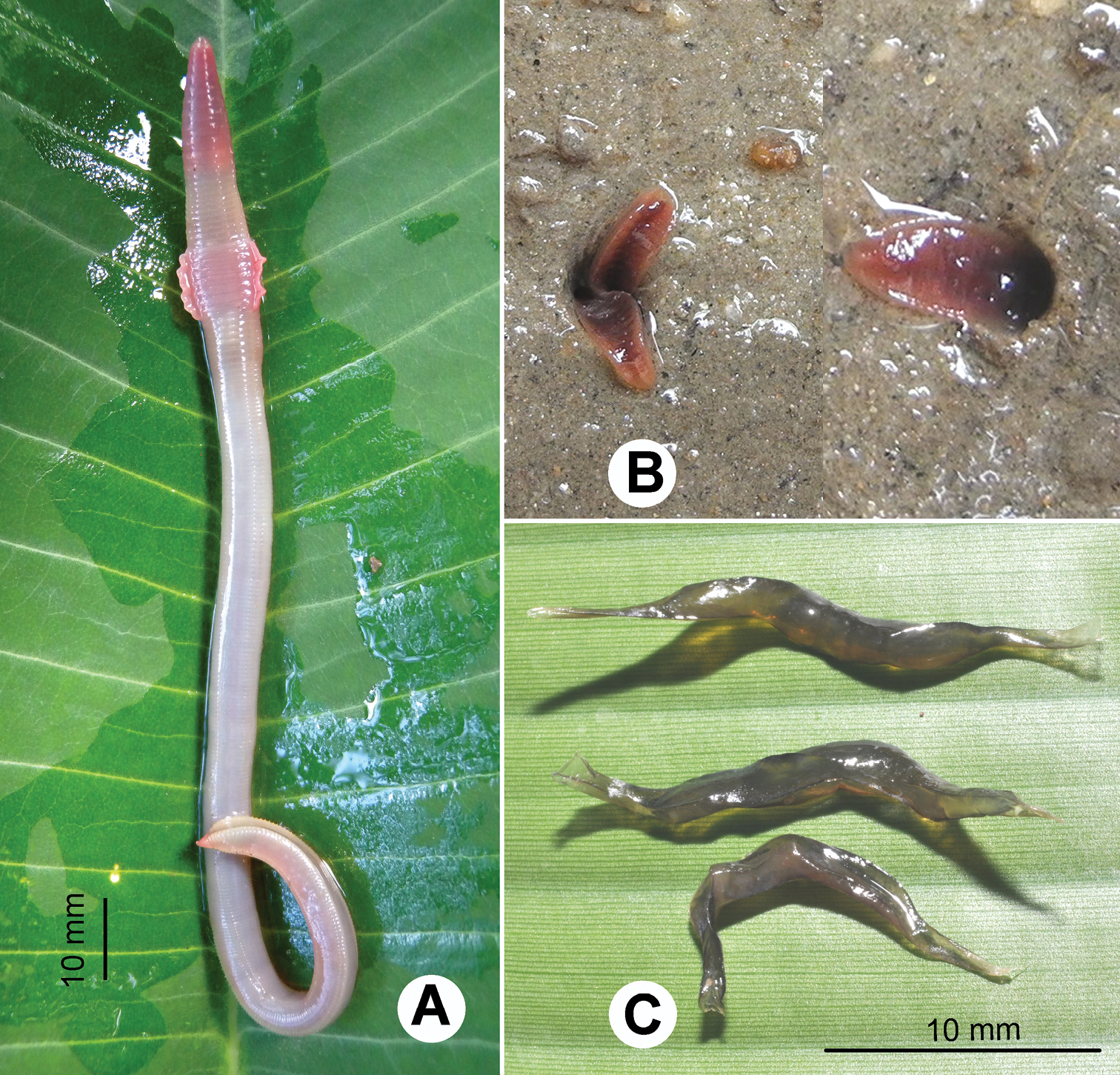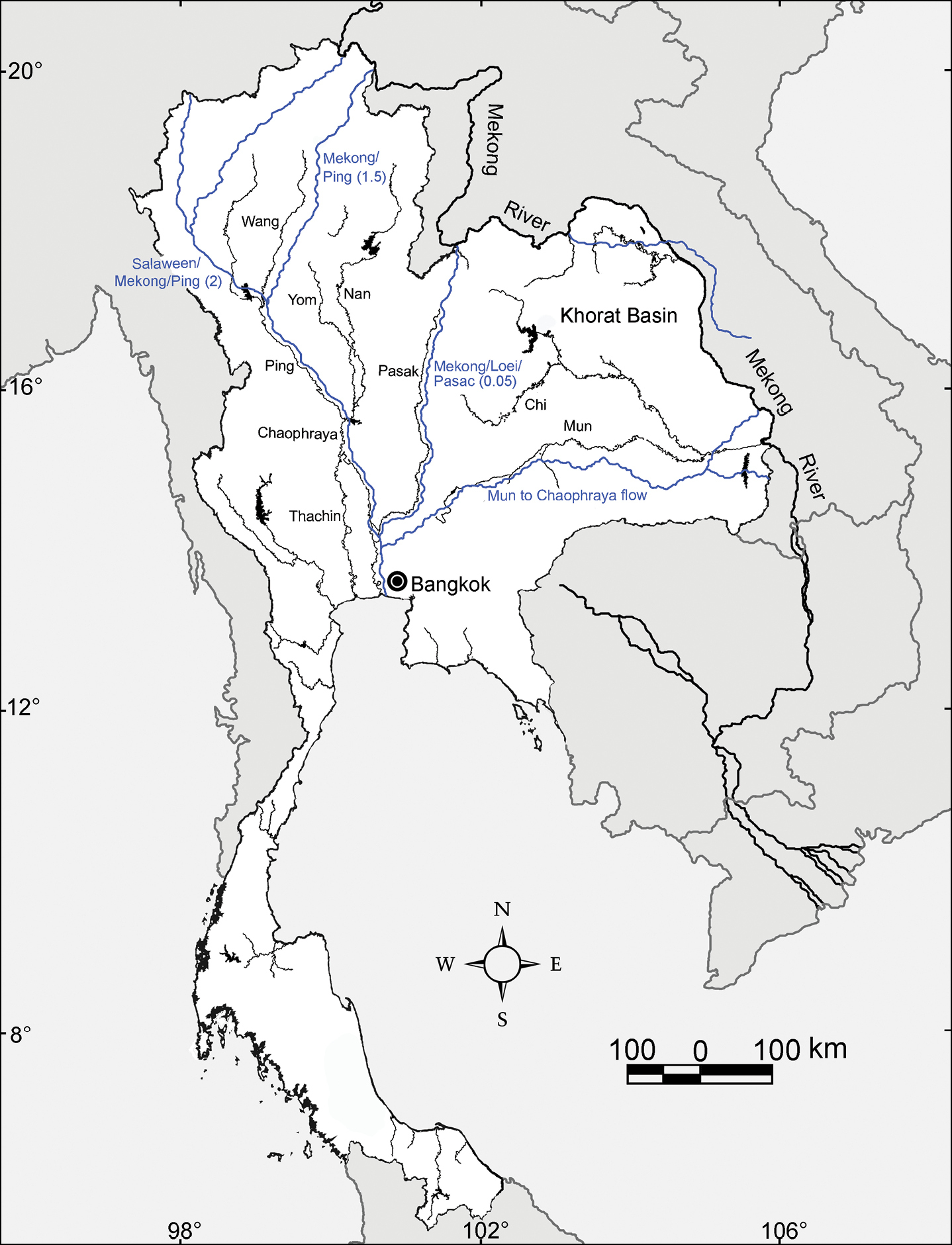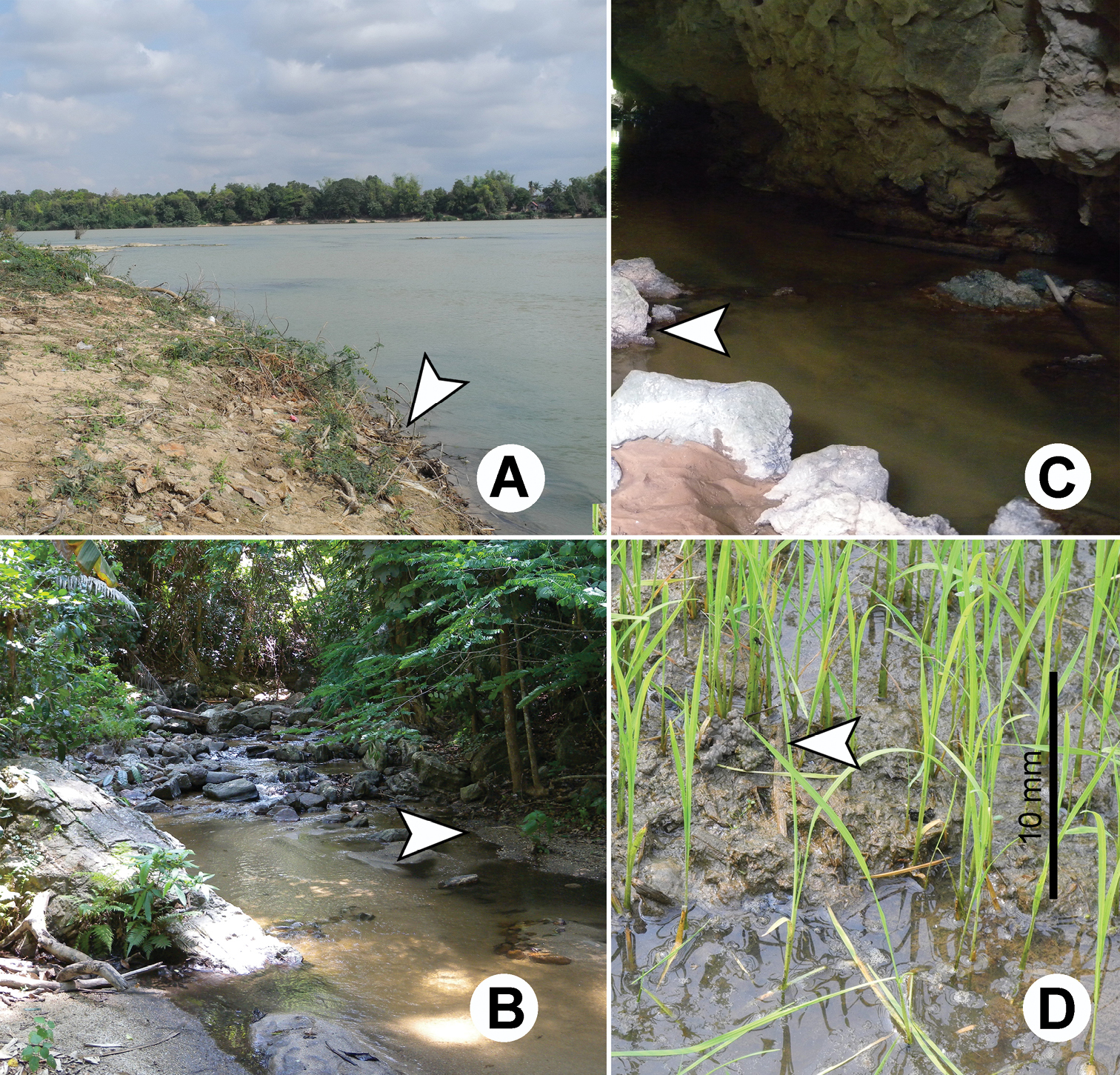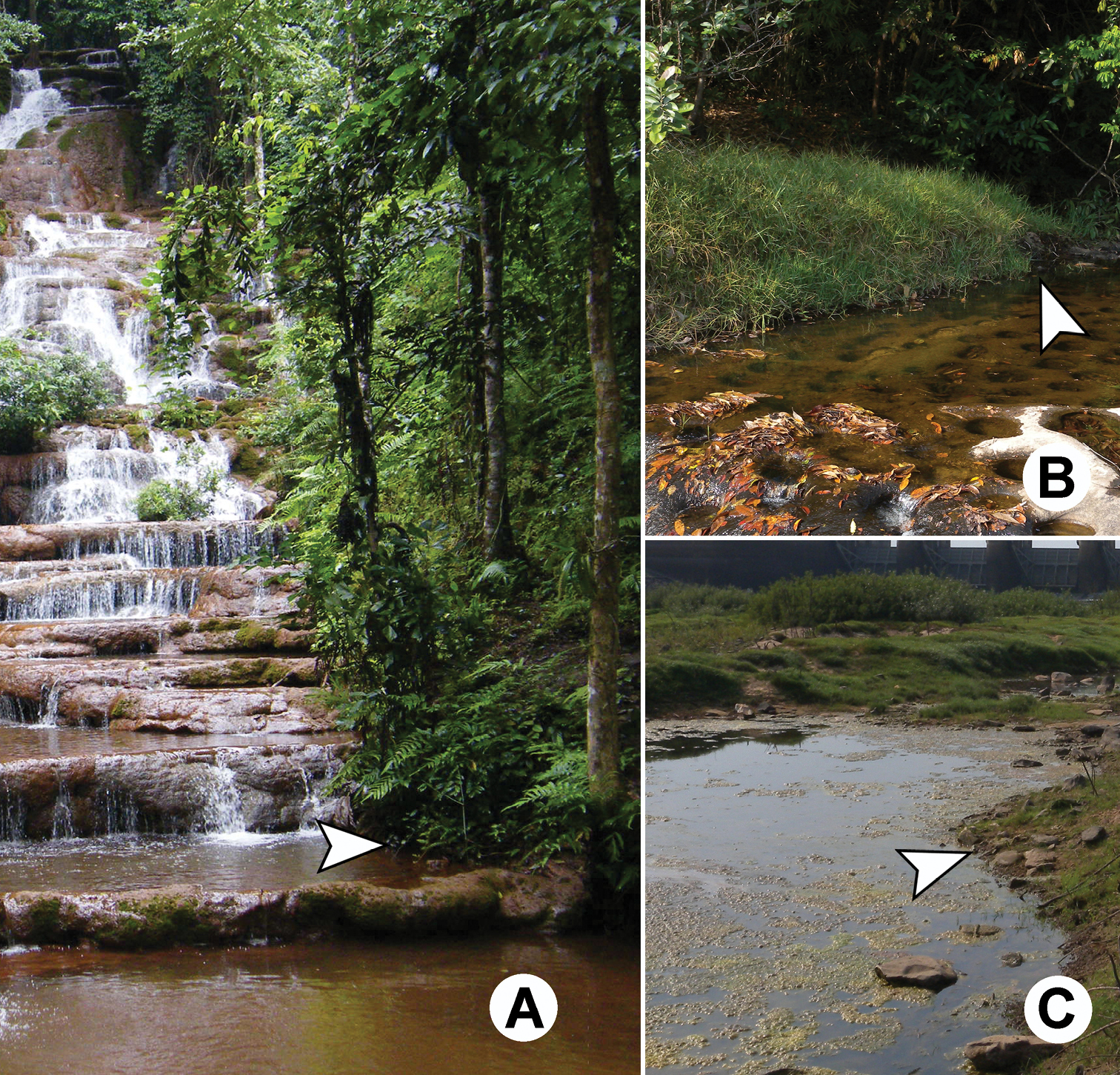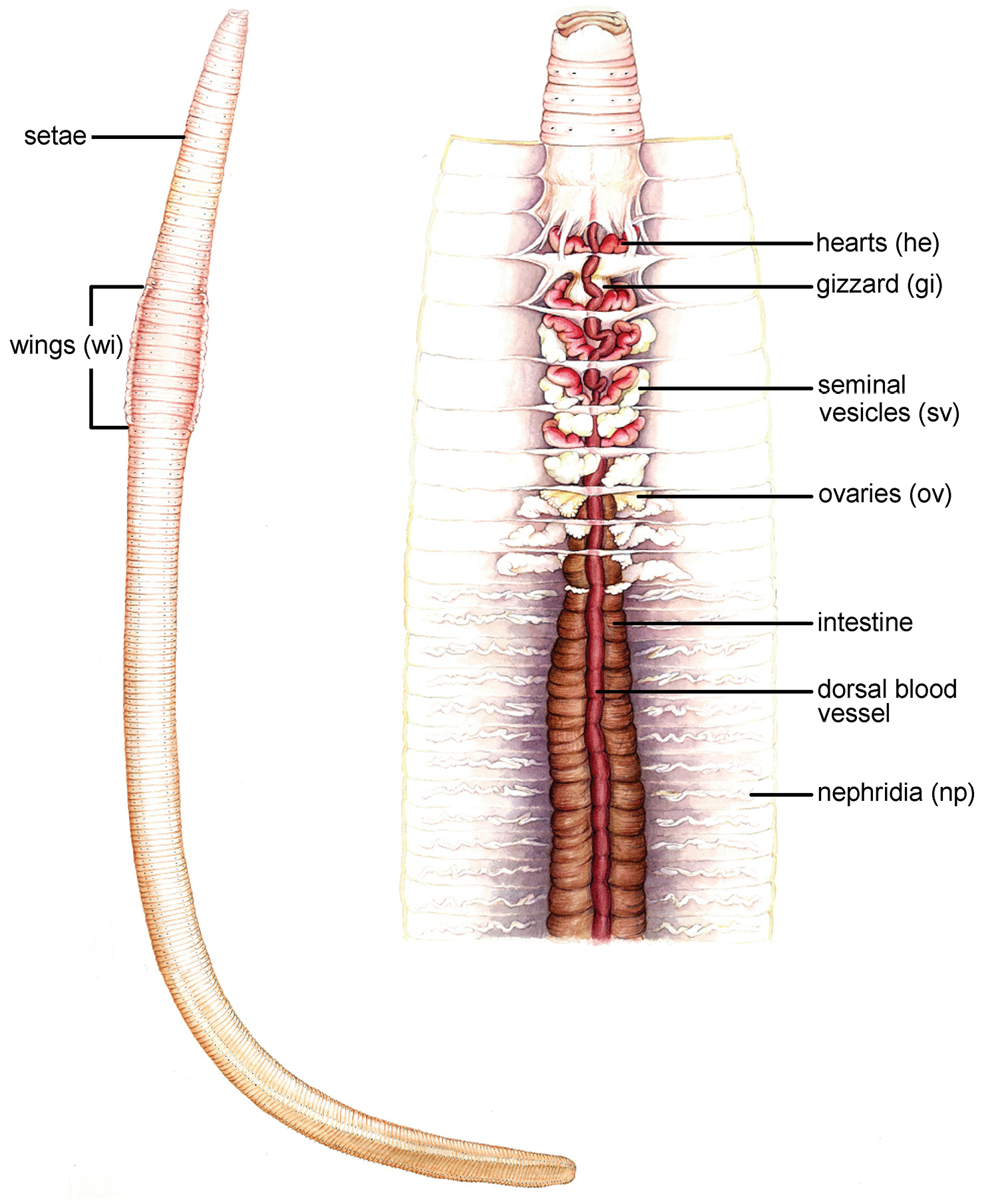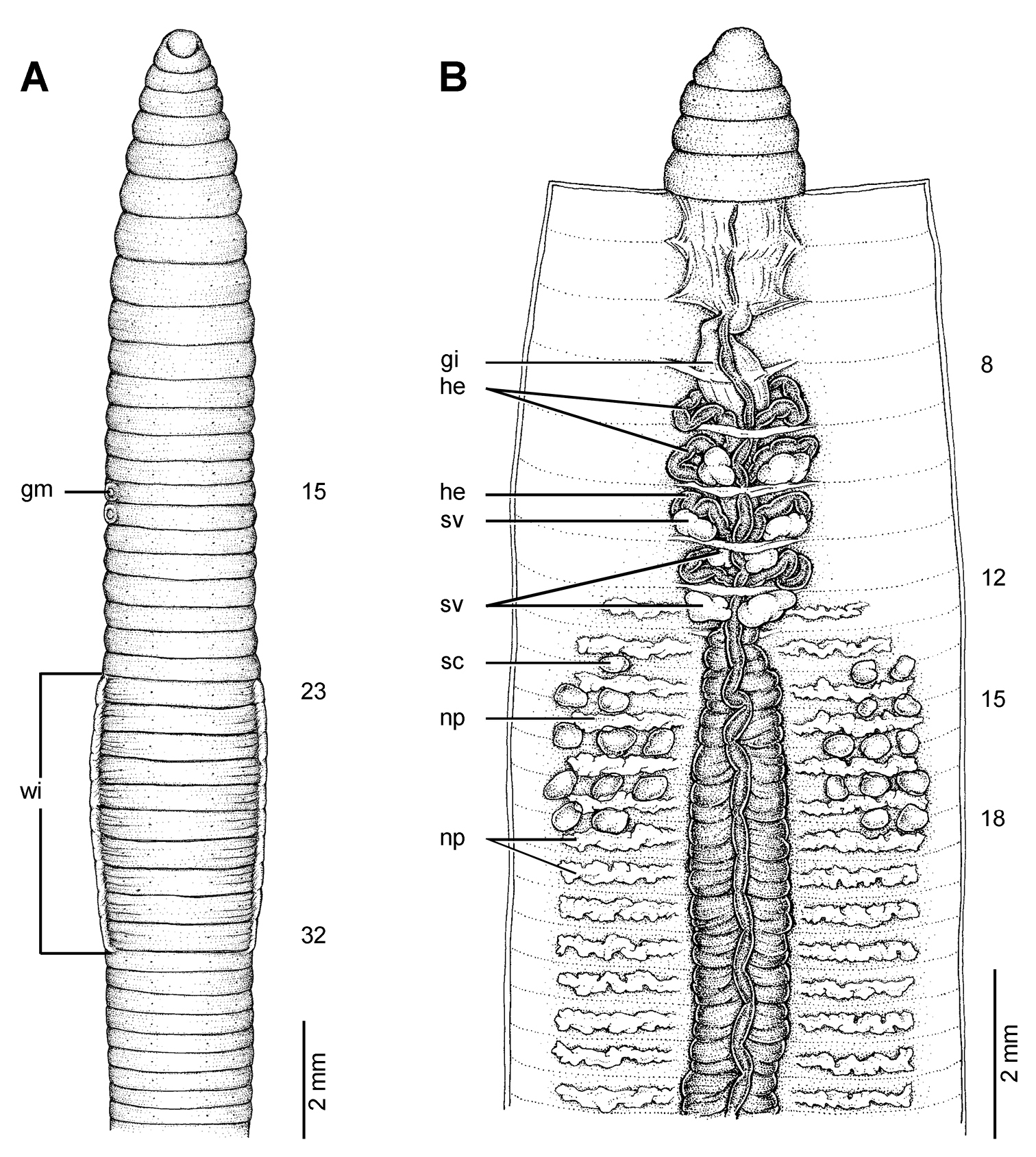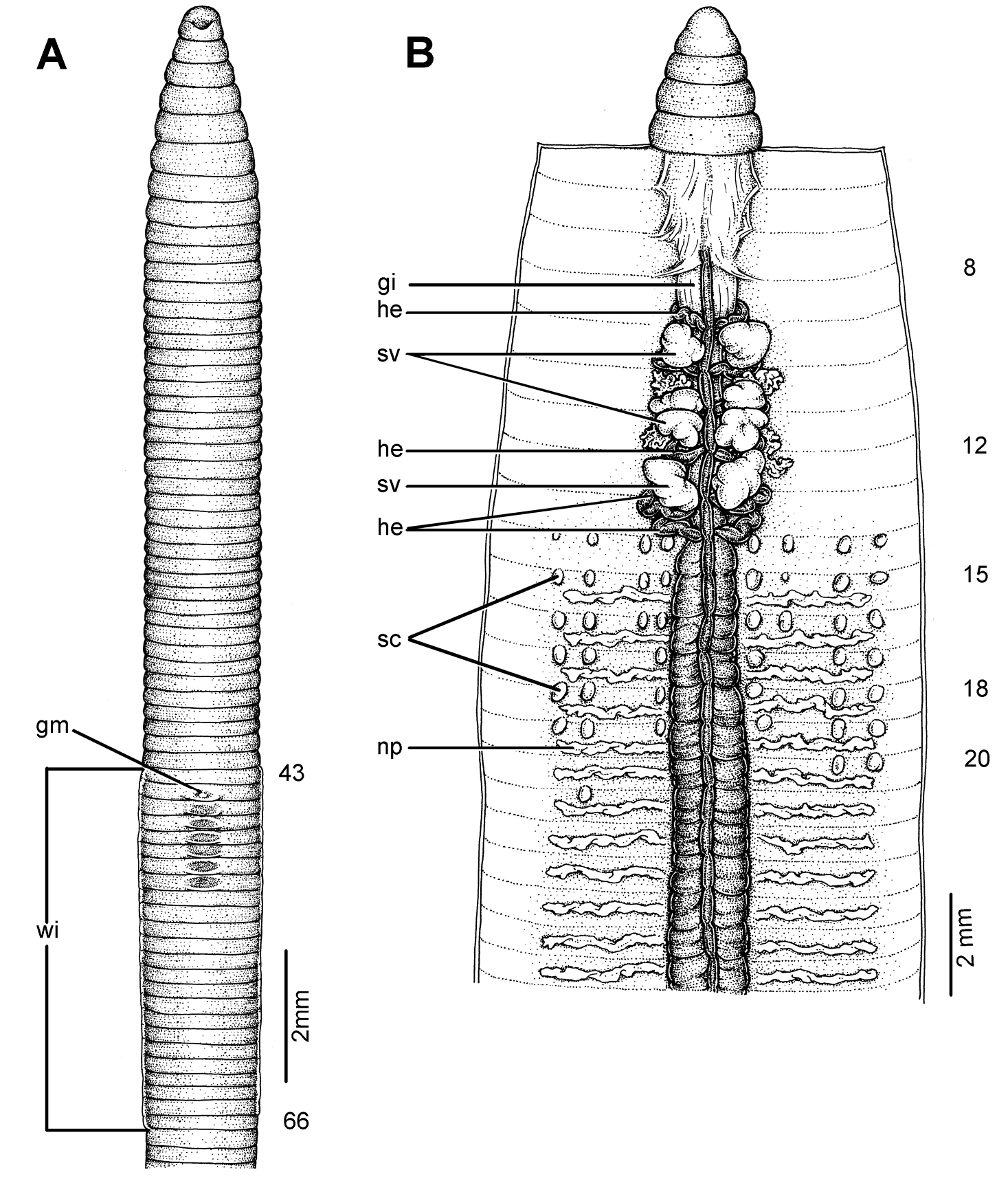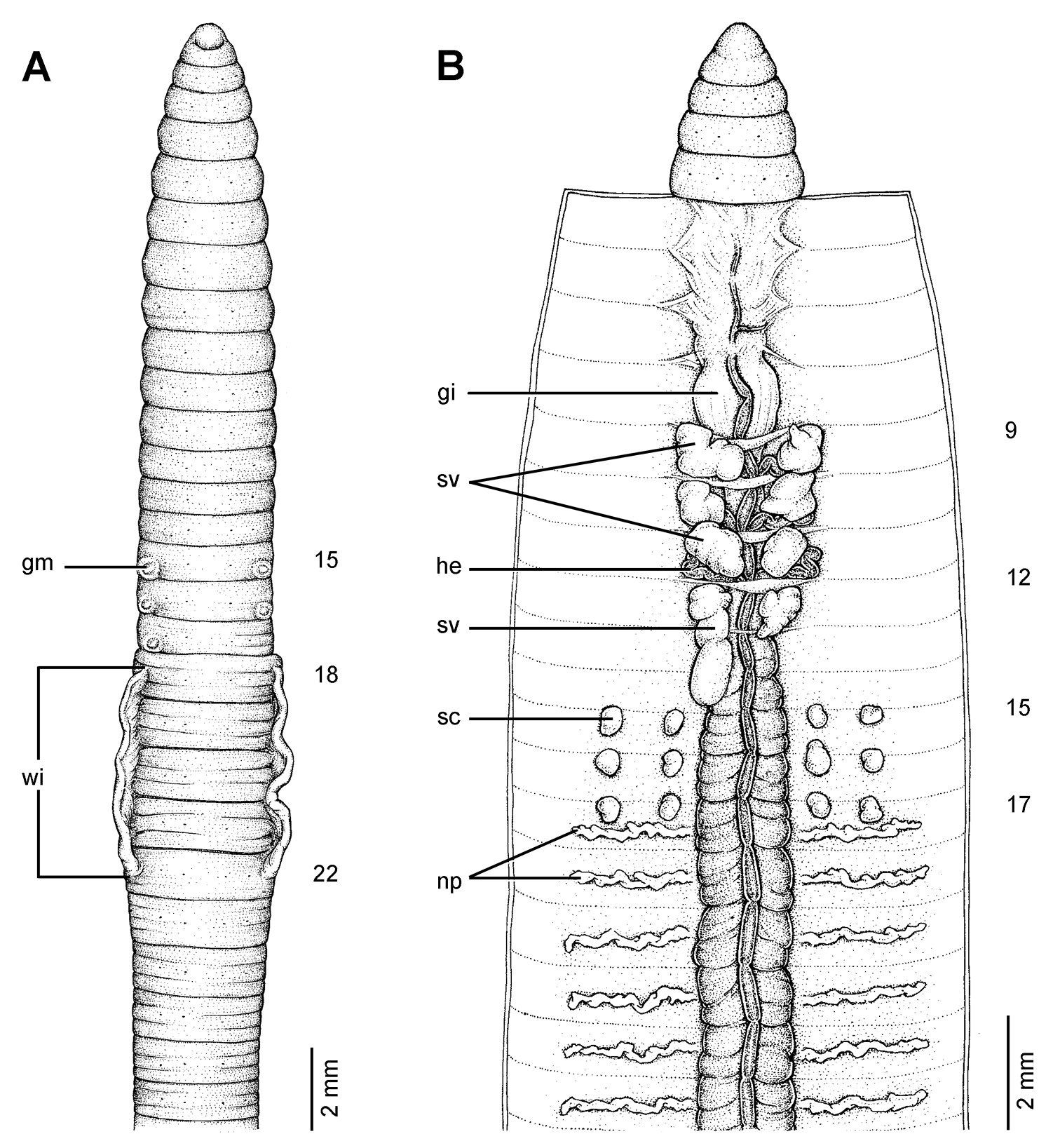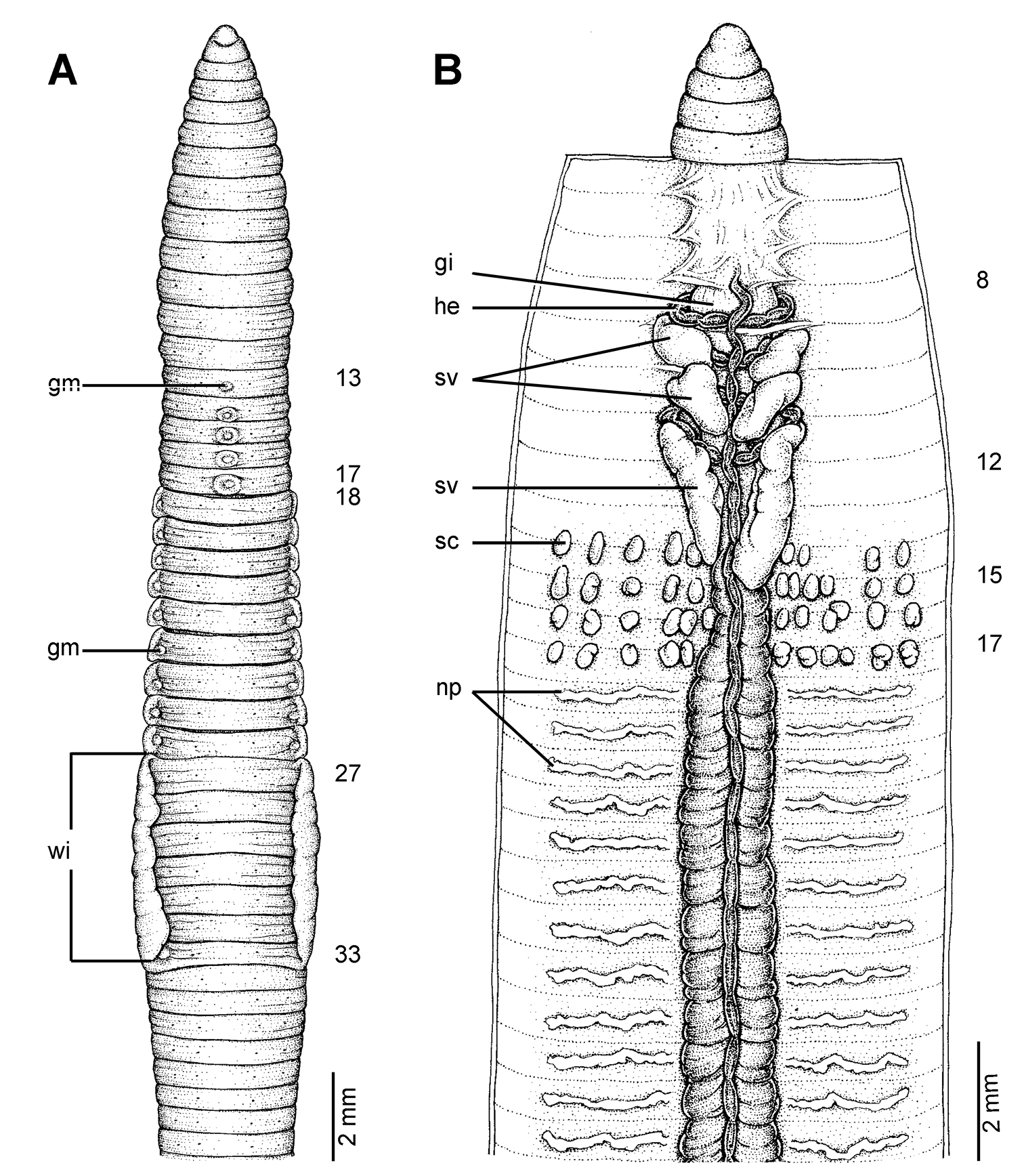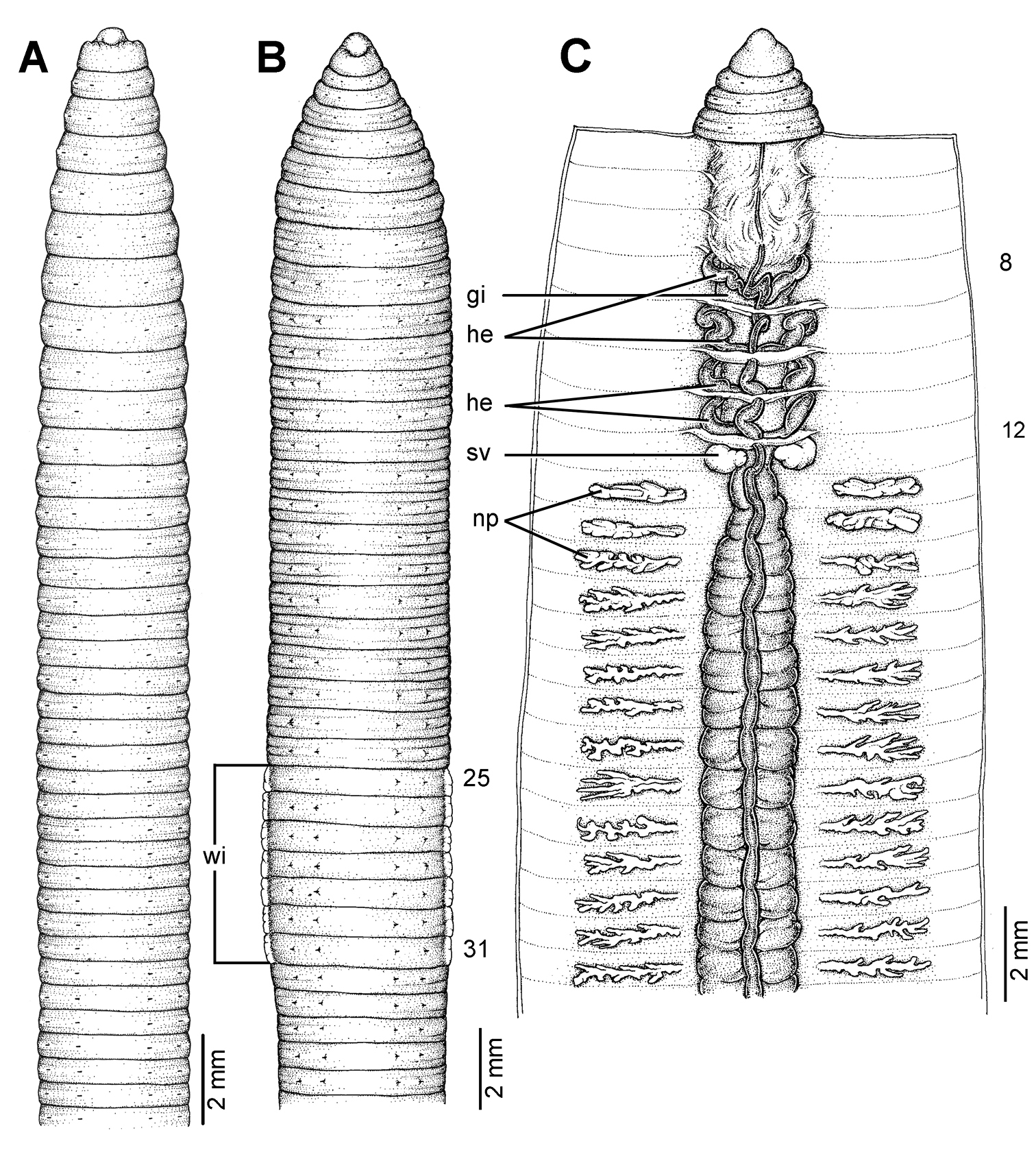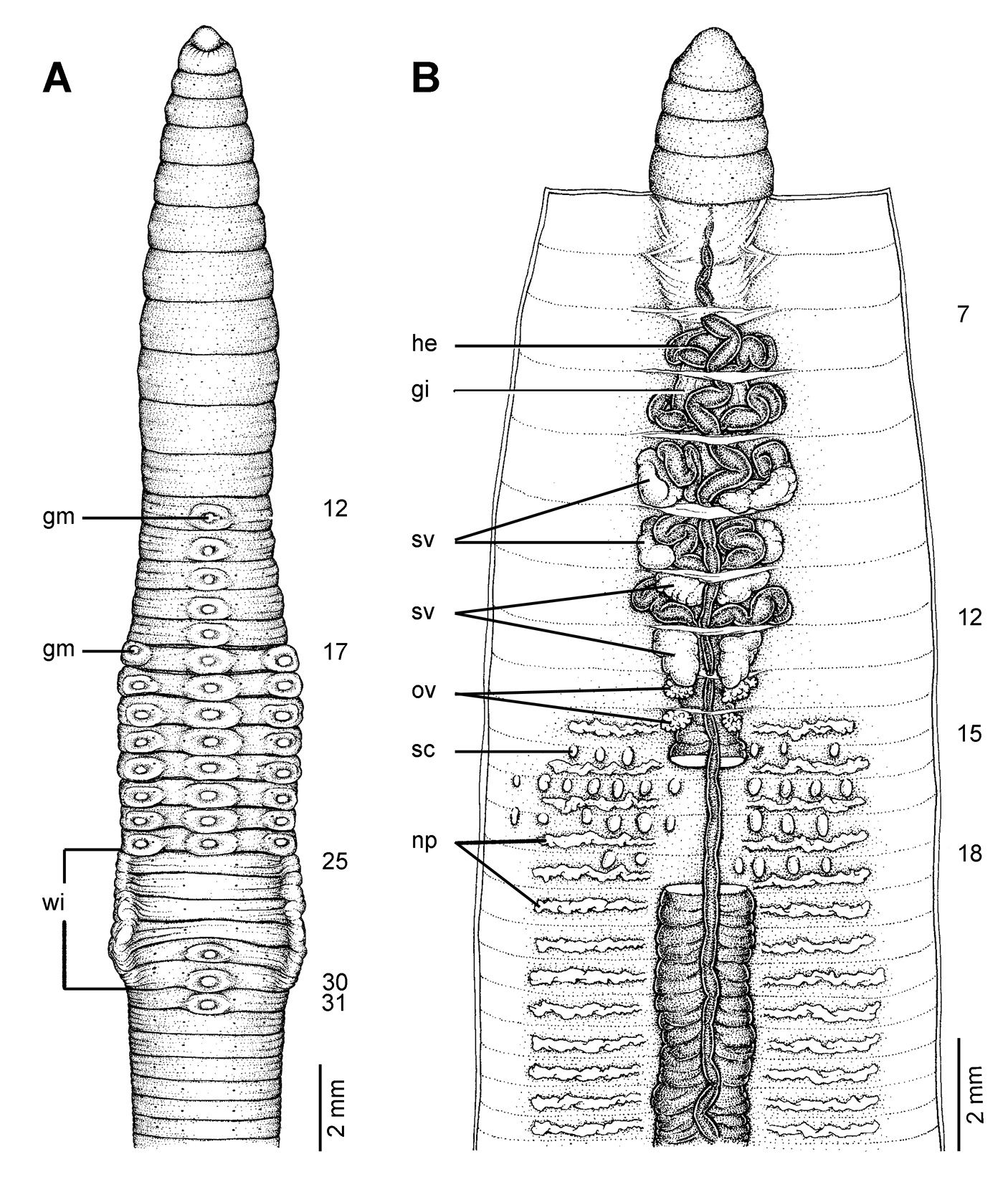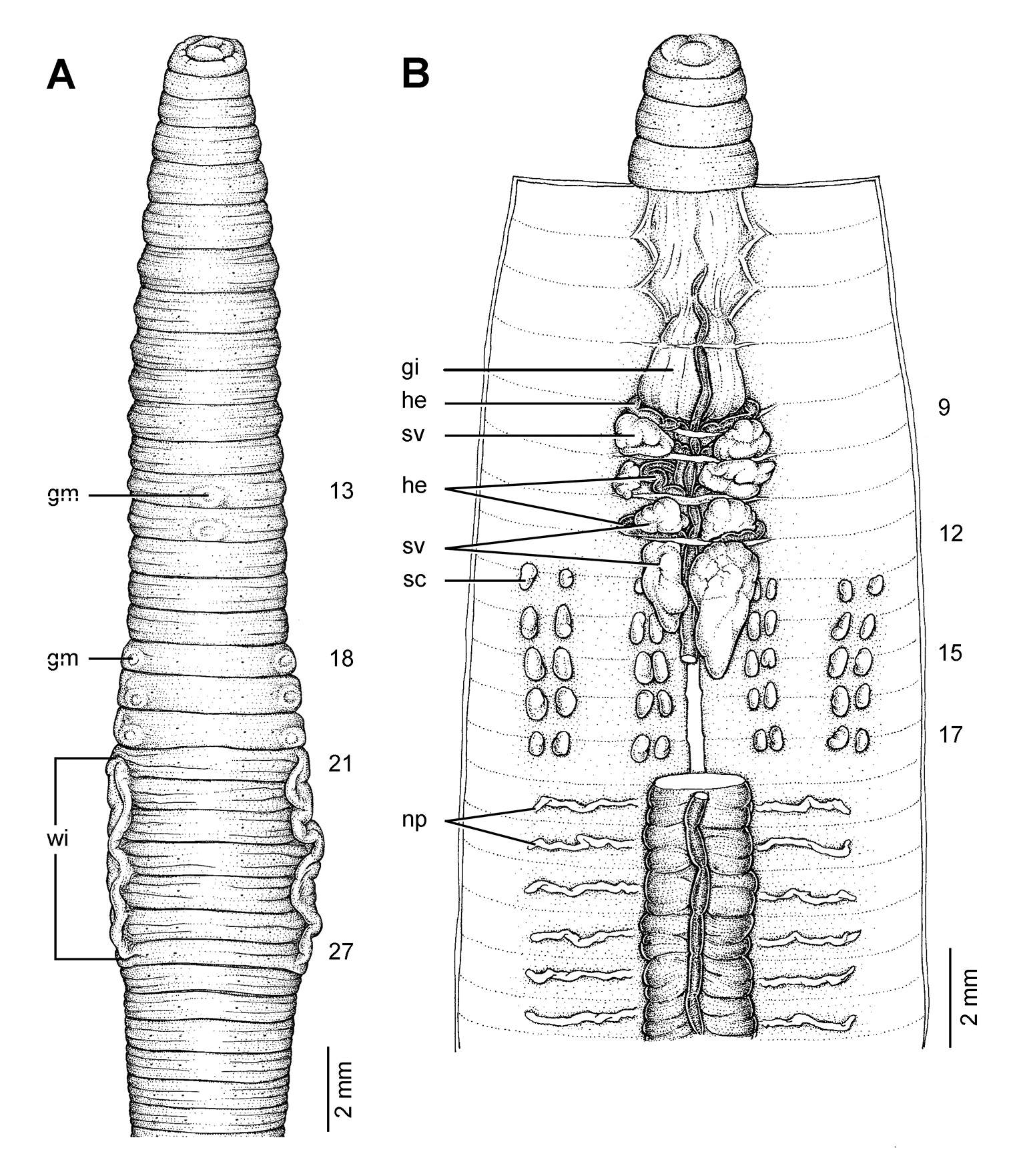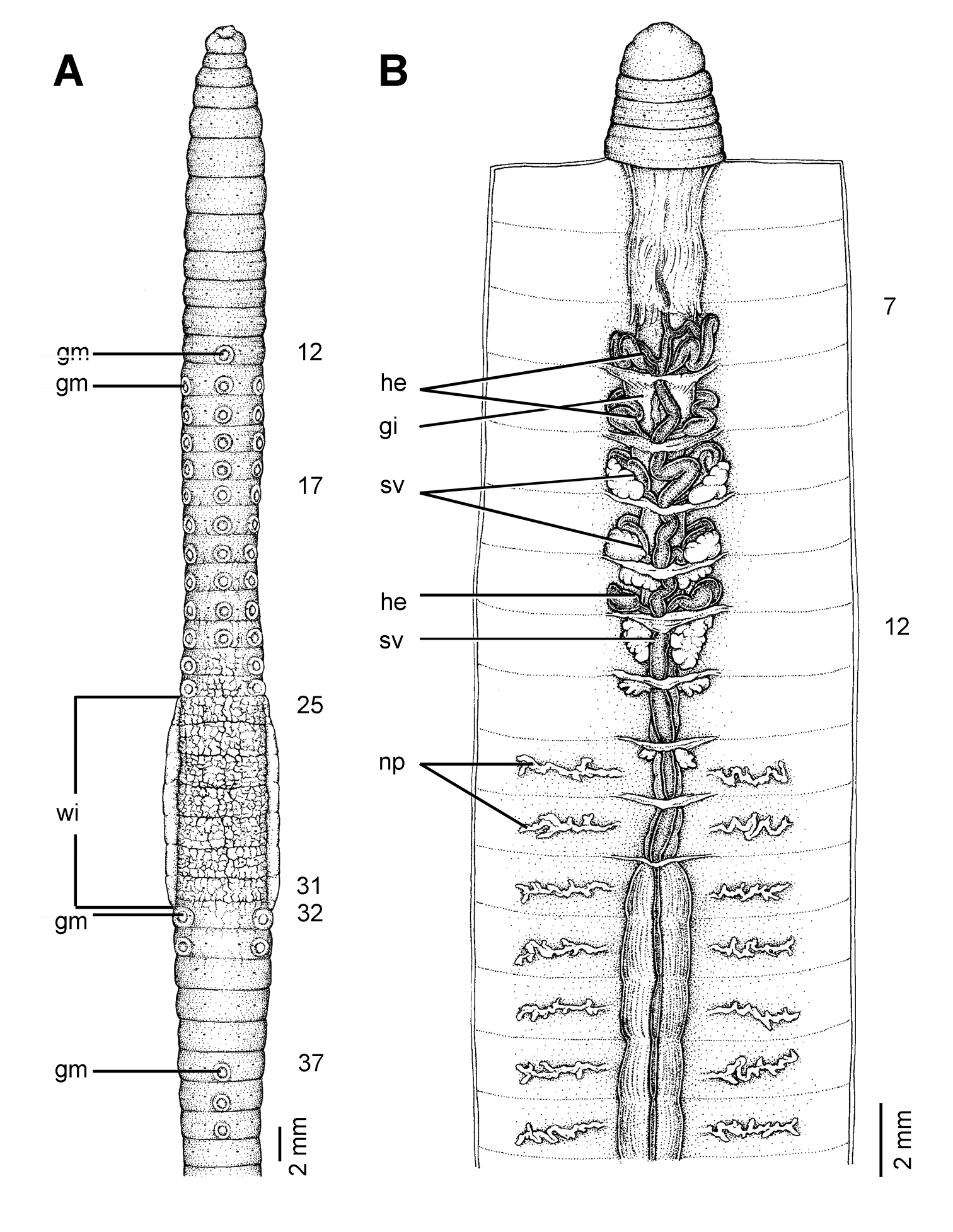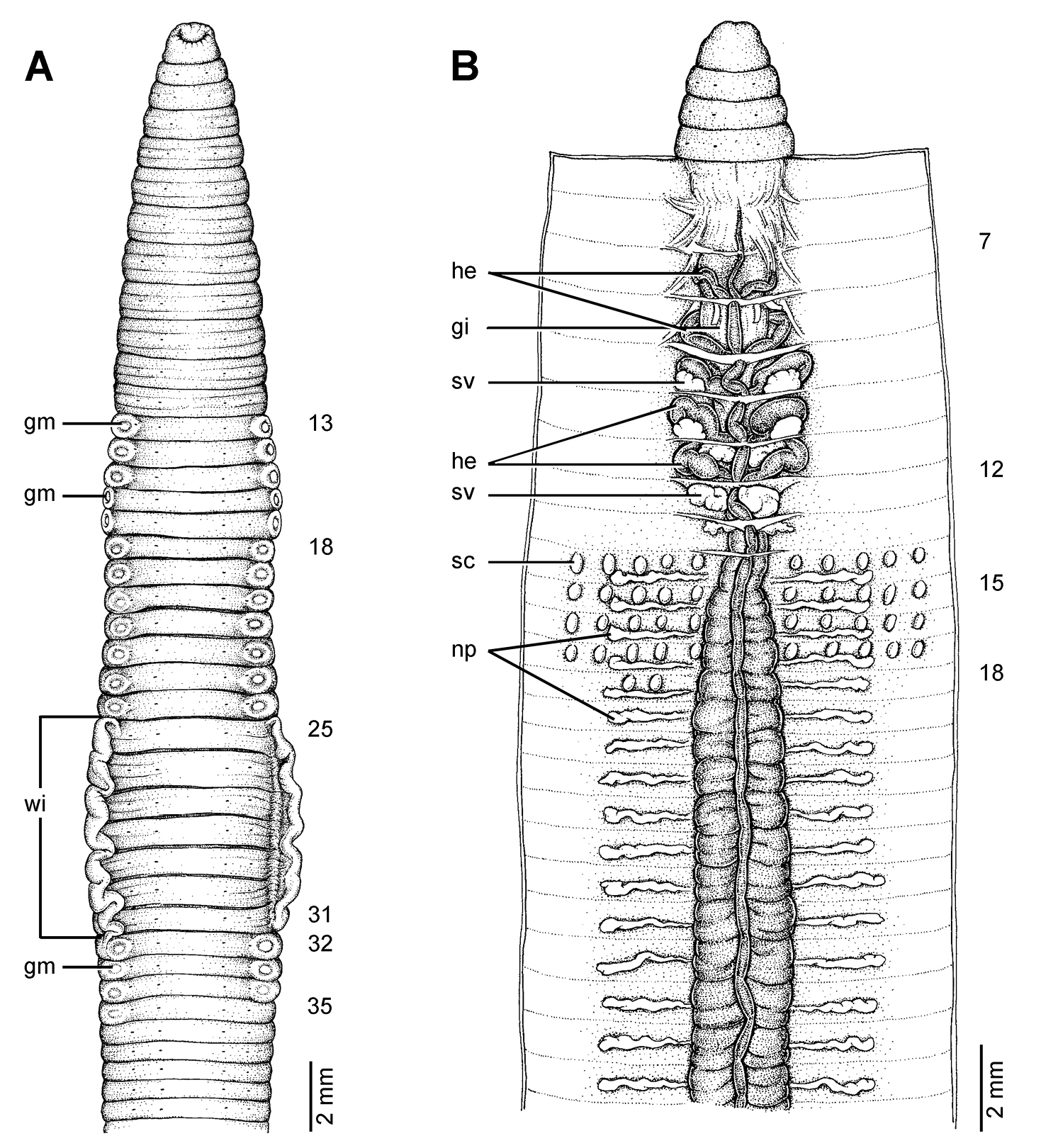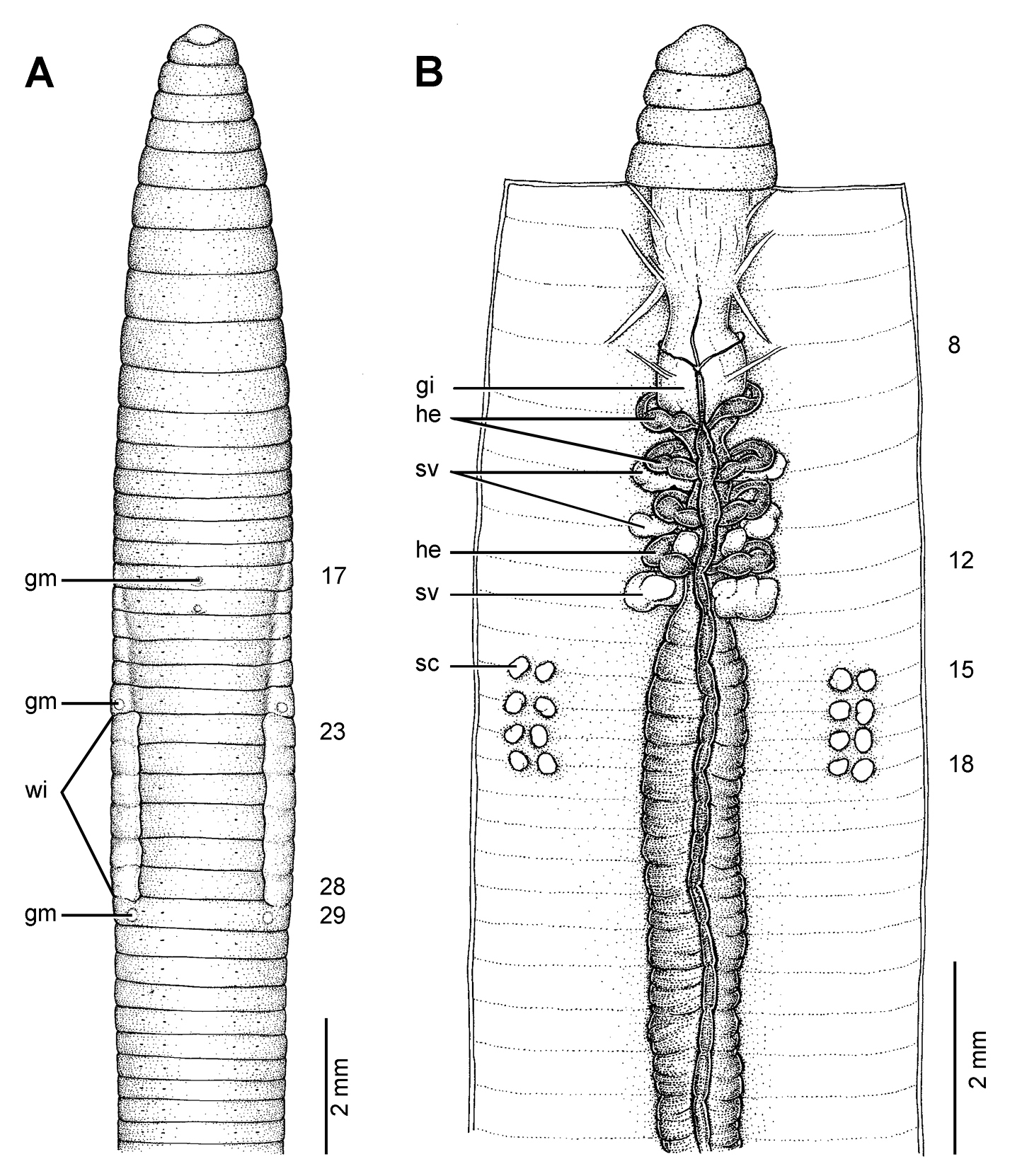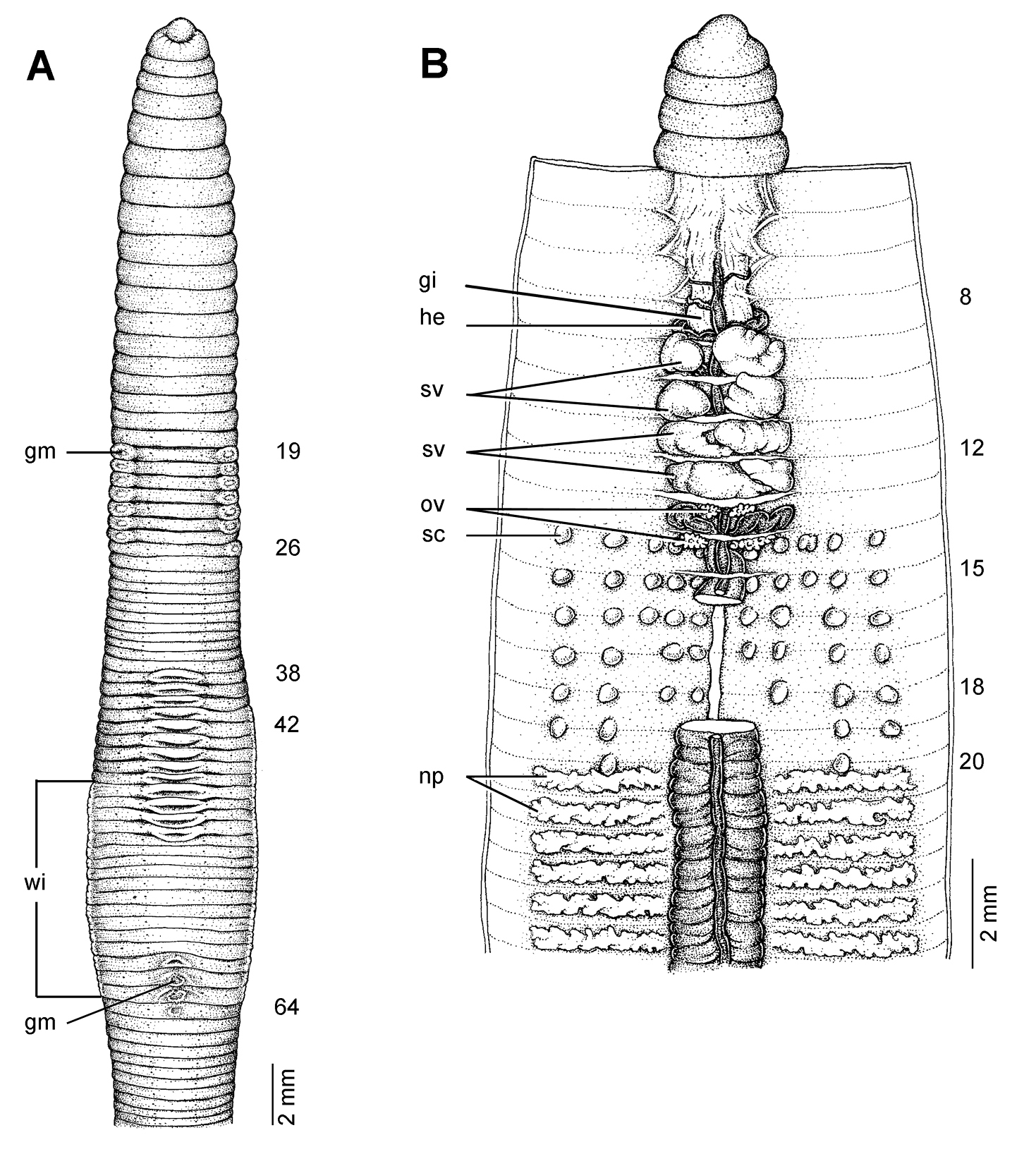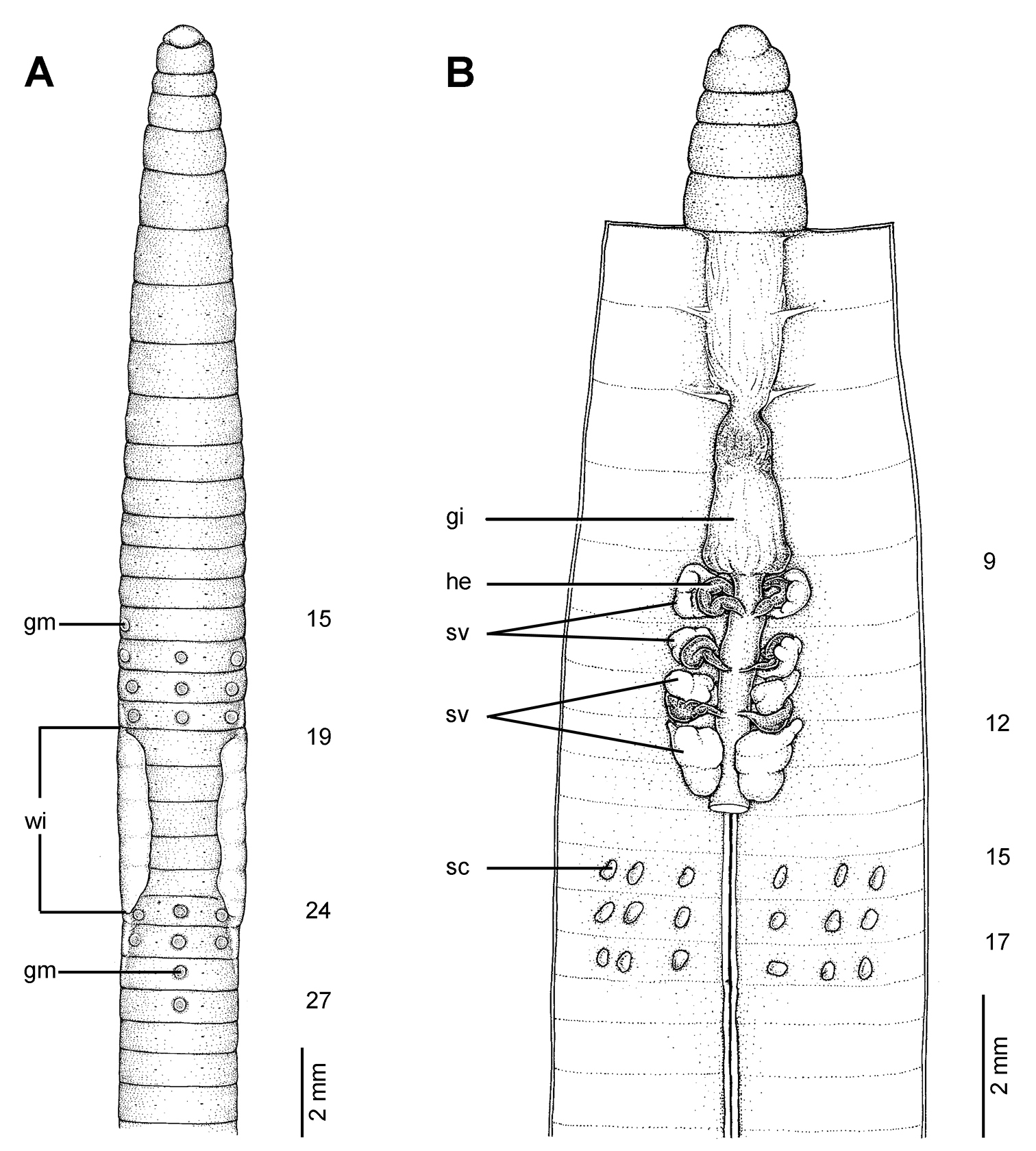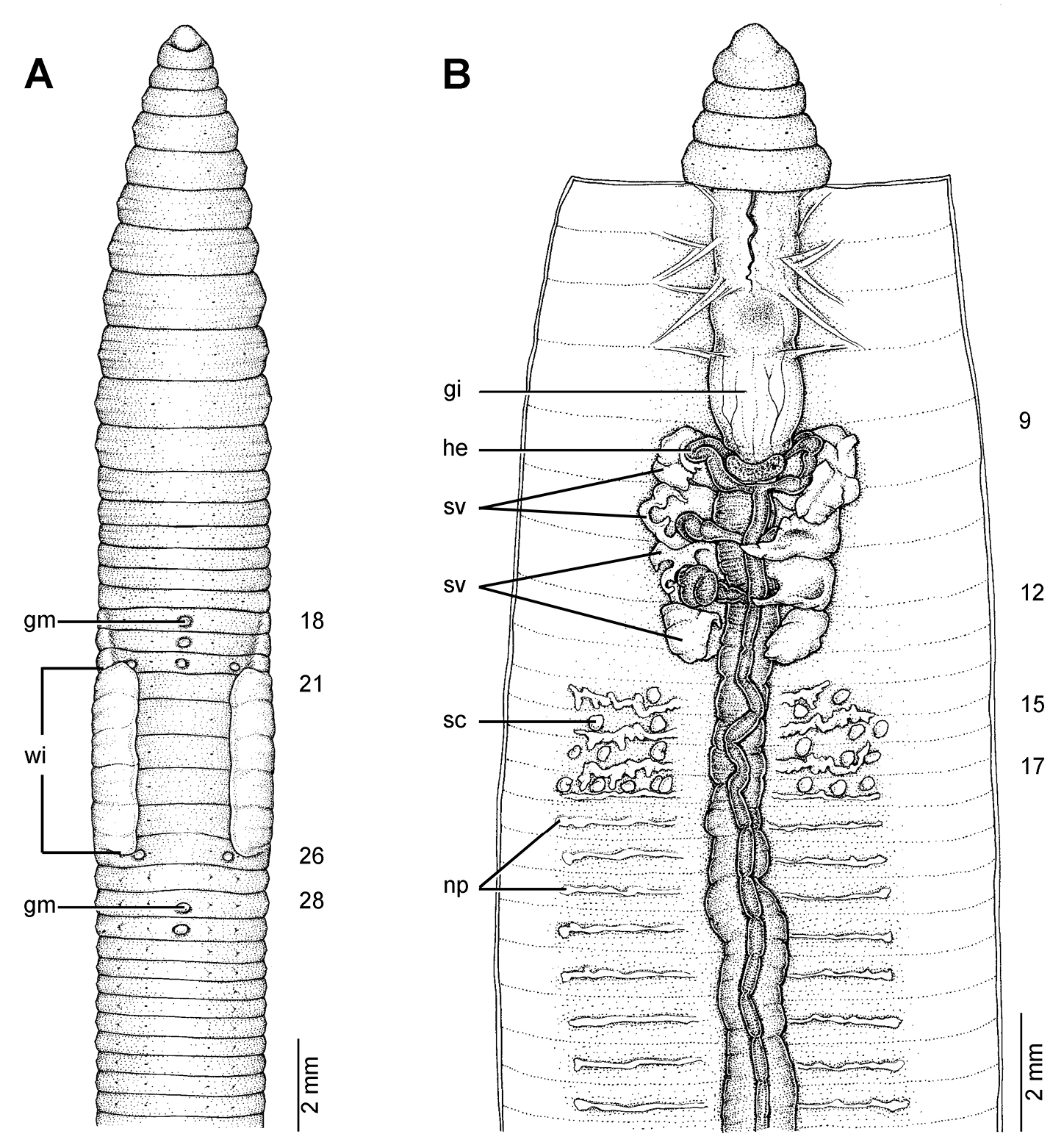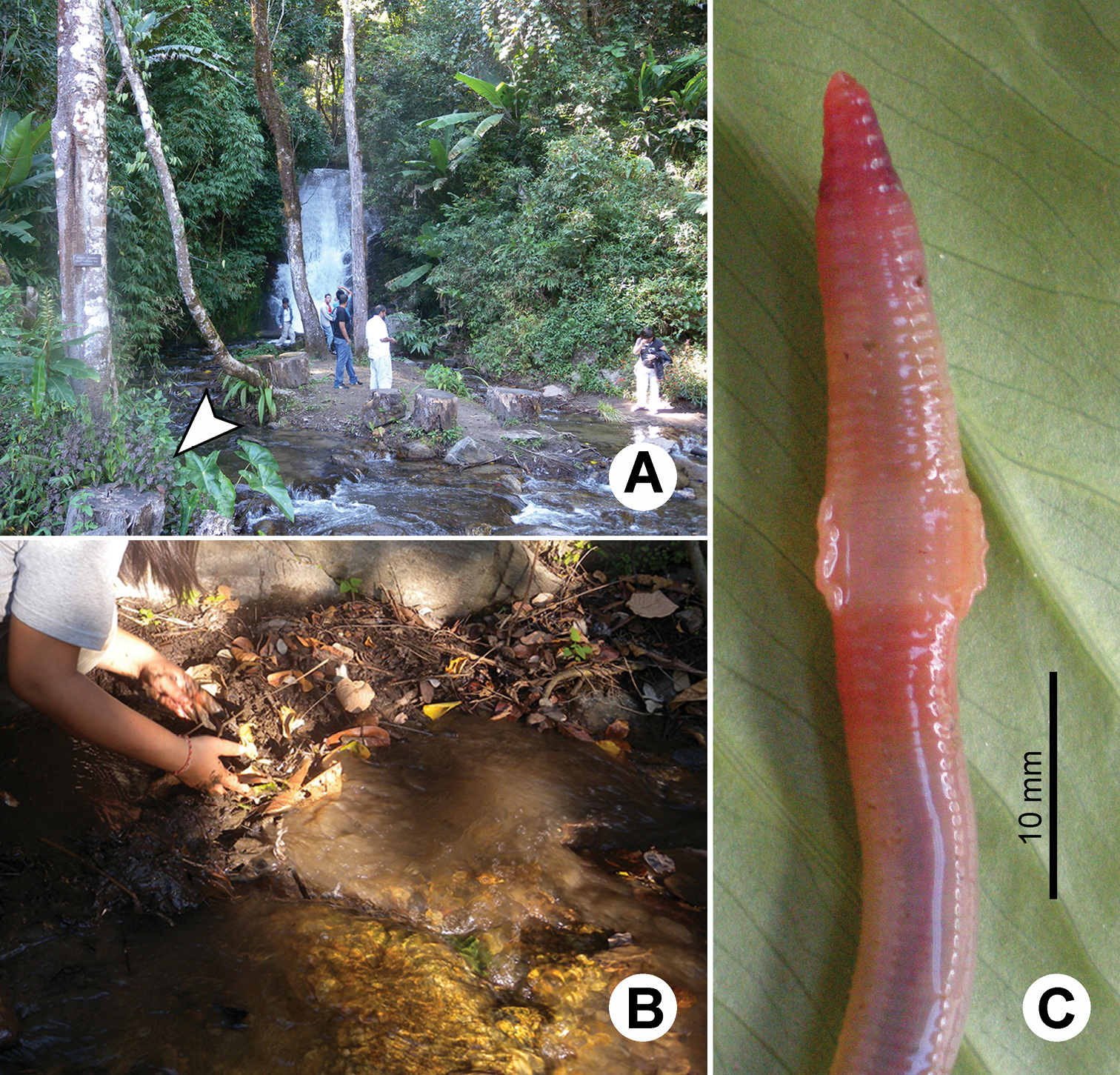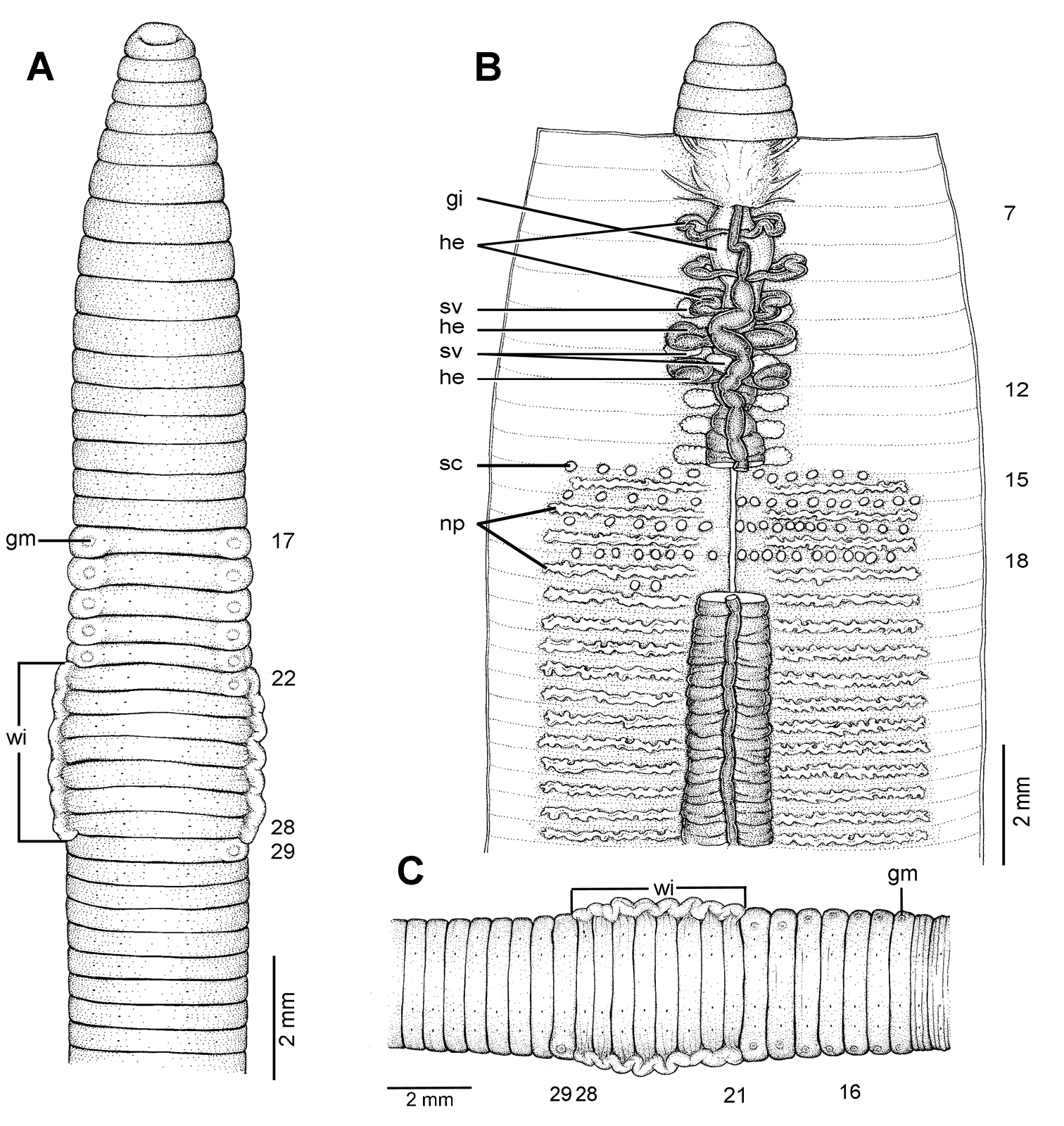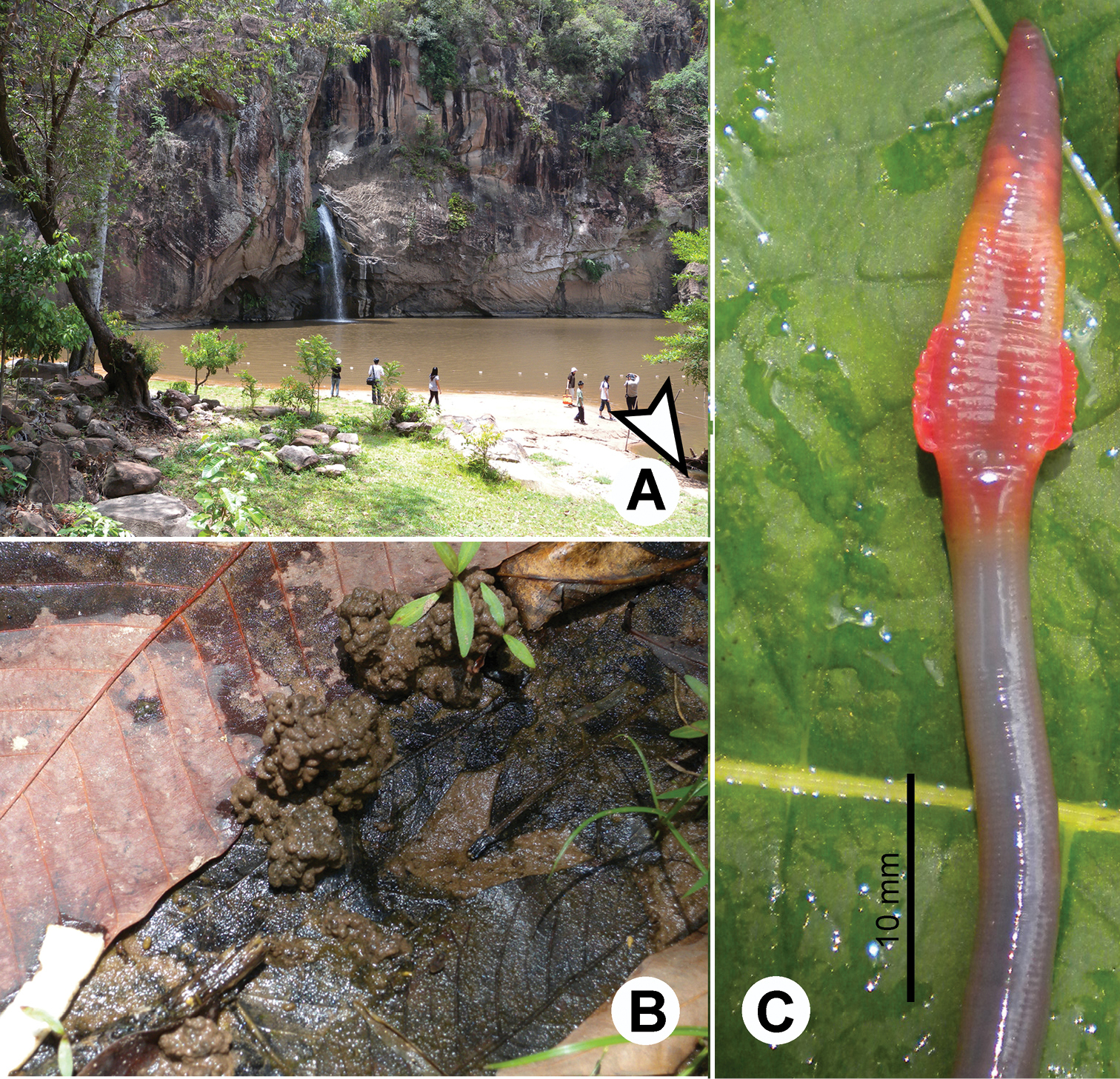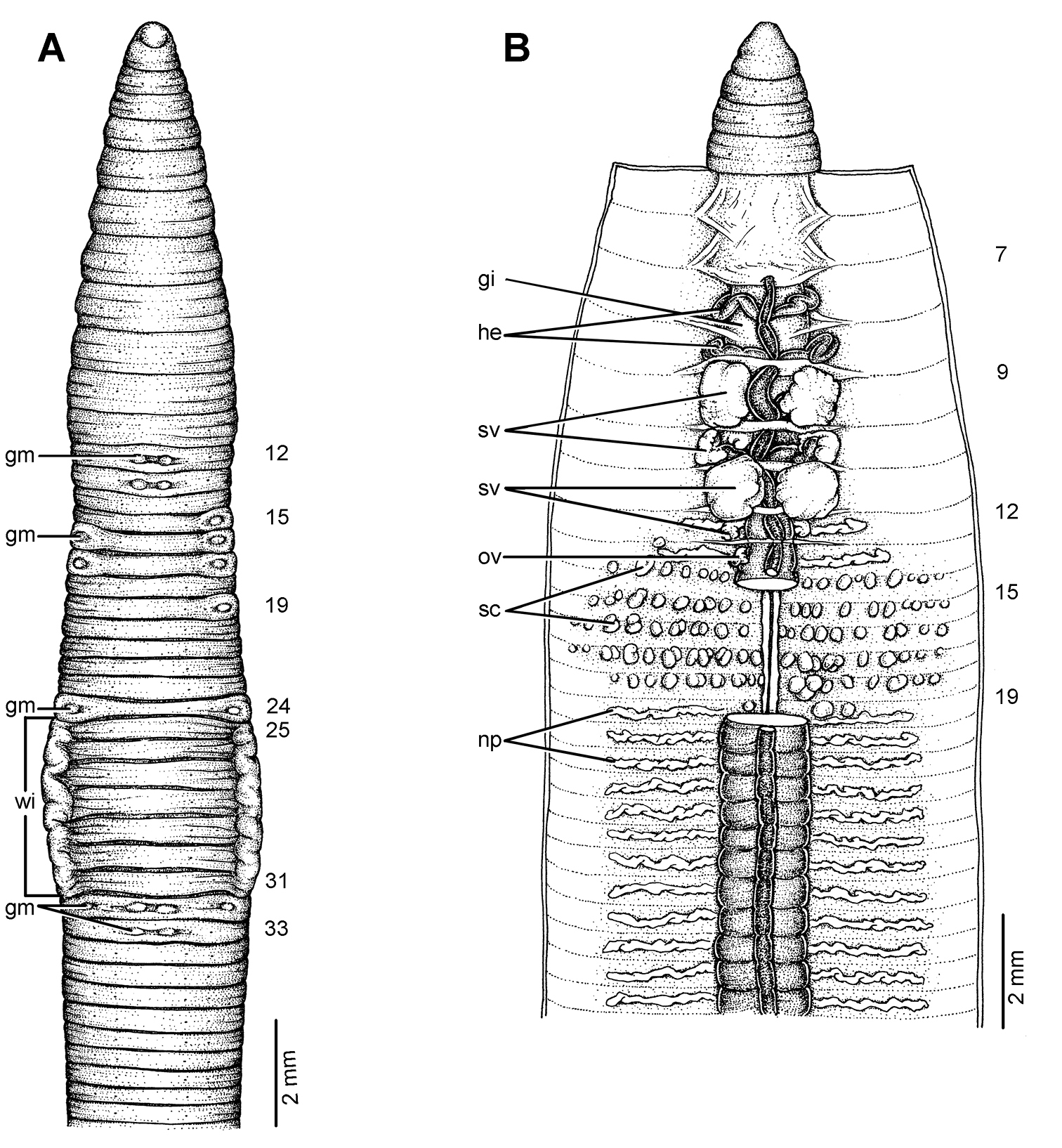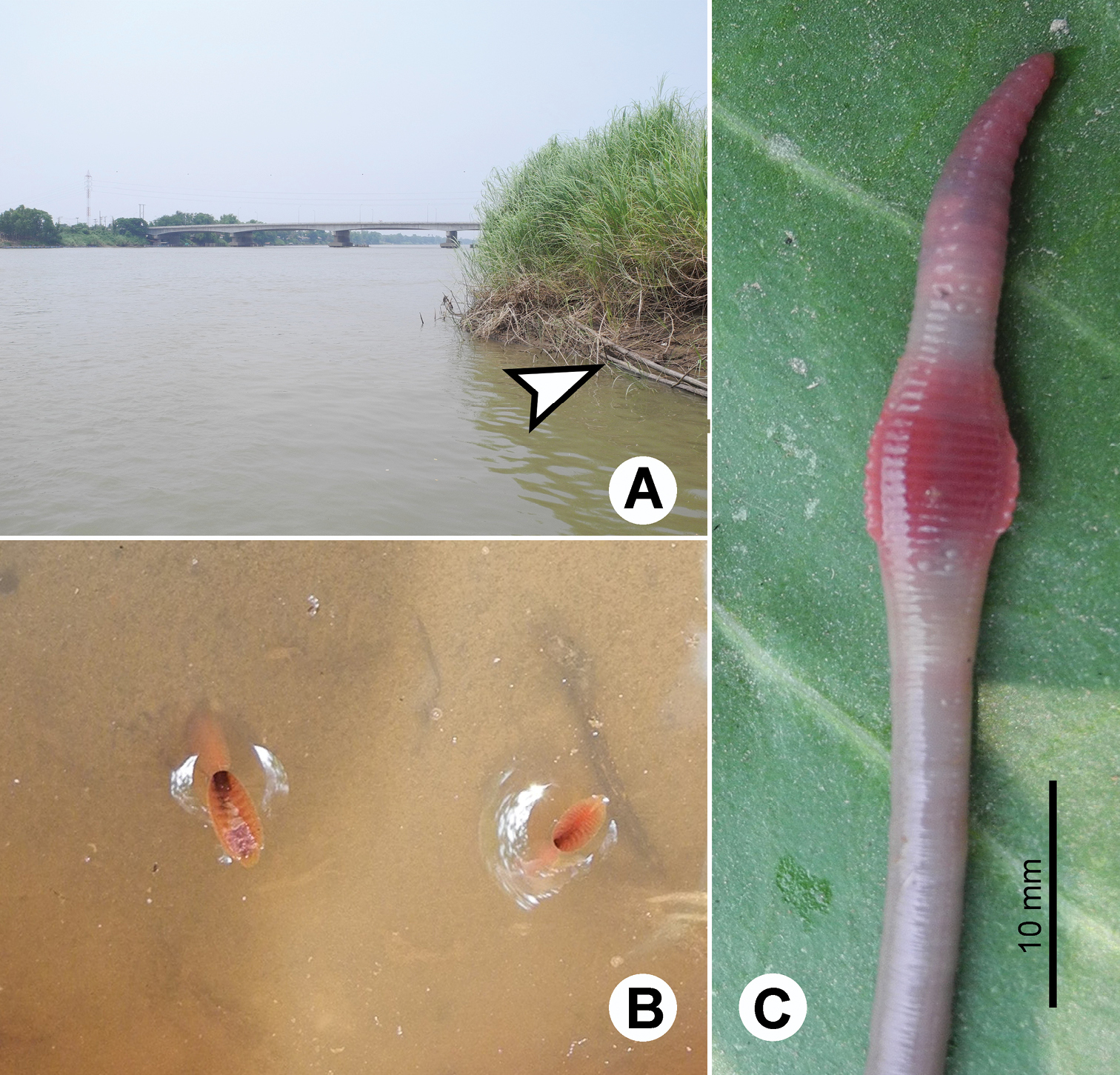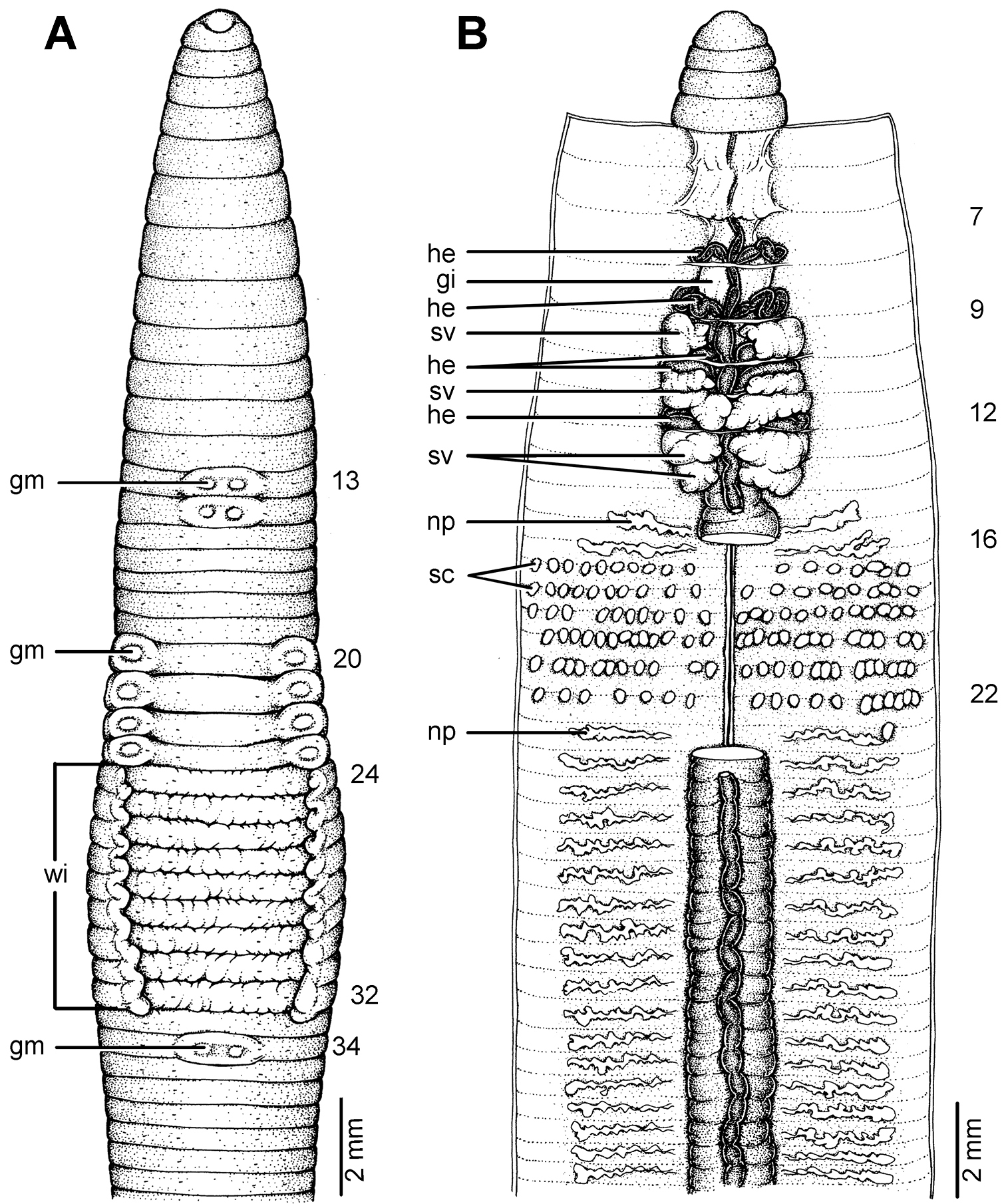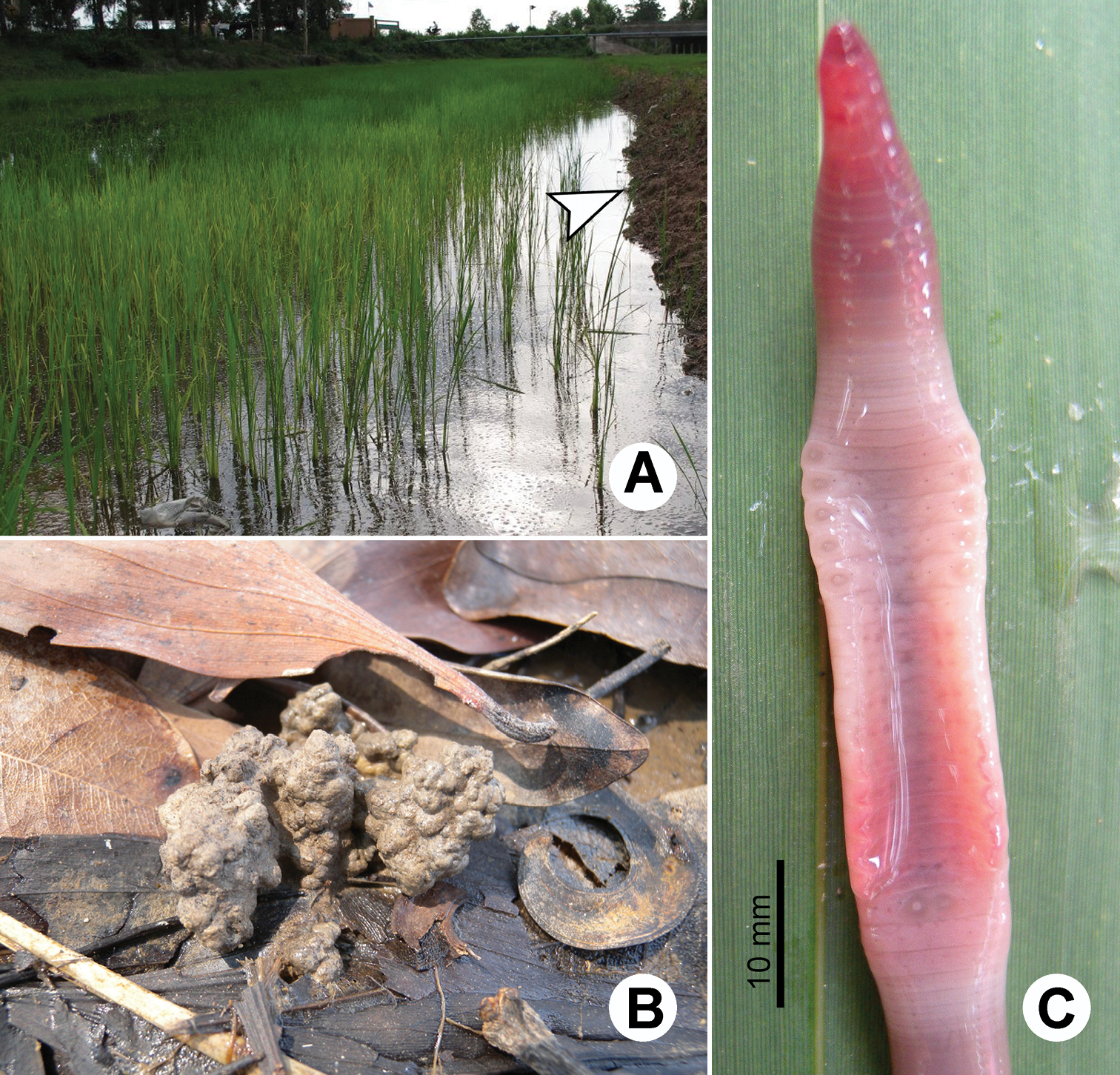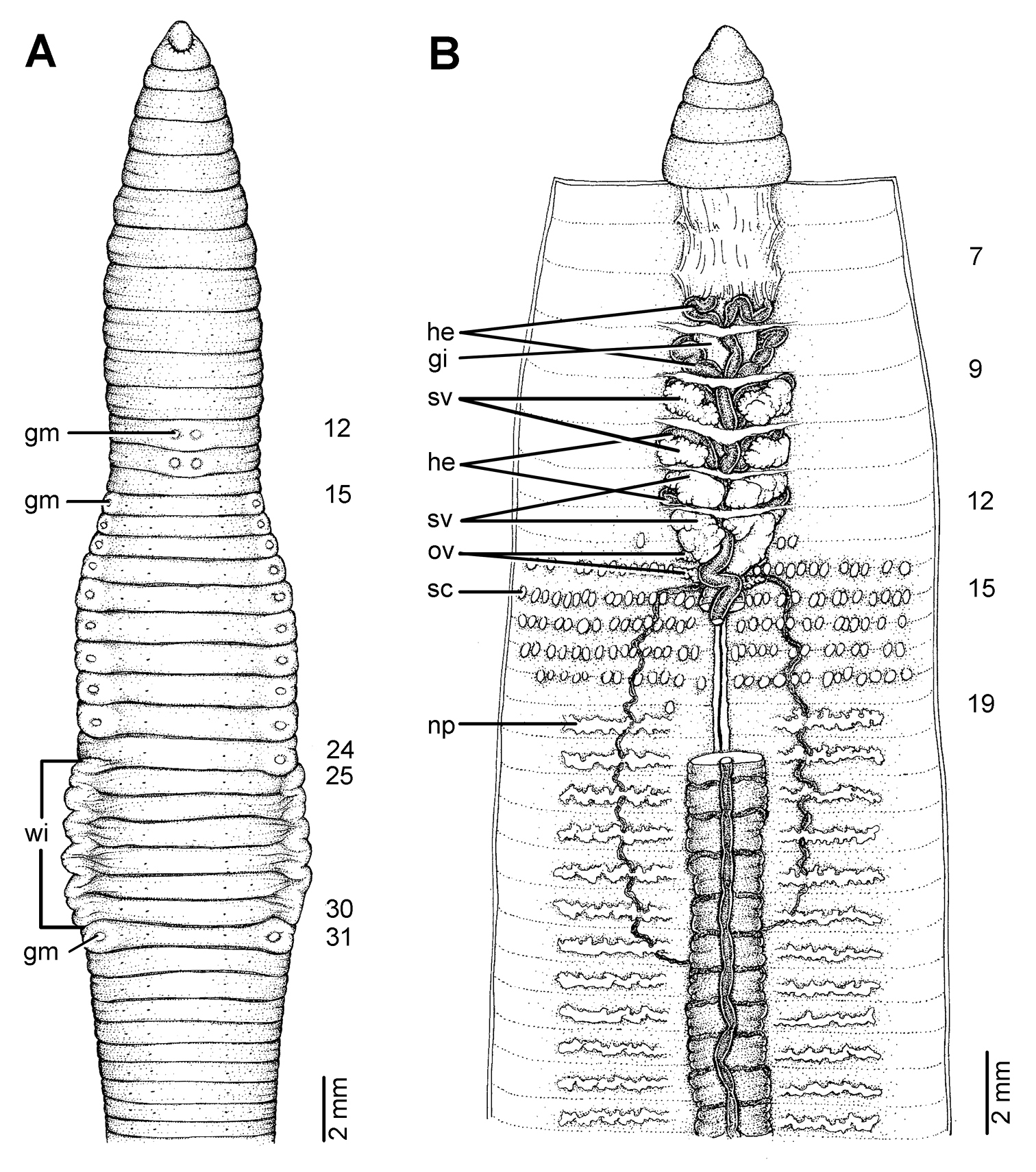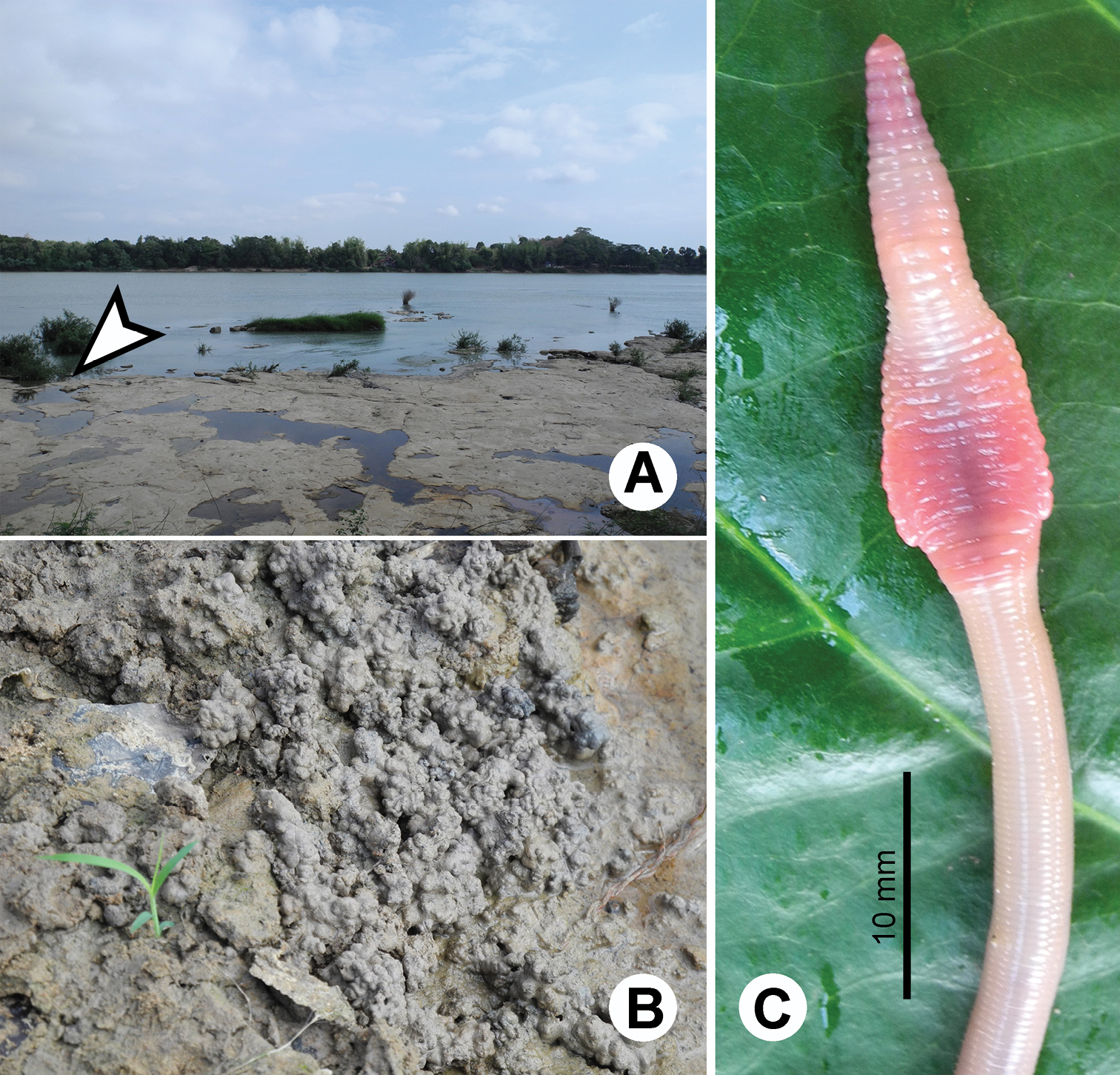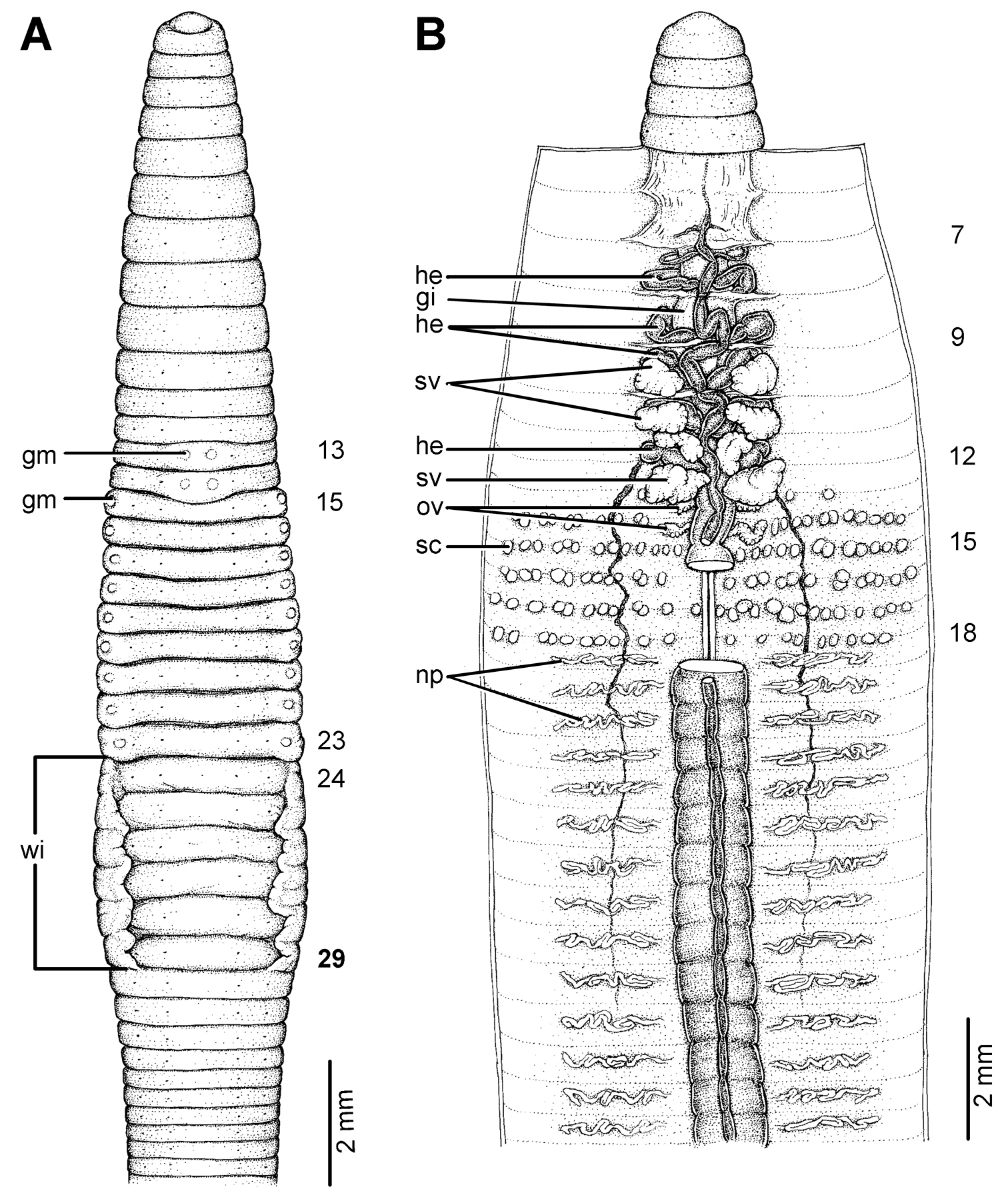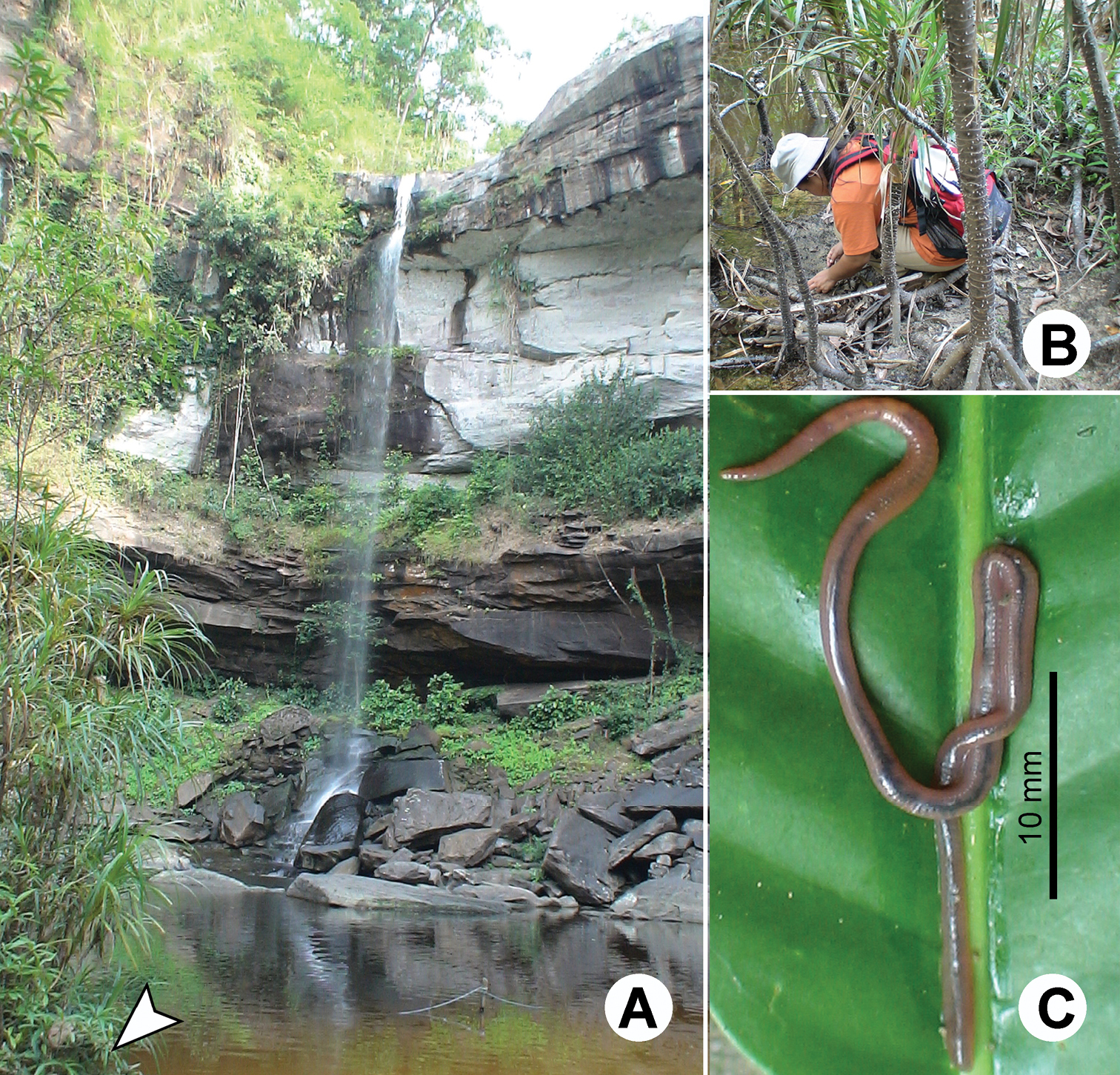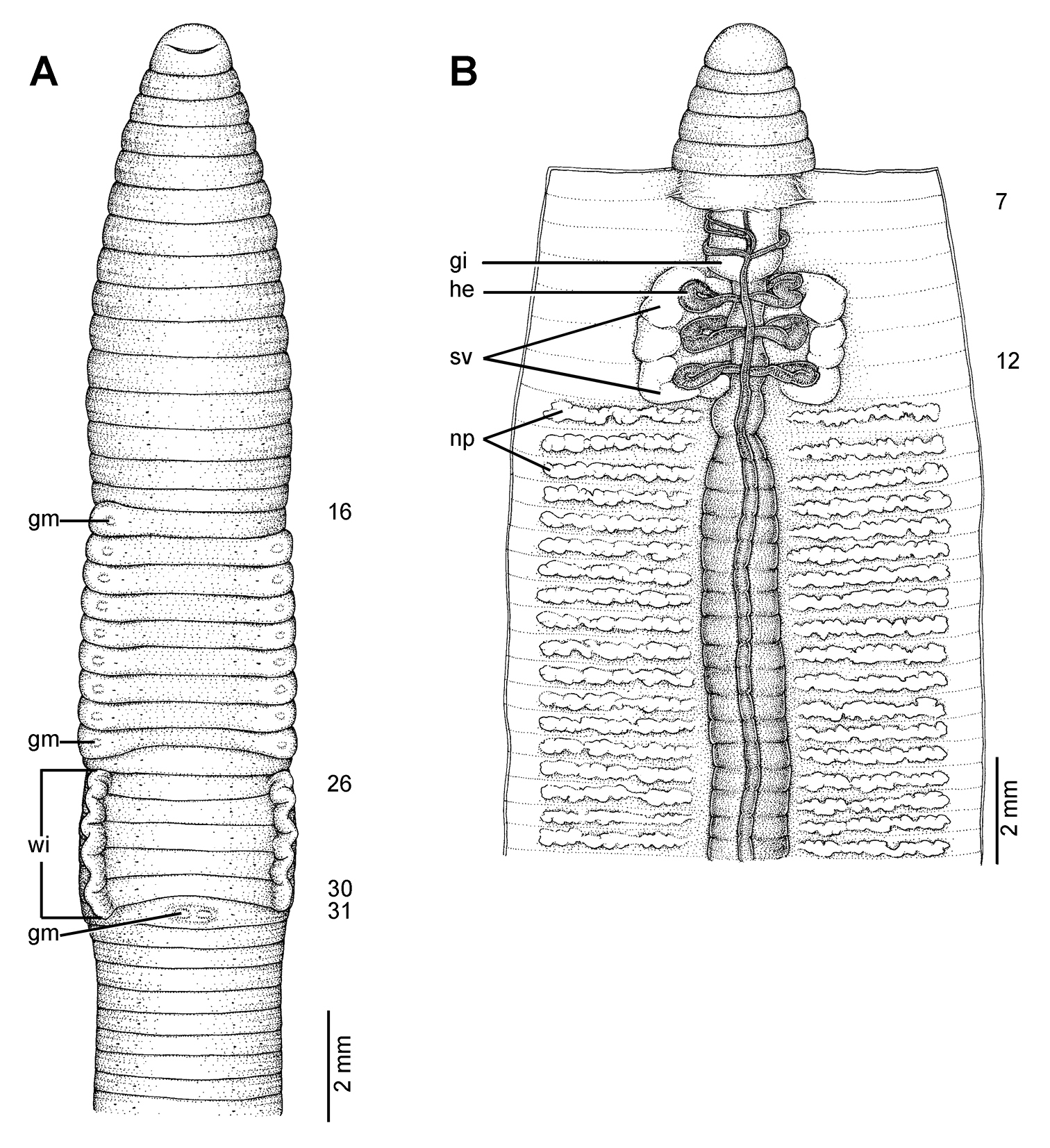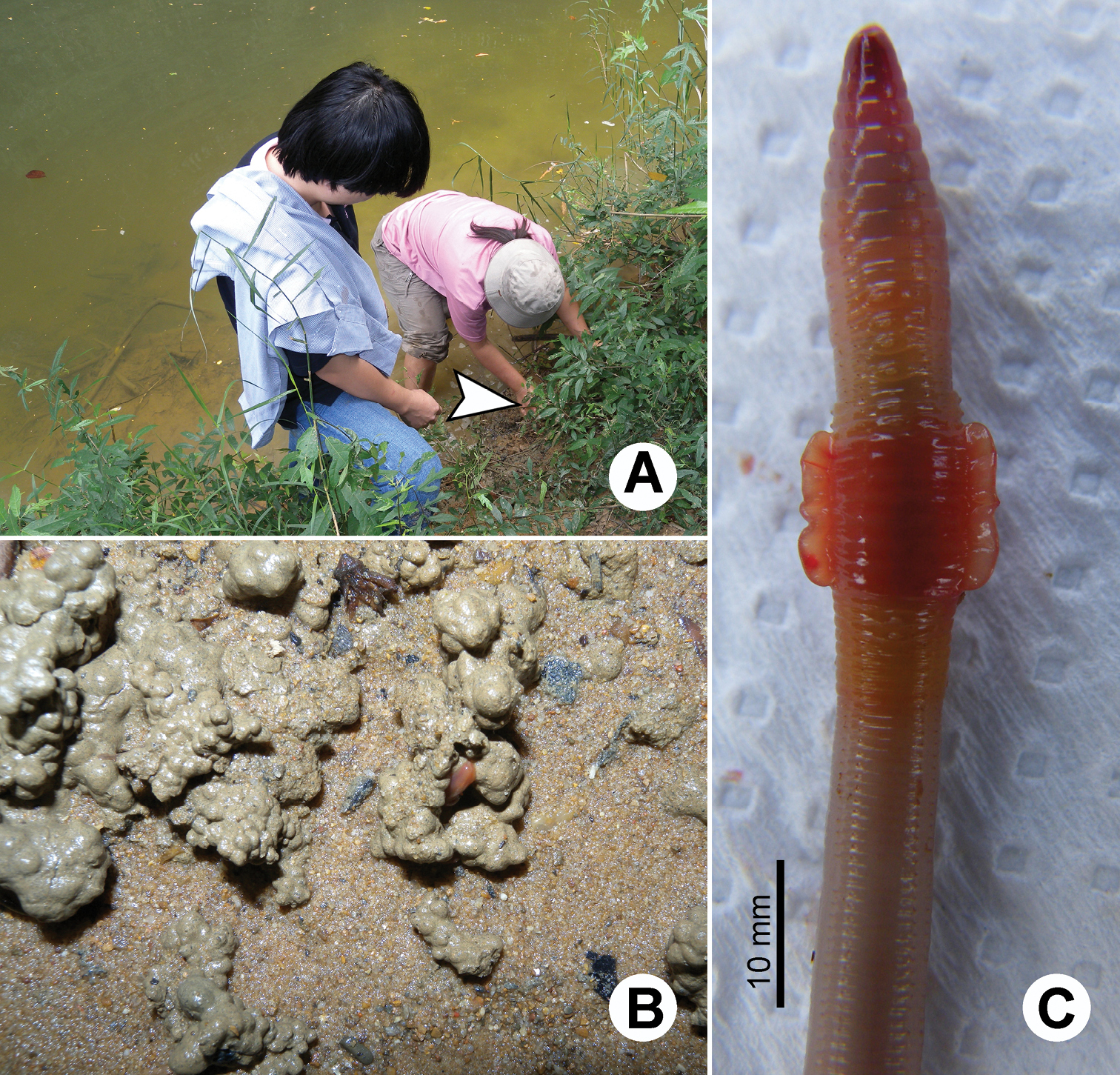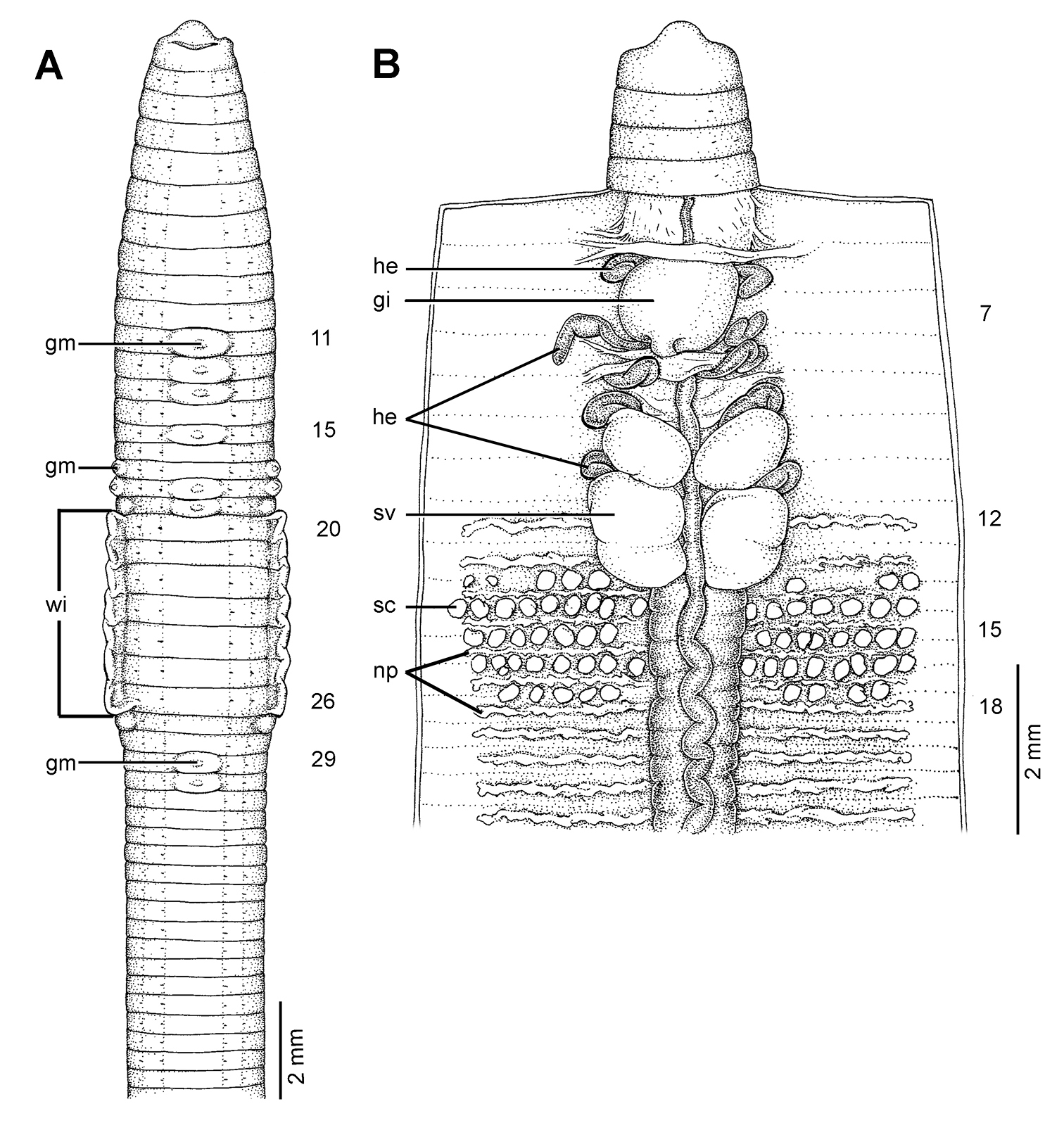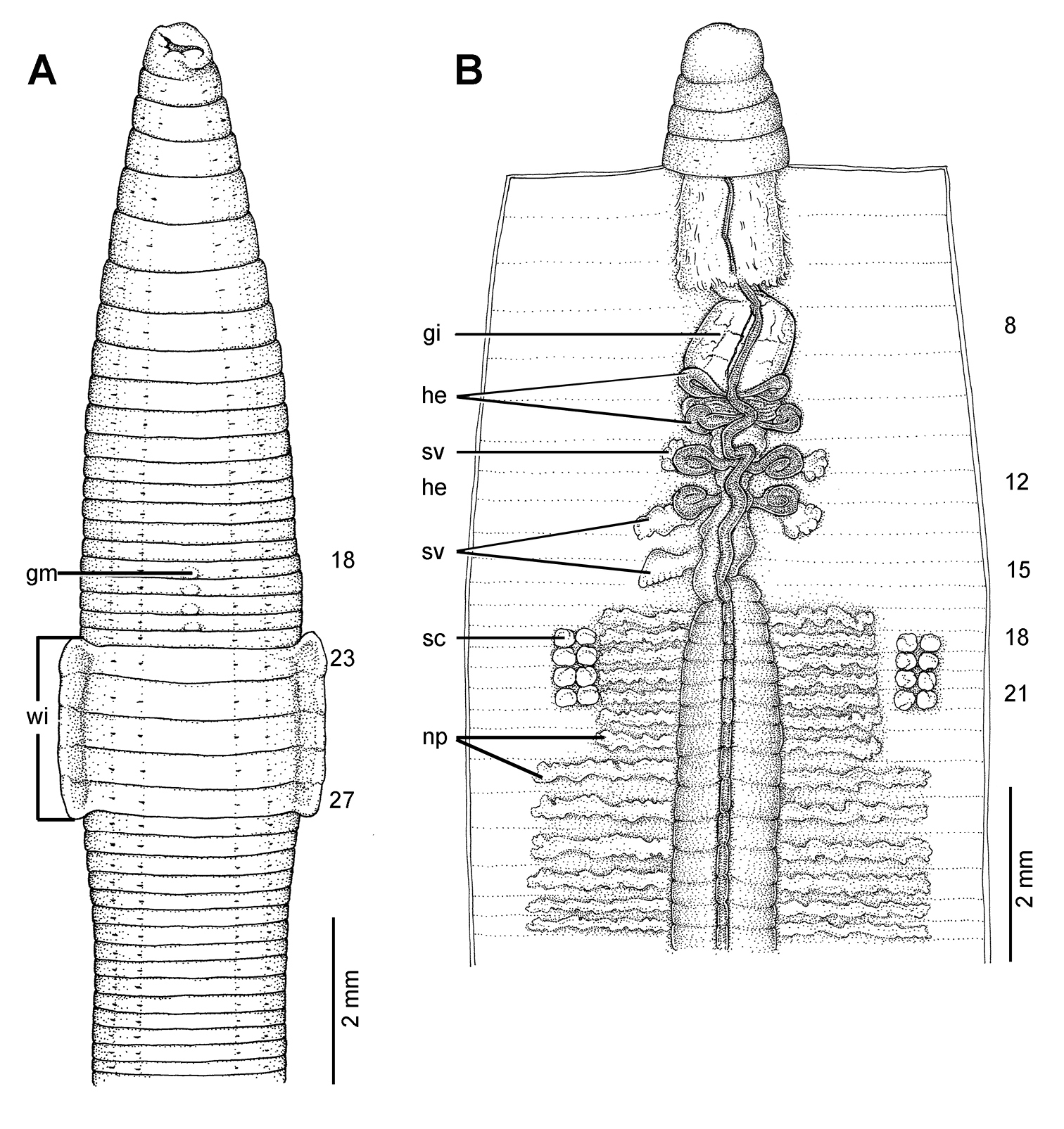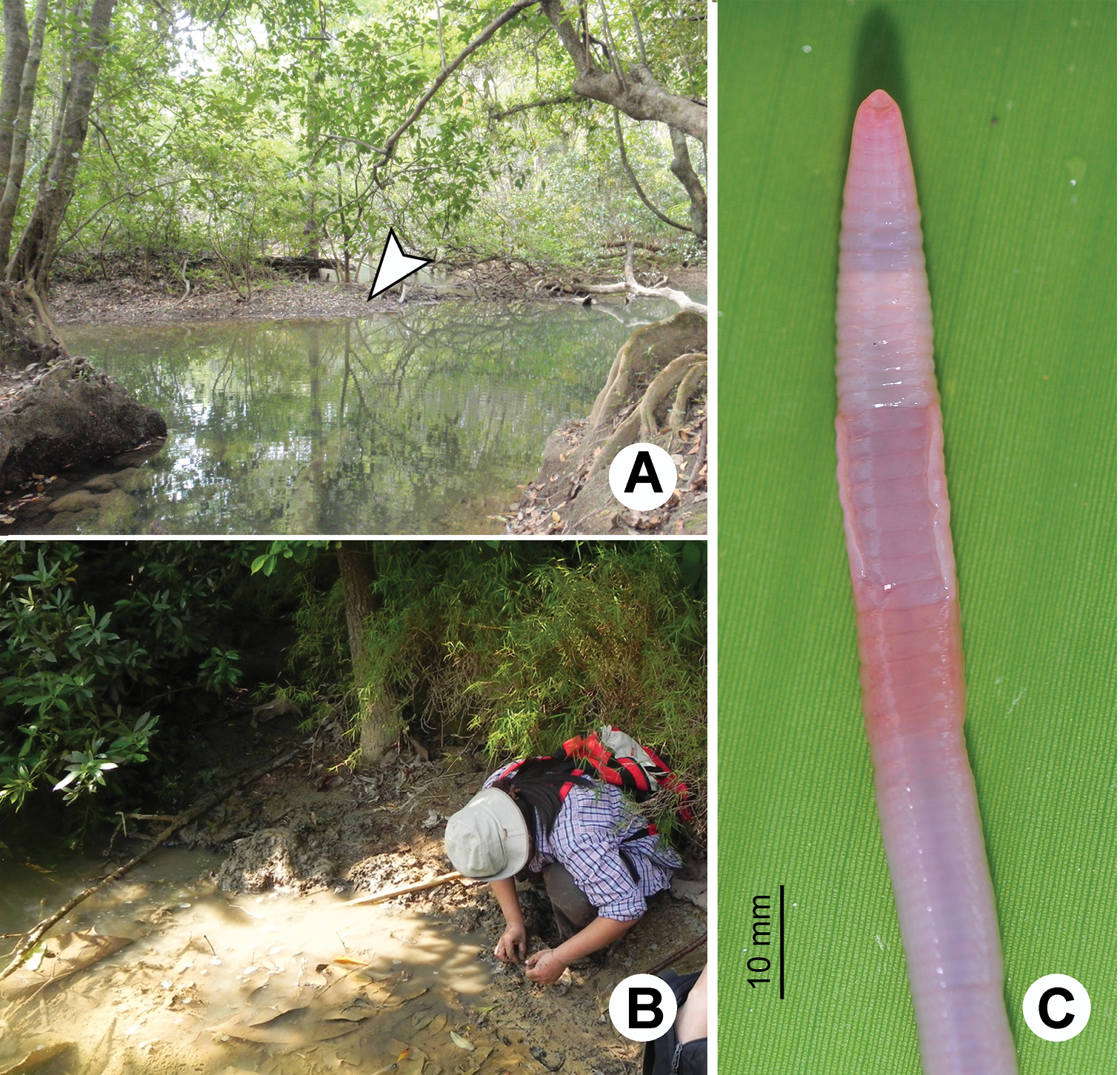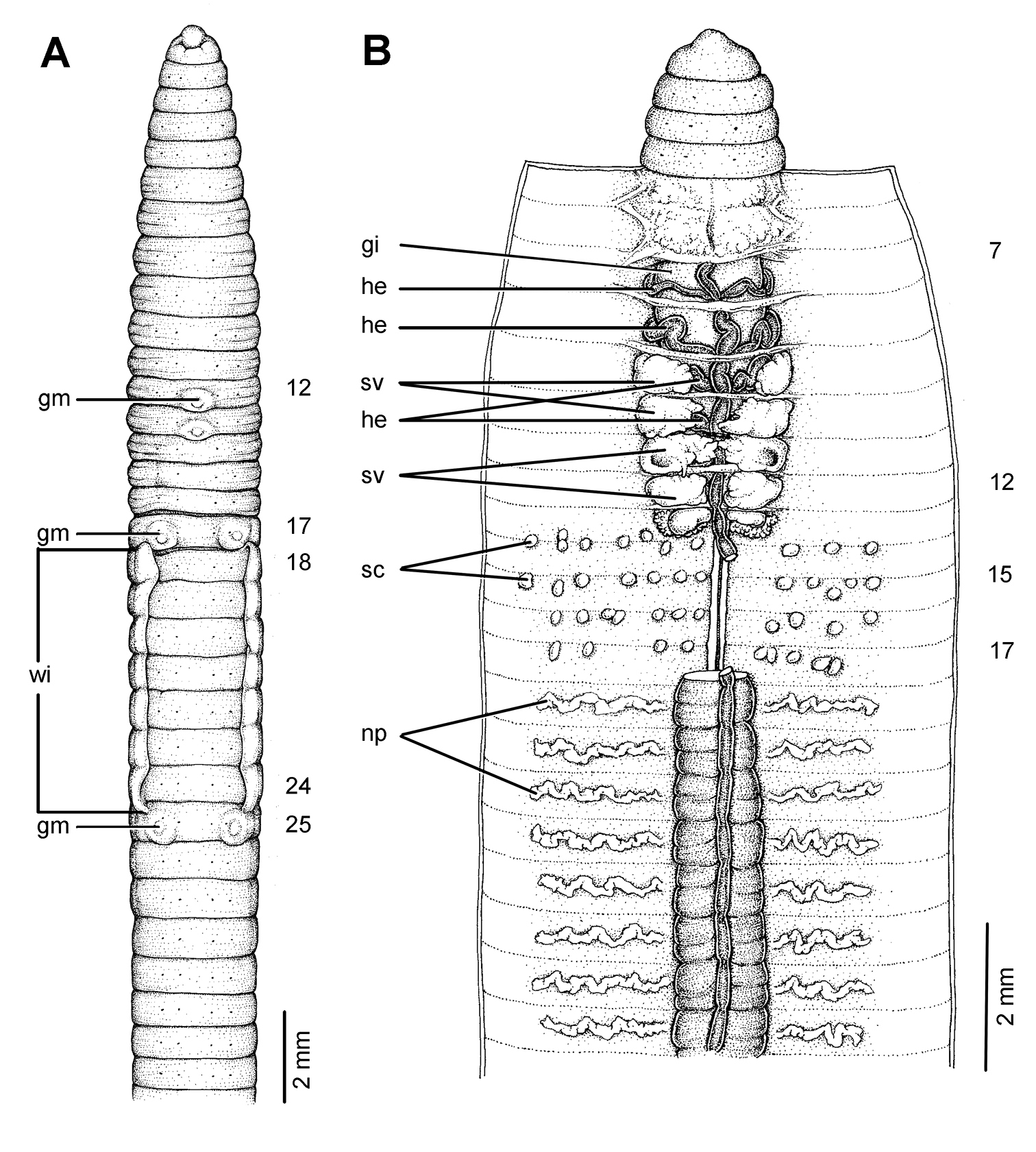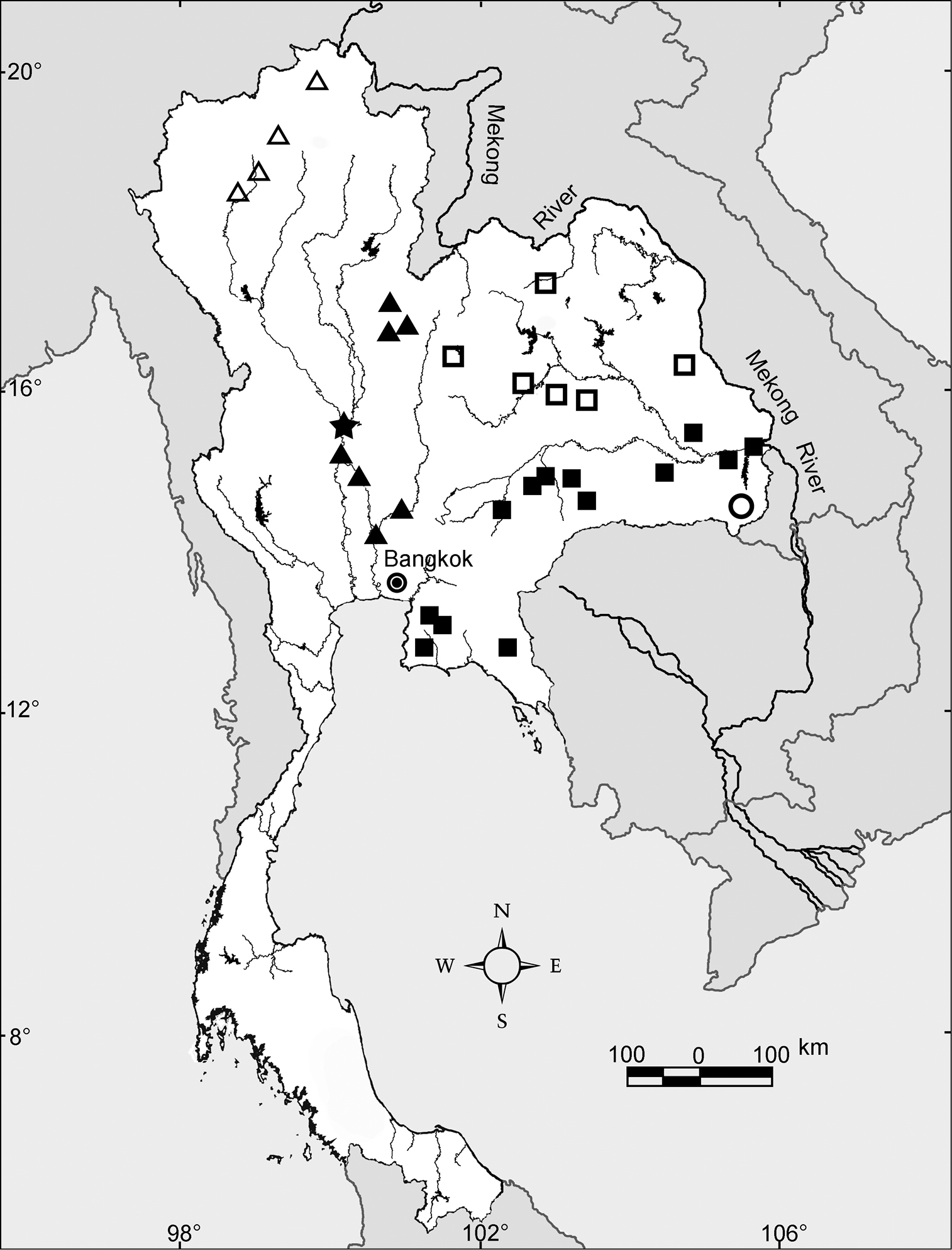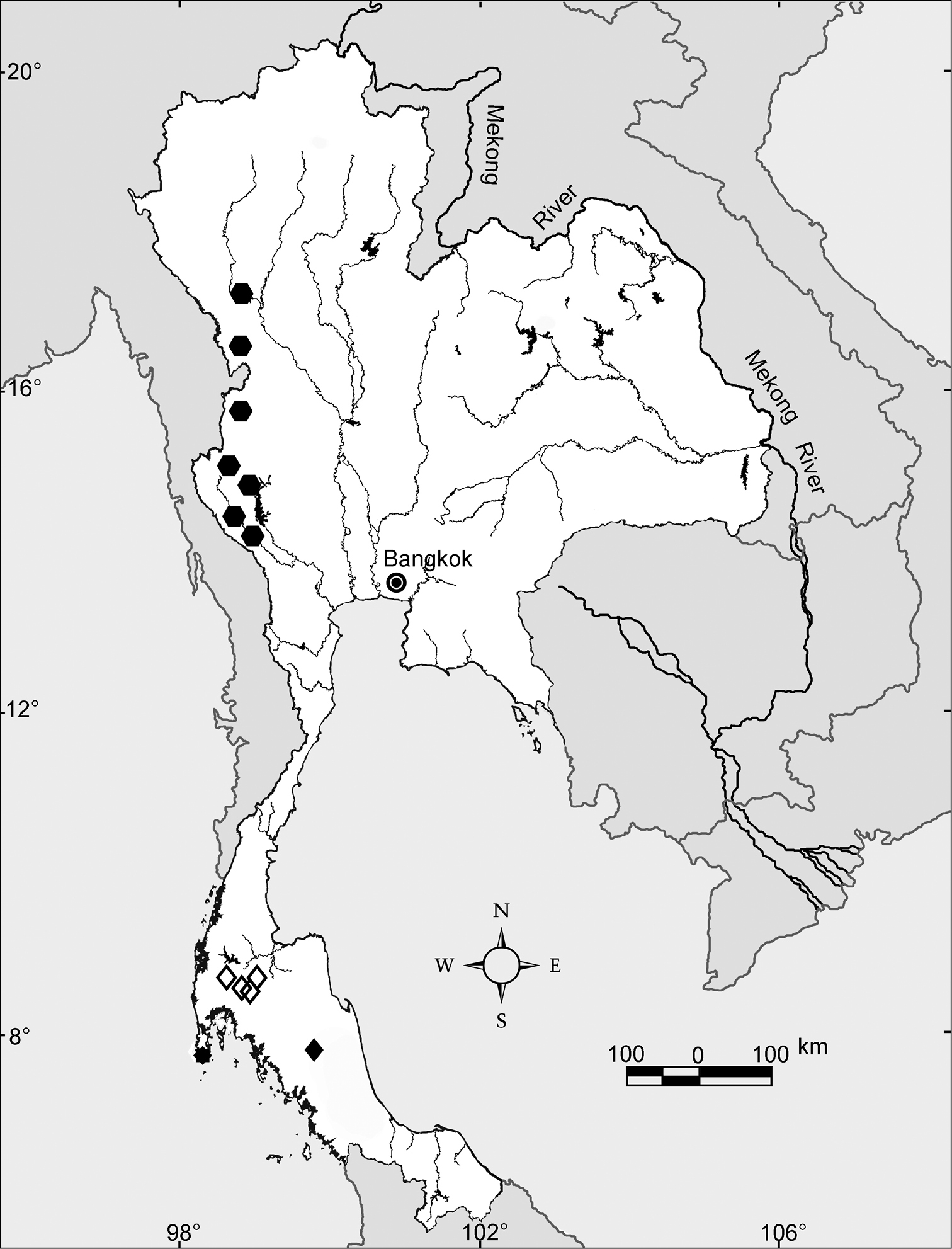






(C) 2013 Ratmanee Chanabun. This is an open access article distributed under the terms of the Creative Commons Attribution License 3.0 (CC-BY), which permits unrestricted use, distribution, and reproduction in any medium, provided the original author and source are credited.
For reference, use of the paginated PDF or printed version of this article is recommended.
The semi-aquatic freshwater earthworm genus Glyphidrilus Horst, 1889 from Thailand was investigated based on extensive recent collecting. The species in this genus were characterized by their external and internal morphological characters of the location of wings, genital openings, genital organ structures and their locations, as well as the dimensions of body length and number of segments. Several type specimens were compared with both previous and newly collected materials. Ten new species are described from several river systems in Thailand; as Glyphidrilus borealis sp. n., Glyphidrilus chaophraya sp. n., Glyphidrilus chiensis sp. n., Glyphidrilus huailuangensis sp. n., Glyphidrilus kratuensis sp. n., Glyphidrilus quadratus sp. n., Glyphidrilus trangensis sp. n., Glyphidrilus wararamensis sp. n., Glyphidrilus vangthongensis sp. n. and Glyphidrilus vesper sp. n. Each species is endemic to a single river system. All 26 previously described species are re-described, and eight lectotypes have been designated. An identification key and a morphological comparison summary are provided.
Oligochaeta, Almidae, Earthworms, New species, Glyphidrilus, Thailand, Taxonomy
Species of the genus Glyphidrilus Horst, 1889 are unfamiliar earthworms living on an ecotone between terrestrial and freshwater ecosystems of rivers, streams, canals, ponds, swamps or even in paddy rice system. Normally the animals orientate vertically head down, with their bodies in the wet soils along the banks, while tails are placed above or on the soil surface. A similar phenomenon has also been reported by
After mating Glyphidrilus produces long dark coloured cocoons containing 7–10 juveniles. The cocoons are laid in the wet layer of soils (Fig. 1C).
Photographs showing the A general characteristics of Glyphidrilus Horst, 1889, B tail tips of two individuals of Glyphidrilus in the normal position on the soil surface and C Glyphidrilus cocoons.
Glyphidrilus weberi Horst, 1889, a Javan species, was firstly described.
There are 25 species and one subspecies of Glyphidrilus recorded (
The habitat that is vital to the semi-aquatic earthworms and other aquatic animals is water. Within Thailand water has an uneven and inequitable spatial and temporal distribution, the latter related to the strongly monsoonal climate regime. The spatial distribution of rivers and their headwaters has not been static over long periods of time, but rather has changed. There are two major river systems in Thailand, the Chao Phraya and the Mekong Rivers that drain to the Gulf of Thailand and the South China Sea, respectively. In addition, Thailand has smaller river systems that drain to the Gulf of Thailand and the Andaman Sea (Fig. 2). The Mekong River is unlikely to have assumed its present course along the eastern border of the Khorat Plateau until the late Pleistocene epoch (
Major course changes along the Mekong River during the late Cenozoic era. Prehistoric river courses are shown in blue lines, and the name of the captured river are shown along with the approximated time (in million years ago) in parentheses. Based on the map of
Photographs showing typical habitat types of Glyphidrilus : A river banks, B and C streams and D paddy systems.
Photographs showing typical habitat types of Glyphidrilus ; A and B waterfalland C streams.
Earthworms were sampled from several localities in Thailand by carefully digging up the topsoil near casts on the shore and in the water using hand sorting and sieving the soil from banks of freshwater habitats. The worms were killed in 30% (v/v) ethanol, photographed, transferred to 5% (w/v) formalin for fixation for approximately 12 hours, and then transferred to 70% (v/v) ethanol for longer term preservation and subsequent morphological studies. Some specimens were placed in 95% ethanol for further DNA analysis.
Specimens were examined and compared with reference materials from several natural history museums.
The descriptions were made from observations under an OLYMPUS SZX16 stereoscopic microscope. The following external and internal morphological characters were recorded: body length and segment number, the positions of clitellum and wings, genital markings, intestinal origin, gizzard, spermathecae, hearts and seminal vesicles. Drawings were made of the body segments and the distinctive external characters and internal organs. The number of segments and the body width and length were measured in both full adults and juveniles, and are presented as the ranges (min-max) and mean±one standard deviation (SD).
The terms normally use for descriptions of earthworm characters were compiled and modified from the literature (
Annular: Clitellum encircling the body, being continuous ventrally and equally developed.
Clitellum: The region of the body wall formed from several layers of highly glandular epidermal cells, used for secreting mucus from which the egg capsule is formed. It provides nourishment for the developing embryos and, in some species, is used to hold partners together during copulation.
Dorsal pore: An intersegmental mid-dorsal pore, the sphinctered aperture leading from the coelom to the exterior between some segments.
Genital markings (gm): The area of modified epidermis important during copulation.
Gizzard (gi): Part of the alimentary canal having thick muscular walls, its main function is to grind up food before it reaches the intestine.
Hearts (he) or pseudohearts or lateral commissures or lateral hearts: Paired segmental blood vessels conveying the blood lateral-ventrally from the dorsal vessel to the ventral or sub-neural vessel.
Nephridia (np): Excretory organ, paired in most segments and comprised of a ciliated funnel or nephrosome opening into the preceding segment and leading into a system of tubules that are richly supplied with blood vessels, and terminating in a vesicle or bladder before discharging to the exterior through a nephridiopore in the body wall.
Peristomium: The foremost true segmentof an earthworm which bears the mouth.
Prostate: A paired gland in terrestrial earthworms that produces a fluid for transporting and nourishing sperm during copulation; either associated with the vas deferens or opening with a separated duct discharging through or nearby a male pore. This organ never occurrs in Glyphidrilus .
Prostomium: The portion of the head in earthworms that is situated in front of the mouth. The pre-segmental lobe is developed into a proboscis that is used for probing and swallowing soils and leaf litter. It is believed to be highly chemosensory.
Seminal vesicle(s) (sv): Pouch formed in a septum adjacent to a testicular segment, where the spermatogonia undergo the later stages of spermatogenesis and are stored until required during copulation.
Setae: Bristle of chitin, the product of a single ectodermal cell, used for locomotion, for gripping the walls of a burrow or for holding another individual during copulation.
Spermatheca or spermathecae (sc): Flask-like invagination of the body wall for the reception and storage of sperm from a partner during copulation.
The following abbreviations used in the descriptions of anatomy are as appeared in
CUMZ, Chulalongkorn University, Museum of Zoology, Bangkok, Thailand; NHM, The Natural History Museum, London, England; ZMH, Biozentrum Grindel und Zoologisches Museum, Hamburg, Germany; ZRC, Raffles Museum of Biodiversity Research, National University of Singapore, Singapore.
Colourillustrations of the (Left) general body form of Glyphidrilus and (Right) dissected body showing the internal organs.
Glyphidrilus weberi Horst, 1889. Type species by original designation in
Prostomium zygolobous. Body shape nearly circular in cross section in anterior part, and becoming quadrangular in posterior part or behind clitellum. Anus dorsal or dorso-terminal. A longitudinal lamellar ridge at maturity from body wall on each side, in bc, through several of the clitellar segments (wi). Dorsal pores absent. Setae four pairs per segment. Clitellum annular. Genital apertures, all minute and superficial. Male pores inconspicuous, located ventral to wi. Spermathecal pores usually all behind the testis segments. Gi in 7 or 8 sometime extending into an adjacent segment; strengthening of the musculature at the beginning of the intestine present or absent, no well marked intestinal gi. Calciferous glands absent. Sv usually short, each confined to segment of origin or one more; usually four pairs in 9–12. Holonephridia. Nephrostomes avesiculate and without sphincters or intestinal caeca. Testis and funnels free in 10 and 11; male ducts intramural. Ov fan shaped and with several egg strings. Ovisacs present or absent. Prostate glands absent. Sc adiverticulate.
The genus Glyphidrilus has widely distributed range from Tanzania in Africa to South Asia and Southeast Asia. In Asia many species were recorded from Yunnan, southwest China, Hainan, Indochina, Malaysia, Laos, Thailand, Singapore, and some Sunda Shelf islands such as Sumatra, Java, Borneo and Celebes (
http://species-id.net/wiki/Glyphidrilus_weberi
Fig. 6, Table 1The specimens which closely matched to the measurements and anatomical characters with the original description is designated herein as the lectotype ZMH V5097 (Fig. 6). The type locality of this species is Buitenzorg Java. Paralectotype: ZMH V5097.1 (2 adults) same locality with lectotype.
Lectotype designation proposed herewith is necessary to ensure the species is based on a complete adult earthworm.
Dimensions: body length79 mm. Body cylindrical in anterior part, quadrangular in transverse section-behind clitellum. 286 segments. Anus dorso-terminal. The body colour pale brown. At posterior end dorsal surface considerably broader than the ventral. Clitellar wi on ventro-lateral part of clitellum in 23–32. Prostomium zygolobous. Dorsal pores absent. Clitellum annular in 16–32. Four pairs of setae per segment from 2, setal formula aa:ab:bc:cd:dd = 1.0:0.5:1.5:0.5:1.0 in segment 8. Female pores, male pores and spermathecal pores not visible. Gm laterally paired or asymmetrical on bc in 15–16.
Septa 5/6–8/9 thicker, 9/10–11/12 thick and 12/13 to the last segment thin. Gi small, globular within ½7–½8. Intestine enlarged from 13. Dorsal blood vessel anterior to 8. He in 8–11. No distinguishable np in first eleven segments. Sv in 9–12. Ov in 13–14. Testis in 10–11. Prostate and accessory glands absent. Sc in 13/14–17/18, 0.2–0.4 mm in diameter, one to three on each side per segment.
Body length of paralectotypes range from79–82 mm, with 283–286 segments, wi in 22, 23–½32, 32, clitellum in 16–32.
See Table 1.
This species is known only from several Indonesian locations: the type locality at Buitenzorg in Java, Manindjan and Lake Singkarah in Sumatra, Kotting on Flores and Luwu on Celebes. There are no recent collections with precise locality information.
Compariyson of the morphological characters of Glyphidrilus species.
| Species | Length (mm) | Segments | Clitellum | Wings | Genital markings | Hearts | Intestinal origin | Gizzard | Spermathecae | Type Locality | ||
|---|---|---|---|---|---|---|---|---|---|---|---|---|
| Paired on bc | Paired on aa | Unpaired on aa | ||||||||||
| Glyphidrilus weberi | 79–82 | 283–286 | 16–32 | 22, 23–½32, 32 | 15, 16–19, 22 | absent | absent | 8–11 | 13 | ½7–½8 | 13/14–17/18 | Java, Sumatra, Celebes, Flores |
| Glyphidrilus papillatus | 100 | 330 | 14–40 | 18–23, 24, 25, 26 | 12–18 | 12–17, 18–20, 24–29 | 11–21, 23–32, 33 | 7–11 | 15 | 7–8 | 14–17 | Burma |
| Glyphidrilus quadrangulus | 50 | 200 | ? | 19, 20–25 | absent | absent | absent | ? | ? | 8 | 13/14, 14/15–15/16, 16/17 | Sumatra |
| Glyphidrilus kuekenthali | 75–90 | 153–300 | ½13–34 | 18, ½18, 19–24, ½25 | 18–25 | absent | 10–15, 25–32 | 7–11 | 15 or 16 | 8 | 14–18 | Borneo |
| Glyphidrilus stuhlmanni | 190 | 540 | 22, 23, 30–60, 66, 67, 68 | 42, 43–65, 66, 67 | 16, 18–23, 24, 25, 26, 27 | absent | 44/45–50/51, 64/65–67/68 | 8–13 | 14 | 8 | 9/10, 10/11, 12/13, 13/14–18/19, 20/21, 21/22 | Dunda on the Kingani, Tanzania |
| Glyphidrilus malayanus | 85–90 | 236–356 | 15, 16, 17–23, 24, 25, 26 | ¾18, 18–21, ½22 | 13–15, 16, 17, 22, 23 | absent | 12–16, 22–25 | 9–11 | 14 | 8 | 14/15–16/17 | Malay Peninsula |
| Glyphidrilus annandalei | 90–265 | 125–322 | beginning 13–18 ending 35–41 | 25, 26, 27–½32, 32, ½33, 33, 35, 36 | 13, 15, 18–27, 22–24, 32–34, 35 | absent | 11, 12, 13–17, 37–38, 39 | 8–11 | 15 | 8–9 | 13/14–16/17 | India |
| Glyphidrilus tuberosus | 60–118 | 221 | 14, 15, 16–28, 29, 30 | 20–24, 25, 26, 27, 28 | 10–12, 16, 18, 19, 24–28, 30 | absent | absent | ?–11 | 15 | 7 | 14–15 | Jalpaiguri, India |
| Glyphidrilus buttikoferi | 110–150 | 370 | 12–30, 33 | ½25, 25–30 | 17–24 | absent | 12–14, 29–31 | 7–11 | 15 | 8 | 14/15–17/18 | Borneo |
| Glyphidrilus jacobsoni | 101+ | 135+ | 18–31 | 21–¾27 | 18–20 | absent | 13, 14 | 8–11 | 15 | 8 | 12/13–16/17 | Sumatra |
| Glyphidrilus fluviatilis | 270–275 | 225–385 | 13–33, 36, 38 | 25–½32, 32 | 13–24, 32, 33 | absent | 12–22, 37–39 | 7–11 | 16 | 8 | absent | River Harangi, Madapur |
| Glyphidrilus elegans | 139 | 248 | 13–35 | 25–31 | 13–24, 32, 35 | absent | – | 7–11 | 13 | 8 | 13/14–17/18 | Cauvery, Dubari forests. Fraserpett (Coorg) |
| Glyphidrilus spelaeotes | 175 | 310 | 14, 15, 16–30 | 18, 19–24, ½25 | 14, 15, 16, 19, 25, 27, 28 | absent | 11, 17, 18–28 | 8–11 | 15 | 7–8 | 13/14–15/16 | Assam |
| Glyphidrilus horsti | 34.9–53.3 | 125–232 | 17, 18, ½18, 19–29, 30, ½31 | 23, ½23–½28, 28 | 18, 19, 22, 23, 27, 29 | absent | 16, 17, 18–20, 22, 27, 28 | 8, 9–11 | 13 or 15 or 16 | 7–8 | 14–17, 14/15–17/18 | Pulau Berhala, Straits of Malacca |
| Glyphidrilus ceylonensis | 180–280 | ? | ? | 16, 17, 18, 19–32, 33, 34, 35 | 16–25, 31–35 | absent | 33–34 | 7–11 | 16 | 7 | 13/14–16/17 | Ceylon |
| Glyphidrilus birmanicus | 95–103 | ? | 12, 13–43, 44 | 21, 22, 23–28, 29, 30 | 12, 13–21, 22, 23, 26, 29, 30, 31, 33, 34 | absent | absent | 7–11 | 15 | 7–8 | 13/14–17/18 | Burma |
| Glyphidrilus gangeticus | 85–200 | 202–325 | 13, ½13, 14–34 | 17, 18, 19–23, 24, 25 | 10, 12–17, 18, 19, 23, 24–32 | absent | 10, 11–14, 17, 18, 19, 28–32 | 8 or 9–11 | 16 | 7–8 or 8 | 12/13, 13/14–16/17, 17/18 | Gangetic plain from Saharanpur, India |
| Glyphidrilus yunnanensis | 123 | 139 | 18–38 | 22–32 | 17–21, 32–34 | absent | absent | 7–11 | 16 | 8 | absent | Yunnan, China |
| Glyphidrilus stuhlmanni morogoronensis | 133–199 | 430–490 | 15, 16–61, 62, 63 | 41, 42, 43–61, 62, 63 | 19–26 | absent | 38/39–50/51, 58/59, 60/61, 61/62–64/65 | 7–13 | 15 | 8 | 12/13, 13/14–19/20, 20/21 | Morogor, Tanzania |
| Glyphidrilus gatesi | 34–95 | 42–122 | ½17, 17, 18–25, ½26, 26 | 18, ½19, 19–½24, 24 | 14, 15, 16–18, 24–25, 26, 27 | absent | 13, 14–19, 24, 25–26, 27 | 9–11 | 18 | 8 | 15–17 | Johor, Malaysia |
| Glyphidrilus singaporensis | 101–143 | 181–341 | 18, 19–27, ½28, 29, 30, 31 | 21–25, ½26, 26 | 12–15, 18–20, 21, 22, 26–27, 28 | absent | 17, 18–25, 27–30 | 9–11 | 15 or 16 | 8 | 14–17 or 13/14–16/17 | Bukit Timah, Singapore |
| Glyphidrilus vangviengensis | 104–160 | 145–229 | 19, 20–35, 36, 37 | 24, 25–31, 32 | 18, 19, 20, 21–24, 33, 34 | 12–14, 15 | absent | 7–11 | 16 | 8 | absent | Song River Veintiane, Laos |
| Glyphidrilus bisegmentus | 40–71 | 152–252 | 16, 17–23, 24 | 18–19 | absent | absent | absent | 9–11 | 15 | 8–9 | absent | Air Banun Pandig , Perak, Malaysia |
| Glyphidrilus kotatinggi | 151+–195+ | 221+–415 | 17, 18–28, 29, 30 | 20, 21–¼26, 26 | 11–15, 17, 18, 19, 20, 26–27 | absent | 17, 19 | 9–11 | 14 | 8–9 | 13/14–16/17 | Kota Tinggi waterfall, Johor, Malaysia |
| Glyphidrilus peninsularis | 49–94 | 206–281 | 17, 18–31, 32 | 22, 23–28, ½29, 29 | 13, 14, 15, 16, 17, 20, 21, 22, 29, 30 | absent | 17, 18, 19, 20, 21, 31, 32 | 8–11 | 14 | 7–8 | 14/15–17/18 | Sungei Bantang, Johor, Malaysia |
| Glyphidrilus mekongensis | 125–224 | 223–382 | 19–37, 38 | 24–½33, 33, 34, ½35 | 23 | absent | absent | 7–11 | 15 | 8 | absent | Khong Chiam, Ubon Ratchathani, Thailand |
| Glyphidrilus borealis sp. n. | 66–90 | 180–284 | 14, 16, 17–31, 32, 33, 34, 35, 36 | 21, 22–27, 28, 29 | 13, 14, 16, 17, 18–22, 23, 27, 28, 29, 30 | absent | absent | 7–11 | 13 | 7–8 | 14/15–18/19 | Maeklang waterfall, Doi Inthanon National Park, Chiangmai |
| Glyphidrilus vangthongensis sp. n. | 62–195 | 150–358 | 12, 13, 14, 15, 16–40, 41, 42 | 24, 25, 26–31, 32 | 13, 14–24, 25, 26, 31, 32, 33 | 12, 13, 14, 30, 32, 33, 34, 35, 36 | absent | 7–11 | 14 | 7–8 | 12/13–18/19 | Sakulnothayan waterfall, Vangthong, Phitsanulok |
| Glyphidrilus chaophraya sp. n. | 113–138 | 325–414 | 20–43, 44, 45 | 24, 25–32, 33 | 16, 19, 20–23, 32, 33 | 12, 13, 14, 34, 35, 37, 38 | absent | 7–11 | 15 | 8 | 16/17–22/23 | Chaophraya River, Payuhakiri, Nakhonsawan |
| Glyphidrilus chiensis sp. n. | 61–193 | 122–386 | 17, 18–33, 34, 35, 36, 37, 38 | 23, 24, 25, 26–29, 30, 31, 32 | 15, 16, 17, 18, 19–20, 21, 22, 23, 24, 30, 31, 33 | 11, 12, 13, 14, 30, 32, 33, 34, 35, 36 | absent | 7–11 | 15 | 8 | 12/13–18/19 | rice filed at Ban Thatoom, Mueang, Mahasarakham |
| Glyphidrilus quadratus sp. n. | 54–156 | 186–378 | 15, 16, 17, 18–31, 32, 33, 34, 35, 36 | 23, 24–28, 29, 30, 31 | 13, 15, 16, 17, 18, 19–21, 22, 23, 30, 31 | 11, 12, 13, 14, 31, 32, 33, 34 | absent | 7–11 | 15 | 8 | 12/13–17/18 | Kang Sapue, Phibonmangsahan, Ubon Ratchathani |
| Glyphidrilus huailuangensis sp. n. | 50–91 | 131–228 | 12, 13, 16–32, 33 | 25, 26–30, 31 | 16–24 | 31 | absent | 8–11 | 13 | 7–8 | absent | Huailung waterfall, Najahlauy, Ubon Ratchathani |
| Glyphidrilus wararamensis sp. n. | 18+–120 | 46+–279 | 11, 12, 13–33, 34, 35 | 20, 21–26, 27 | 14, 15, 17–19, 20, 27 | absent | 11–13, 14, 15, 17, 18–19, 20, 28, 29–30 | 8–11 | 14 | 6–8 | 13/14–17/18 | stream near Wattham Wararam, Phanom, Suratthani |
| Glyphidrilus trangensis sp. n. | 11+–63+ | 41+–153+ | 17, 18–30 | 22, 23–27, 28 | absent | absent | 18–21 | 8–11 | 16 | 8–9 | 18–21 | Trang River, Nayong, Trang |
| Glyphidrilus kratuensis sp. n. | 48–93 | 221–282 | 18–30, 31, 32 | 23, 24–28, 29, 30 | 14, 15, 16, 17, 18, 19, 22, 23, 24, 29, 30 | absent | 18, 19–20, 21, 22, 23, 30–31, 32–34 | 8–11 | 14 | 8 | 14/15–17/18 | Kratu waterfall, Kratu, Phuket |
| Glyphidrilus vesper sp. n. | 46–146 | 102–260 | 14, 15, 16, 17–29, 30, 31, 32 | 18–24, ½25, 25 | 12–17, 18, 24, 25–26, 27 | absent | 11, 12, 13, 26, 27 | 7–11 | 15 | 7–8 | 13/14–16/17 | Thilorsu waterfall, Umphang, Tak |
“-” Character absent.“?” Not shown in the original description.
External and internal morphology of the lectotype (ZMH V5097) of Glyphidrilus weberi Horst, 1889, showing the A external ventral and B internal dorsal views.
http://species-id.net/wiki/Glyphidrilus_papillatus
See Table 1.
Glyphidrilus papillatus was previously known from Burma.
http://species-id.net/wiki/Glyphidrilus_quadrangulus
See Table 1.
This species is known only from the type locality. There are no records from other localities.
http://species-id.net/wiki/Glyphidrilus_kuekenthali
See Table 1.
The distribution of Glyphidrilus kuekenthali is the type locality in Barem River, Sarawak.
http://species-id.net/wiki/Glyphidrilus_stuhlmanni
Fig. 7, Table 1The specimen which closely matches the measurements and anatomical characters of the original description is designated herein as the lectotype ZMH V4512 (Fig. 7). The type locality of this species is Dunda on the Kingani, Tanzania. Paralectotype: ZMH V4512.1 (only one tail) from the type locality. Additional reference specimens: 1 subadult (ZMH OI13904) from Tanzania, Turiani River Diwale, sugar factory. 3 adults (ZMH OI13902) from Tanzania, Morogoro floodplain. 1 adult (ZMH OI13903) from Tanzania, Turiani floodplain, sugar factory. 1 adult (ZMH OI13937) from Tanzania, Morogoro, sugar factory surrounding area.
Lectotype designation proposed herewith is necessary to ensure the species is based on a complete adult earthworm.
Dimensions: body length190 mm. Body cylindrical in anterior part, quadrangular in transverse section-behind clitellum. 540 segments. Anus dorso-terminal. Body colour pale brown. At posterior end dorsal surface considerably broader than the ventral. Clitellar wi on ventro-lateral part of clitellum in 43–65. Prostomium zygolobous. Dorsal pores absent. Clitellum annular in 30–68. Four pairs of setae per segment from 2, setal formula aa:ab:bc:cd:dd =1.0:0.5:1.5:0.5:1.0 in segment 8. Female pores, male pores and spermathecal pores not visible. Median unpaired gm on aa in 44–50.
Septa 5/6–7/8 thicker, 8/9–11/12 thick and 12/13 to the last segment thin. Gi small, globular within 8. Intestine enlarged from 14. Dorsal blood vessel anterior to 8. He in 8–13. Np distinguishable from segment 15 onwards. Sv in 9–12, those of segment 12 are larger than the others. Ov in 13–14. Testis in 10–11. Prostate and accessory glands absent. Sc in 13/14–20/21, one to four on each side per segment.
Additional specimens (5 complete adults) have the clitellum in 22, 23, 30–60, 66, 67, 68. Wi in 42, 43–65, 66, 67; gm laterally paired or asymmetrical on bc in 16 or 18–23, 24, 25, 26 or 27, and median unpaired or single on aa in 44/45–50/51, 64/65–67/68; sc sessile, subspherical in 9/10, 10/11, 12/13, 13/14–18/19, 20/21, 21/22.
See Table 1.
This species occurs on at least three rivers in Tanzania, the Kigani near Dunda, the Turiani near Diwale, and the Morogoro.
Morphology of the lectotype (ZMH V4512) of Glyphidrilus stuhlmanni Michaelsen, 1897, showing the A external ventral and B internal dorsal views.
http://species-id.net/wiki/Glyphidrilus_malayanus
Fig. 8, Table 1The specimen with the measurements and anatomical characters agreeing with the original description is designated as the lectotype ZMH V5875 (Fig. 8). The type locality of this species is Malay Peninsula, Lubock Paku, Pahang River. Paralectotype: ZMH V5875.1 (only one tail) same locality with lectotype.
Lectotype designation proposed herewith is necessary to ensure the species is based on a complete adult earthworm.
Dimensions: body length 87 mm. Body cylindrical in anterior part, quadrangular in transverse section-behind clitellum. 246 segments. Body colour pale brown. At posterior end dorsal surface considerably broader than the ventral. Clitellar wi on ventro-lateral part of clitellum in ¾18–½22. Prostomium zygolobous. Dorsal pores absent. Clitellum annular in 15–26. Four pairs of setae per segment from 2, setal formula aa:ab:bc:cd:dd = 1.0:0.5:1.5:0.5:1.0 in segment 8. Female pores, male pores and spermathecal pores not visible. Gm laterally paired or asymmetrical on bc in 15–17.
Septa 5/6–7/8 thicker, 8/9–11/12 thick and 12/13 to the last segment thin. Gi small, globular within 8. Intestine enlarged from 14. Dorsal blood vessel anterior to 9. He in 9–11. Np distinguishable from segment 17 onwards. Sv in 9–12, those of segment 12 are larger than the others. Ov in 13–14. Testis in 10–11. Prostate and accessory glands absent. Sc in 14/15–16/17, two on each side per segment.
See Table 1.
The distribution of Glyphidrilus malayanus is Malay Peninsula, Lubock Paku, Pahang River. Sungei Kelatan, Kelantan, Malaysia. Sungei Berkoh, Johor, Malaysia. Tok Bok Hotspring, Kelantan, Malaysia.
Morphology of the lectotype (ZMH V5875) of Glyphidrilus malayanus Michaelsen, 1902, showing the A external ventral and B internal dorsal views.
http://species-id.net/wiki/Glyphidrilus_annandalei
Figs 9, 10, Table 1The specimen which closely matches the measurements and anatomical characters of the original description is designated herein as the lectotype ZMH V3600 (Fig. 9). The type locality of this species is Quilon, Travancore. Paralectotype: ZMH V3600.1 (7 adults and 16 juveniles) same locality with lectotype. Additional reference specimens: 4 adults (ZMH V3601) from Calicut, Malapuram, Tiruvallur. 13 adults (ZMH V3607) from Malabar. 1 juvenile (ZMH V9173) from Narayan, Vordeviu Dicu. 2 juveniles (ZMH V9172) from Narayan, Vordeviu Dicu. 1 subadult (NHM 1922: 4: 20: 2) from banks of the Harngi, Madapur (Coorg). 1 juvenile (NHM 1922: 4: 20: 3) from Forests of Dubari, Fraserpett (Coorg).
Lectotype designation proposed herewith is necessary to ensure the species is based on a complete adult earthworm.
Dimensions: body length 161 mm. Body cylindrical in anterior part, quadrangular in transverse section behind clitellum. 201 segments. Body colour pale brown. Anus dorsal terminal. At posterior end dorsal surface considerably broader than the ventral. Clitellar wi on ventro-lateral part of clitellum in 27–33. Prostomium zygolobous. Dorsal pores absent. Clitellum annular in 14–39. Four pairs of setae per segment from 2, setal formula aa:ab:bc:cd:dd = 1.0:0.5:1.5:0.5:1.0 at segment 8. Female pores, male pores and spermathecal pores not visible. Gm laterally paired or asymmetrical on bc in 18–26 and 33, median unpaired on aa in 13–17.
Septa 5/6–8/9 thicker, 9/10–10/11 thick and 11/12 to the last segment thin. Gi small, globular within 8–9. Intestine enlarged from 15. Dorsal blood vessel anterior to 8. He in 8–11. Np distinguishable from segment 14 onwards. Sv in 9–12, with the pair in segment 12 larger than the others. Ov in 13. Testis in 10–11. Prostate and accessory glands absent. Sc in 13/14–16/17, four to six on each side per segment.
The body lengths of type and non-type material 90–265 mm. 125–322 segments. Wi in 25, 26, 27–½32, 32, ½33, 33, 35, 36, clitellum in 13, 14, 15, 16, 17, 18–35, 36, 37, 38, 39, 40, 41.
See Table 1.
This specieswas known from India: Malabar Coast, Travancore, Coorg, Mysore, Calicut, Malapuram and Tiruvallur, Gadana River, and tributaries in the buffer zone of Kalakkad-Mundanthurai Tiger Reserve from a sub basin of the river in the southern Western Ghats, Bangalore, and Bhadravatha and along the edge of Bhavani River, northern parts of Tamil Nadu, and southern parts of Karnataka, India. Sandy banks of the Harangi, Madapur (Coorg), and of the Cauvery, Dubari forests, Fraserpett (Coorg).
Morphology of the lectotype (ZMH V3600) of Glyphidrilus annandalei Michaelsen, 1910, showing the A external ventral and B internal dorsal views.
Morphology of the paralectotype of Glyphidrilus annandalei Michaelsen, 1910, showing the A external ventral view of NHM 1922: 4: 20: 3, and B and C NHM 1922: 4: 20: 2 showing the B external ventral and C internal dorsal views.
http://species-id.net/wiki/Glyphidrilus_tuberosus
See Table 1.
Glyphidrilus tuberosus is known only from the original description in Kenduapatna Canal, Ponds at Pubhans, Cuttack, Mud at edge of River Tista, Jalpaiguri, Orissa, Bengal, Bayrani in Ganjam district, Madras Presidency. There are no recent collections of this species.
http://species-id.net/wiki/Glyphidrilus_buttikoferi
Fig. 11, Table 1The specimens which closely match the measurements and anatomical characters with the original description is designated herein as the lectotype ZMH V9301 (Fig. 11). The type locality of this species is Borneo, Sintang. Paralectotype: ZMH V9301.1 (3 adults) same locality with lectotype.
Dimensions: body length 110 mm. Body cylindrical in anterior part, quadrangular in transverse section behind clitellum. 370 segments. Body colour pale brown. At posterior end dorsal surface considerably broader than the ventral. Clitellar wi on ventro-lateral part of clitellum in 25–30. Prostomium zygolobous. Dorsal pores absent. Clitellum annular in 12–33. Four pairs of setae per segment from 2, setal formula aa:ab:bc:cd:dd = 1.0:0.5:1.5:0.5:1.0 in segment 8. Female pores, male pores and spermathecal pores not visible. Gm with rim: lateral paired or asymmetrical on bc in 17–24, median unpaired on aa in 12–24 and 29–31.
Septa 5/6–8/9 thicker, 9/10–11/12 thick and 12/13 to the last segment thin. Gi small, globular within 8. Intestine enlarged from 15. Dorsal blood vessel anterior to 7. He in 7–11. Np distinguishable from segment 15 onwards. Sv in 9–12, with pair in segment 12 larger than the others. Ov in 13–14. Testis in 10–11. Prostate and accessory glands absent. Sc in 14/15–17/18, two to seven on each side per segment.
Body length of paralectotypes (3) range from110–150 mm.370 segments. Clitellum in 12, 30–33. Wi in ½25, 25–30.
See Table 1.
This specieswas recorded only from Sintang, Borneo as in the original description. There are no recent records of this species.
Morphology of the lectotype (ZMH V9301) of Glyphidrilus buttikoferi Michaelsen, 1922, showing the A external ventral and B internal dorsal views.
http://species-id.net/wiki/Glyphidrilus_jacobsoni
Fig. 12, Table 1The specimen which closely matches the measurements and anatomical characters with the original description is designated herein as the lectotype ZMH V9293 (Fig. 12). The type locality of this species is Sumatra, Korintji, Soengai Koembang. Paralectotype: ZMH V9293.1 (1 juvenile) same locality with lectotype.
Dimensions: body length 101+ mm. Body cylindrical in anterior part, quadrangular in transverse section behind clitellum. 135+ segments. Body colour pale brown. At posterior end dorsal surface considerably broader than the ventral. Clitellar wi on ventro-lateral part of clitellum in 21–¾27. Prostomium zygolobous. Dorsal pores absent. Clitellum annular in 18–31. Four pairs of setae per segment from 2, setal formula aa:ab:bc:cd:dd = 1.0:0.5:1.5:0.5:1.0 in segment 8. Female pores, male pores and spermathecal pores not visible. Gm: lateral paired or asymmetrical on bc in 18–20, median unpaired on aa in 13–14.
Septa 5/6–8/9 thicker, 9/10–11/12 thick and 12/13 to the last segment thin. Gi small, globular within 8. Intestine enlarged from 15. Dorsal blood vessel anterior to 8. He in 8–11. No distinguishable np in first eleven segments. Sv in 9–12, with the pair in segment 12 larger than the others. Ov in 13–14. Testis in 10–11. Prostate and accessory glands absent. Sc in 12/13–16/17, four on each side per segment.
http://species-id.net/wiki/Glyphidrilus_fluviatilis
Fig. 13, Table 1The specimen which closely matches the measurements and anatomical characters with the original description is designated herein as the lectotype NHM 1922: 4: 20: 618 (Fig. 13). The type locality of this species is Sandy banks of River Harangi, Madapur (Coorg); Cauvery, Fraserpett (Coorg), and Sheravathy, Shimoga (Mysore). Additional reference specimens: 2 adults (ZMH V9174) from Narayan, Vordevia Dicu.
Dimensions: body length 272 mm. Body cylindrical in the anterior part but behind clitellum it is quadrangular in transverse section view. 225 segments. Body cylindrical in anterior part, quadrangular in transverse section-behind clitellum. Anus dorsal-terminal. At posterior end dorsal surface considerably broader than the ventral. Clitellar wi on ventro-lateral part of clitellum in 25–½32. Prostomium zygolobous. Dorsal pores absent. Clitellum annular in 13–38. Four pairs of setae per segment from 2, setal formula aa:ab:bc:cd:dd =1.0:0.5:1.5:0.5:1.0 at segment 8. Female pores, male pores and spermathecal pores not visible. Gm with rim: lateral paired or asymmetrical on bc in 13–24 and 32, 33, median unpaired on aa in 12–22 and 37–39.
Septa 5/6–7/8 thicker, 8/9–9/10 thick and 11/12 to the last segment thin. Gi small, globular within 8. Intestine enlarged from 16. Dorsal blood vessel anterior to 7. He in 7–11. No distinguishable np in first thirteen segments. Sv in 9–12. Ov in 13. Testis in 10–11. Prostate, accessory glands and sc absent.
The body length of non type spcimens range from270–275 mm, with 225–385 segments. Wi in 25–½32, 32, with clitellum in 13–33, 36, 38.
See Table 1.
This speciesis known from the type locality in sandy banks of river Harangi, Madapur (Coorg); Cauvery, Fraserpett (Coorg), and Sheravathy, Shimoga (Mysore) and Narayan, Vordevia Dicu.
Morphology of the lectotype (NHM 1922: 4: 20: 618) of Glyphidrilus fluviatilis Rao, 1922, showing the A external ventral and B internal dorsal views.
http://species-id.net/wiki/Glyphidrilus_elegans
Fig. 14, Table 1The specimen which closely matches the measurements and anatomical characters with the original description is designated herein as the lectotype NHM 1922: 4: 20: 10 (Fig. 14). The type locality of this species is Sandy islets in the Cauvery, Dubari forests. Fraserpett (Coorg); bank of Sheravaty, Shimoga (Mysore).
Dimensions: body length 139 mm. Body cylindrical in anterior part, quadrangular in transverse section-behind clitellum. 248 segments. Body colour pale brown. Anus dorsal-terminal. At posterior end dorsal surface considerably broader than the ventral. Clitellar wi on ventro-lateral part of clitellum in 25–31. Prostomium zygolobous. Dorsal pores absent. Clitellum annular in 13–35. Four pairs of setae per segment from 2, setal formula aa:ab:bc:cd:dd = 1.0:0.5:1.5:0.5:1.0 at segment 8. Female pores, male pores and spermathecal pores not visible. Gm: lateral paired or asymmetrical on bc in 13–24, and 32–35.
Septa 5/6–8/9 thicker, 9/10–11/12 thick and 12/13 to the last segment thin. Gi small, globular within 8. Intestine enlarged from 13. Dorsal blood vessel anterior to 7. He in 7–11. No distinguishable np in first thirteen segments. Sv in 9–12. Ov in 13. Testis in 10–11. Prostate and accessory glands absent. Sc in 13/14–17/18, two to six on each side per segment.
See Table 1.
This speciesis known only from the type locality in sandy islets in the Cauvery, Dubari forests and Fraserpett (Coorg); banks of Sheravaty, Shimoga (Mysore).
Morphology of the lectotype (NHM 1922: 4: 20: 10) of Glyphidrilus elegans Rao, 1922, showing the A external ventral and B internal dorsal views.
http://species-id.net/wiki/Glyphidrilus_spelaeotes
See Table 1.
This species is known only from Siju Cave, Garo Hills, Assam as in the original description. In the recent collections there are no records of this species.
http://species-id.net/wiki/Glyphidrilus_horsti
Fig. 15, Table 1One specimen of Glyphidrilus horsti from Turut Track, Kranji Wireless Station, Singapore, ZRC (Fig. 15).
See Table 1.
Distribution of this species includes the type locality in Pulau Berhala, Straits of Malacca, and Pulau Berhala, Turut Track, Kranji Wireless Station, Singapore.
Morphology of Glyphidrilus horsti Stephenson, 1930 (ZRC) from Turut Track, Kranji Wireless Station, Singapore, showing the A external ventral and B internal dorsal views.
http://species-id.net/wiki/Glyphidrilus_ceylonensis
See Table 1.
Glyphidrilus ceylonensis is known only from Ceylon: Palmadulla, 1, 000–1, 500 feet amsl, as in the original description.
http://species-id.net/wiki/Glyphidrilus_birmanicus
See Table 1.
The distributionof Glyphidrilus birmanicus was only from Burma as in the original description. No recent collections have found this species.
http://species-id.net/wiki/Glyphidrilus_gangeticus
See Table 1.
This species is known only from its type locality in Saharanpur, and United Provinces, India, as in the original description.
http://species-id.net/wiki/Glyphidrilus_yunnanensis
See Table 1.
This species is known only from the type locality at Menglun, Loso River, Yunnan, China. There are no records of this species in the recent collections.
http://species-id.net/wiki/Glyphidrilus_stuhlmanni_morogoronensis
Fig. 16, Table 1The paratype ZMH V4512 (Fig. 16). Locality as in the type locality.
See Table 1.
The subspecies Glyphidrilus stuhlmanni morogoronensis is known only from river banks 150 km from Morogoro in the direction of Mikumi National Park in Tanzania. No recent collections of this species are known.
Morphology of the paratype (ZMH V4512) of stuhlmanni Glyphidrilus morogoronensis Zicsi, 1996, showing the A external ventral and B internal dorsal views.
http://species-id.net/wiki/Glyphidrilus_gatesi
Fig. 17, Table 1The holotype ZRC 1974.12.2.51 (Fig. 17). The type locality of this species is Sungei Kayu, swamp forest near River Sedili, Johor, Malaysia as from the locality of the holotype. Paratypes: ZRC 1974.12.2.52–62 (9 adults and 2 juveniles) the collection data as for the holotype.
See Table 1.
The distribution Glyphidrilus gatesi is at Sungei Kayu, in swamp forest near River Sedili, Johor, Malaysia as in the original description.
Morphology of the holotype (ZRC 1974.12.2.51) of Glyphidrilus gatesi Shen and Yeo, 2005 A external ventral and B internal dorsal views.
http://species-id.net/wiki/Glyphidrilus_singaporensis
Fig. 18, Table 1The holotype ZRC (Fig. 18). The type locality of this species is Jungle Fall Valley, Bukit Timah, Singapore. Paratypes: (ZRC) (2 adults and 9 juveniles), same collection data as for holotype.
See Table 1.
This species is known only from Jungle Fall Valley, Bukit Timah, Singapore. There have been no more recent collections.
External and internal morphology of the holotype (ZRC) of Glyphidrilus singaporensis Shen and Yeo, 2005, showing the A external ventral and B internal dorsal views.
http://species-id.net/wiki/Glyphidrilus_vangviengensis
The holotype CUMZ 3221. The type locality of this species is river banks of Song River at Vangvieng, Vientiane, Laos. Paratypes: CUMZ 3222 (10 adults) the collection data same as for the holotype.
See Table 1.
The Glyphidrilus vangviengensis is known only from the type locality in river banks of Song River at Vangvieng, Vientiane, Laos.
http://species-id.net/wiki/Glyphidrilus_mekongensis
The holotype CUMZ 3215. The type locality of this species is the bank of the Mekong River at Khong Chiam District, Ubon Ratchathani Province at 15°18'57.1"N, 105°30'43.9"E, 101 m amsl, Thailand. Paratypes: CUMZ 3216 (15 adults), 3 adults (ZMH), 3 adults (NHM), same locality with lectotype.
See Table 1.
The Glyphidrilus mekongensis is known only from type locality in the bank of the Mekong River at Khong Chiam District, Ubon Ratchathani Province, Thailand nearby Laos.
http://species-id.net/wiki/Glyphidrilus_bisegmentus
The holotype CUMZ 3276. The type locality of this species is Air Banun Pandig, Perak, Malaysia. Paratypes: CUMZ 3277 (17 adults and 8 juveniles), 3 adults (ZMH OL14575), and 3 adults (NHM) same collection data as for holotype.
See Table 1.
Glyphidrilus bisegmentus is known from its type locality in Air Banun Pandig, Perak, Malaysia and in a muddy swamp near Kratu waterfall, Kratu, Phuket, Thailand at 07°55'55.5"N, 098°19'23.3"E., 11 m amsl.
http://species-id.net/wiki/Glyphidrilus_kotatinggi
The holotype CUMZ 3274. The type locality of this species is Kota Tinggi waterfall, Johor, Malaysia. Paratypes: CUMZ 3275 (3 adults), 1 adult (ZMH 14574), and 1 adult (NHM) the collection data same as for the holotype.
See Table 1.
Glyphidrilus kotatinggi is known only from its type locality in Kota Tinggi waterfall, Johor, Malaysia.
http://species-id.net/wiki/Glyphidrilus_peninsularis
The holotype CUMZ 3279. The type locality of this species is Sungei Bantang, Johor, Malaysia at 02°19'50.5"N, 103°09'45.1"E, 99 m amsl. Paratypes: CUMZ 3280 (32 adults and 12 juveniles), 3 adults (ZMH 14576), and 3 adults (NHM) same collection data as the holotype.
See Table 1.
The Glyphidrilus peninsularis is known from the type locality in Sungei Bantang, Johor, Malaysia, as well as two other Malaysian sites, Gua Pulai, Kelantan at 04°74'36.3"N, 101°56'31.8"E, 119 m amsl, and Kebun Bunka, Penang at 05°26'21.7"N, 100°17'22.5"E, 74 m amsl.
urn:lsid:zoobank.org:act:CA10B25E-55DC-4A3A-AED4-36F24AA8A8BF
http://species-id.net/wiki/Glyphidrilus_borealis
Figs 19, 20, 37, Table 1Holotype: CUMZ 3223 (Fig. 20). A muddy swamp near Maeklang waterfall, Doi Inthanon National Park, Chiangmai, Thailand, 18°19'39.8"N, 098°40'10.1"E, 383 m amsl, 26 November 2009. Paratypes: 12 adults and 9 juveniles (CUMZ 3224), 3 adults (ZMH 14564), and 3 adults (NHM), all same collection data as holotype.
2 adults and 6 juveniles (CUMZ 3225), Wangbuaban waterfall, Mueang, Chiangmai, Thailand, 18°48'44.4"N, 098°56'29.9"E, 462 m amsl, 13 October 2009. 9 juveniles (CUMZ 3226) at Wangbuaban waterfall, 18°48'44.4"N, 098°56'29.9"E, 462 m amsl, 25 November 2009. 3 adults and 14 juveniles (CUMZ 3227), Maekachan hot spring, Wiengpapao, Chiangrai, Thailand, 19°06'51.3"N, 099°27'45.2"E, 677 m amsl, 27 November 2009. 8 adults and 156 juveniles (CUMZ 3228), Tham Luang Forest Park-Khunnam Nangnon, Maesai, Chiangrai, Thailand, 20°22'11.8"N, 099°52'16.8"E, 388 m amsl, 26 November 2009.
The specific epithet “ borealis ” refers to the occurrence of the new species principally in the northern mountain ranges of Thailand, in various watersheds of four river basins.
Medium sized limicolous earthworm with distinct expanded tissues of wi in 21, 22–27, 28, 29, clitellum in 14, 16, 17–31, 32, 33, 34, 35, 36; paired gm or asymmetrical on bc in 13, 14, 16, 17, 18–22, 23, 27, 28, 29, 30; he in 7–11; sv in 9–12; ov in 13–14; sc sessile, elongated oval or globular in 14/15–18/19 (Table 1).
Dimensions: body length 67 mm, diameter 2.5 mm in segment 8, 1.9 mm before the clitellar wi in segment 21, 1.8 mm after wi in segment 29 in clitellar region; body cylindrical in anterior part, quadrangular in transverse section-behind clitellum. 247 segments. Body colour pale brown with variations from red to pink at adjacent tissues of wi portion in different individuals of newly collected specimens. At posterior end dorsal surface considerably broader than the ventral. Clitellar wi on ventro-lateral part of clitellum in 22–28, 3.1 mm in height, and 0.6 mm in width on both sides. Prostomium zygolobous. Dorsal pores absent. Clitellum annular in 17–33. Four pairs of setae per segment from 2, setal formula aa:ab:bc:cd:dd = 1.5:0.8:1.8:0.8:1.7 in segment 8 and 1.7:0.8:1.9:0.5:2.0 in postclitellar segments. Female pores, male pores, and spermathecal pores not visible. Gm laterally paired or asymmetrical on bc in 17–22, and 29.
Septa 5/6–8/9 thicker, 9/10–14/15 thick and 15/16 to the last segment thin. Gi small, globular within 7–8. Intestine enlarged from 13. Dorsal blood vessel anterior to 7. He in 7–11. A pair of np bladder in each segment from segment 14 onwards. Sv in 9–12. Ov in 13–14. Testis in 10–11. Prostate and accessory glands absent. Sc sessile, elongated oval or globular in 14/15–18/19, about 0.2–0.3 mm in diameter, two to twelve on each side per segment.
Body lengths of adult paratypes (18) and non-types (13) ranged from 66–90 mm (71.2±7.6), with 180–284 segments. Wi in 21, 22–27, 28, 29, clitellum in 14, 16, 17–31, 32, 33, 34, 35, 36; gm laterally paired or asymmetrical on bc in 13, 14, 16, 17, 18–22, 23, 27, 28, 29, 30.
The new species was found on the canal connected to waterfall in sandy loam topsoil (70% sand, 26% silt, 4% clay, pH 7.1–7.5) covered with the worm casts in the north of Thailand at middle to higher elevations (388–677 m amsl).
Glyphidrilus borealis sp. n. is similar to Glyphidrilus birmanicus from Burma in the locations of wi, however Glyphidrilus birmanicus has a longer clitellum in 12, 13–43, 44, np from 13, and sc in 13/14–17/18. It is similar to Glyphidrilus jacobsoni from Sumatra in the locations of wi, but Glyphidrilus jacobsoni has a bit shorter clitellum in 18–31; four pairs of he in 8–11, and sc in 12/13–16/17.
The new species differs from the Burmese Glyphidrilus papillatus by the following character states: Glyphidrilus papillatus has a bit shorter wi in 18–23, 24, 25, 26, with longer clitellum in 14–40, and sc in 14–17.The new species differs from Glyphidrilus yunnanensis (Yunnan, China) by Glyphidrilus yunnanensis having longer wi in 22–32 and longer clitellum in 18–38, and lacks sc.Differs from Glyphidrilus vangviengensis (Song River at Vangvieng, Laos) by Glyphidrilus vangviengensis has longer wi in 24, 25–31, 32, and longer clitellum in 19, 20–35, 36, 37, and lacks sc. Differs from Glyphidrilus horsti from Pulau Berhala, Straits of Malacca by Glyphidrilus horsti has a smaller body size than the new species and shorter wi in 23, ½23–½28, 28, shorter clitellum in 17, ½18, 18, 19–28, 29, 30, ½31, he in 8, 9–11, and sc in 14–17 or 14/15–17/18.
Comparing Glyphidrilus borealis sp. n. to Glyphidrilus vangthongensis sp. n. of Phitsanulok (see below) the latter has a larger size, with longer wi in 24, 25, 26–31, 32, and longer clitellum in 12, 13, 14, 15, 16–40, 41, 42, and sc in 12/13–18/19. Glyphidrilus borealis sp. n. differs from Glyphidrilus vesper sp. n. from Tak (see below) by the following characters: Glyphidrilus vesper sp. n. has wi in 18–24, ½25, 25, with a clitellum in 14, 15, 16, 17–29, 30, 31, 32, and sc in 13/14–16/17 (Table 1).
Photographs showing the A and B type locality of Glyphidrilus borealis sp. n.(arrow head), a muddy swamp near Maeklang Waterfall, Doi Inthanon National Park, Chiangmai and C coloration of newly collected paratype CUMZ 3224 just after the first preservation step in 30% (v/v) ethanol.
Morphology of the holotype (CUMZ 3223) of Glyphidrilus borealis sp. n., showing the A external ventral and B internal dorsal views and C paratype specimens showing variation of genital markings location.
urn:lsid:zoobank.org:act:B1C85734-CFC8-4B3A-940C-E008C21E5393
http://species-id.net/wiki/Glyphidrilus_vangthongensis
Figs 21, 22, 37, Table 1Holotype: CUMZ 3229 (Fig. 22). The river banks of Sakulnothayan waterfall, Vangthong, Phitsanulok, Thailand, 16°50'17.8"N, 100°31'55.2"E, 84 m amsl, 29 May 2010. Paratypes: 10 adults (CUMZ 3230), 3 adults (ZMH 14565), and 3 adults (NHM), same collection data as for holotype.
10 adults (CUMZ 3231), Wanathara Resort, Vangthong, Phitsanulok, Thailand, 16°52'22.1"N, 100°38'17.5"E, 100 m amsl, 27 May 2010. 15 adults (CUMZ 3232), Chadthakan waterfall, Chadthakan, Phitsanulok, Thailand, 17°17'59.6"N, 100°40'46.0"E, 200 m amsl, 28 May 2010.
The species is named after Vangthong, Phitsanulok, its type locality. This is the first time this genus has been recorded from this locality.
The unique characters of Glyphidrilus vangthongensis sp. n. are clitellar wi in 24, 25, 26–31, 32, with clitellum in 12, 13, 14, 15, 16–40, 41, 42; gm: median paired on aa in 12, 13, 14 and 30, 32, 33, 34, 35, 36, lateral paired or asymmetrical on bc in 13, 14–24, 25, 26 and 31, 32, 33; sv in 9–12; he in 7–11; intestinal origin in 14; ov in 13; sc in 12/13–18/19 (Table 1).
Dimensions: body length 116 mm, diameter 7.5 mm in segment 8 and 8.0 mm before the clitellar wi in segment 24, 8.2 mm after wi in segment 32 in clitellar region; body cylindrical in anterior part, quadrangular in transverse section behind clitellum. 251 segments. Body colour pale brown with variations from red to pink at adjacent tissues of wi portion in different individuals of newly collected specimens. At posterior end dorsal surface considerably broader than the ventral. Clitellar wi on ventro-lateral part of clitellum in 25–31, 3.1 mm in height, and about 0.4 mm in width on both sides. Prostomium zygolobous. Dorsal pores absent. Clitellum annular in 12–40. Four pairs of setae per segment from 2, setal formula aa:ab:bc:cd:dd = 2.0:0.5:1.8:2.0:2.8 in segment 8 and 1.5:0.4:1.6:0.6:2.1 in postclitellar segments. Female pores, male pores and spermathecal pores not visible. Gm laterally paired or asymmetrical on bc in 15–17, 19, 24, and 32, and median paired on aa in 12–13 and 32–33.
Septa 5/6–7/8 thicker, 8/9–10/11 thick and 11/12 to the last segment thin. Gi small globular within 7–8. Intestine enlarged from 14. Dorsal blood vessel anterior to 7. He in 7–11. No distinguishable np in first eleven segments. Sv in 9–12, with the pairs in segments 9 and 11 larger than the others. Ov in 13. Prostate and accessory glands absent. Sc in 12/13–18/19, two to thirteen on each side per segment.
Body lengths of adult paratypes (16) and non-types (25) ranged from 62–195 mm (118.0 ± 94.0), with 150–358 segments. Wi attached on ventral lateral part of the clitellum in 24, 25, 26–31, 32, with clitellum in 12, 13, 14, 15, 16–40, 41, 42; gm: median paired on aa in 12, 13, 14 and 30, 32, 33, 34, 35, 36, lateral paired or asymmetrical on bc in 13, 14–24, 25, 26 and 31, 32, 33.
The new species is known from the type locality in the river banks of Sakulnothayan waterfall and Wanathara Resort, Vangthong, and Chadthakan waterfall, Chadthakan, Phitsanulok, Thailand. This species was found on the shore but in proximity to the river water, in loamy sand topsoil (88.2% sand, 10.2% silt, 1.6% clay, pH 7.5–7.6) and also under the water at about 10–15 cm depth. The soil surface was covered with worm casts near the river banks.
Glyphidrilus vangthongensis sp. n. differs from Glyphidrilus papillatus from Burma by Glyphidrilus papillatus having wi in 18–23, 24, 25, 26, with a shorter clitellum in 14–40, intestinal origin in 15, and sc in 14–17. Differs from Glyphidrilus annandalei from India by Glyphidrilus annandalei has longer size, longer wi in 25, 26, 27–½32, 32, ½33, 33, 35, 36, a bit shorter clitellum starting in 13–18 ending 35–41, he in 8–11, np from segment 15, gi in 8–9, and sc in 13/14–16/17. Differs from Glyphidrilus birmanicus from Burma in that Glyphidrilus birmanicus has different locations of wi in 21, 22, 23–28, 29, 30, with a bit longer clitellum in 12, 13–43, 44, intestinal origin in 15, and sc in 13/14–17/18. Differs from Glyphidrilus yunnanensis from China by Glyphidrilus yunnanensis having longer wi in 22–32, shorter clitellum in 18–38, intestinal origin in 16, and lacks sc.Differs from Glyphidrilus vangviengensis from Laos by Glyphidrilus vangviengensis has a shorter clitellum in 19, 20–35, 36, 37, intestinal origin in 16, and lacks sc.
The new species is the most similar to three new Thai species: Glyphidrilus chiensis sp. n. from Mahasarakham, Glyphidrilus quadratus sp. n. from Kang Sapue, Ubon Ratchathani and Glyphidrilus huailuangensis sp. n. from Huailung waterfall, Ubon Ratchathani. However, Glyphidrilus chiensis sp. n. has a bit longer wi in 23, 24, 25, 26–29, 30, 31, 32, shorter clitellum in 17, 18–33, 34, 35, 36, 37, 38, intestine enlarged from 15. Glyphidrilus quadratus sp. n. has a bit longer wi in 23, 24–28, 29, 30, 31, shorter clitellum in 15, 16, 17, 18–31, 32, 33, 34, 35, 36, intestine enlarged from 15, and sc in 12/13–17/18. Glyphidrilus huailuangensis sp. n. has longer clitellum in 12, 13, 16–32, 33, an intestinal origin in 15, np from 13, and lacks sc (Table 1).
Photographs showing the A type locality of Glyphidrilus vangthongensis sp. n.(arrow head) on a river bank of Sakulnothayan waterfall, Vangthong, Phitsanulok B Glyphidrilus vangthongensis sp. n. casts and C coloration of newly collected paratype CUMZ 3230 just after the first preservation step in 30% (v/v) ethanol.
Morphology of the holotype (CUMZ 3229) of Glyphidrilus vangthongensis sp. n., showing the A external ventral and B internal dorsal views.
urn:lsid:zoobank.org:act:20992F1E-2566-4213-AB06-7F87E551DA0E
http://species-id.net/wiki/Glyphidrilus_chaophraya
Figs 23, 24, 37, Table 1Holotype: One adult CUMZ 3283 (Fig. 24), in a bank of the Chaophraya River, Payuhakiri, Nakhonsawan, Thailand, 15°25'24.2"N, 100°08'12.0"E, 31 m amsl, 27 March 2012. Paratypes: 28 adults and 41 juveniles (CUMZ 3284), 3 adults (ZMH 14577), and 3 adults (NHM), same collection data as holotype.
This new species was named after the Chaophraya River, which is a famous and important river in central Thailand. This is the first time Glyphidrilus has been recorded from this river.
The unique characters of Glyphidrilus chaophraya sp. n. consist of distinct expanded tissues of clitellar wi in 24, 25–32, 33, with clitellum in 20–43, 44, 45; gm: median paired on aa in 12, 13, 14 and 34, 35, 37, 38, lateral paired or asymmetrical on bc in 16, 19, 20–23 and 32, 33; sv in 9–12; he in 7–11; intestinal origin in 15; ov in 13–14; sc in 16/17–22/23 (Table 1).
Dimensions: body length 116 mm, diameter 2.7 mm in segment 8, 4.4 mm before the clitellar wi in segment 23, 3.9 mm after wi in segment 33 in clitellar region; body cylindrical in anterior part, quadrangular in transverse section behind clitellum. 325 segments. Body colour pale brown with variations from red to pink at adjacent tissues of wi portion in different individuals of newly collected specimens. At posterior end dorsal surface considerably broader than the ventral. Clitellar wi on ventro-lateral part of clitellum in 24–32, 4.6 mm in height, and about 0.6 mm in width on both sides. Prostomium zygolobous. Dorsal pores absent. Clitellum annular in 20–43. Four pairs of setae per segment from 2, setal formula aa:ab:bc:cd:dd = 1.6:0.6:1.2:0.6:2.4 in segment 8 and 1.6:0.5:1.2:0.5:2.1 in postclitellar segments. Female pores, male pores and spermathecal pores not visible. Gm: laterally paired or asymmetrical on bc in 20–23 and median paired on aa in 13, 14 and 34.
Septa 5/6–7/8 thicker, 8/9–10/11 thick and 11/12 to the last segment thin. Small globular gi within 8. Intestine enlarged from 15. Dorsal blood vessel anterior to 7. He in 7–11. No distinguishable np in first fourteen segments. Sv in 9–12, pair in segment 12 larger than the others. Ov in 13–14. Prostate and accessory glands absent. Sc in 16/17–22/23, about 0.1–0.3 mm in diameter, one to thirteen on each side per segment.
Body length of adult paratyps (34) ranged between 113–138 mm (124.3 ± 17.7), with 325–414 segments. Wi in 24, 25–32, 33, with clitellum in 20–43, 44, 45; gm: median paired on aa in 12, 13, 14 and 34, 35, 37, 38, lateral paired or asymmetrical on bc in 16, 19, 20–23 and 32, 33.
The new species is known from the type locality in the river banks of Chaophraya River, Payuhakiri, Nakhonsawan, Thailand. This species was found on the shore but in proximity to the river water, in the loamy sand topsoil (88.2% sand, 10.2% silt, 1.6% clay, pH 7.5–7.6) and also under the water at about 20–30 cm depth. The soil surface was covered with worm casts near the river banks.
Glyphidrilus chaophraya sp. n. differs from Glyphidrilus weberi by Glyphidrilus weberi has wi in 22, 23–½32, 32, shorter clitellum in 16–32, intestinal origin in 13, and sc in 13/14–17/18. It differs from Glyphidrilus birmanicus in that Glyphidrilus birmanicus has different locations of wi in 21, 22, 23–28, 29, 30, with longer clitellum in 12, 13–43, 44, intestinal origin in 15, and sc in 13/14–17/18. It differs from Glyphidrilus yunnanensis by Glyphidrilus yunnanensis has longer wi in 22–32, shorter clitellum in 18–38, intestinal origin in 16, and lacks sc. It differs from Glyphidrilus vangviengensis by Glyphidrilus vangviengensis having shorter clitellum in 19, 20–35, 36, 37, intestinal origin in 16, and lacks sc. Differs from Glyphidrilus mekongensis by Glyphidrilus mekongensis has longer wi in 24–½33, 33, 34, ½35, shorter clitellum in 19–37, 38, and lacks sc.
The new species differs from Glyphidrilus chiensis sp. n. (see below) in that Glyphidrilus chiensis sp. n. has shorter clitellum in 17, 18–33, 34, 35, 36, 37, 38, and sc in 12/13–18/19. Differs from Glyphidrilus quadratus sp. n. by Glyphidrilus quadratus sp. n. has shorter clitellum in 15, 16, 17, 18–31, 32, 33, 34, 35, 36, and sc in 12/13–17/18. Differs from Glyphidrilus huailuangensis sp. n. by the following characters: Glyphidrilus huailuangensis sp. n. has shorter clitellum in 12, 13, 16–32, 33, intestinal origin in 13, np from 13, and lacks sc (Table 1).
Photographs showing the A type locality of Glyphidrilus chaophraya sp. n.on a river bank of Chaophraya River, Payuhakiri, Nakhonsawan, B tail tip and C the coloration of newly collected paratype CUMZ 3284 just after the first preservation step in 30% (v/v) ethanol.
Morphology of the holotype (CUMZ 3283) of Glyphidrilus chaophraya sp. n., showing the A external ventral and B internal dorsal views.
urn:lsid:zoobank.org:act:71667D5E-B884-49D0-8193-B8C2A1AA2C71
http://species-id.net/wiki/Glyphidrilus_chiensis
Figs 25, 26, 37, Table 1Holotype: CUMZ 3234 (Fig. 26), in loamy sand in a rice field at Ban Thatoom, Mueang, Mahasarakham, Thailand, 16°10'47.9"N, 103°26'59.6"E, 159 m amsl, 31 March16°10'47.9"N, 103°26'59.6"E adults (NHM), all same collection data as holotype.
5 adults and 1 juvenile (CUMZ 3236), in the rice field near Nangrin waterfall, Nonsaard, Udonthani, Thailand, 17°03'23.0"N, 102°45'31.6"E, 230 m amsl, 16 February 2011. 30 adults and 5 juveniles (CUMZ 3237), Phusadokbua National Park, Dontan, Mukdahan, Thailand, 16°13'58.6"N, 104°46'44.8"E, 188 m amsl, 18 February 2011. 18 adults and 32 juveniles (CUMZ 3238), Tantip waterfall, Khaoko National Park, Khaoko, Phetchabun, Thailand, 16°39'19.3"N, 101°07'38.3"E, 250 m amsl, 27 May 2010. 25 adults and 32 juveniles (CUMZ 3281), Khon Kaen University, Mueang, Khon Kaen, Thailand, 16°27'13.9"N, 102°48'55.3"E, 167.7 m amsl, 2 May 2012.
The specific epithet “ chiensis ” is from the “Chi River” because the new species was collected from the Chi River basin.
Distinct Glyphidrilus chiensis sp. n. characters are the expanded wi tissues in 23, 24, 25, 26–29, 30, 31, 32, with clitellum in 17, 18–33, 34, 35, 36, 37, 38; gm: median paired or asymmetrical on aa in 11, 12, 13, 14 and 30, 32, 33, 34, 35, 36, lateral paired or asymmetrical on bc in 15, 16, 17, 18, 19–20, 21, 22, 23, 24, and 30, 31, 33; he in 7–11; sv in 9–11; ov in 13–14; sc sessile, elongated oval or globular in 12/13–18/19, one to fifteen pairs on each side per segment (Table 1).
Dimensions: body length 180 mm, 14.0 mm in segment 8, 14.0 mm before the clitellar wi in segment 24, 15.0 mm after wi in segment 31 in clitellar region; body cylindrical in anterior part, quadrangular in transverse section behind clitellum. 386 segments. Body colour pale brown with variations from red to pink at adjacent tissues of wi portion in different individuals of newly collected specimens. At posterior end dorsal surface considerably broader than the ventral. Clitellar wi on ventro-lateral part of clitellum in 25–30, 4.4 mm in height, and about 0.6 mm in width on both sides. Prostomium zygolobous. Dorsal pores absent. Clitellum annular in 18–37. Four pairs of setae per segment from 2, setal formula aa:ab:bc:cd:dd = 3.0:1.0:1.6:1.0:4.0 in segment 8 and 2.6:0.7:1.9:0.7:2.8 in postclitellar segments. Female pores, male pores and spermathecal pores not visible. Gm: median paired on aa in 12–13, lateral paired or asymmetrical on bc in 15–24 and 31.
Septa 4/5–7/8 thicker, 8/9–11/12 thick and 12/13 to the last segment thin. Gi small globular within 8. Intestine enlarged from 15. Dorsal blood vessel anterior to 7. He in 7–11. No distinguishable np in first thirteen segments. Sv in 9–12, with pair in segment 12 larger than the others. Ov in 13–14. Prostate and accessory glands absent. Sc in 12/13–18/19, one to fifteen on each side per segment.
Body length of adult paratypes (44) and non-types (78) range from 61–193 mm (128.1 ± 93.3), with 122–386 segments. Wi in 23, 24, 25, 26–29, 30, 31, 32, with clitellum in 17, 18–33, 34, 35, 36, 37, 38; gm: median paired on aa in 11, 12, 13, 14 and 30, 32, 33, 34, 35, 36, lateral paired or asymmetrical on bc in 15, 16, 17, 18, 19–20, 21, 22, 23, 24, and 30, 31, 33.
This new species was found on the canal connected to a waterfall in loamy sand topsoil (87.0% sand, 8.7% silt, 4.3% clay, pH 7.5–6.9), and the soil surface was covered with the worm casts. The species was found in several locations within the Chi River drainage area, in north part of Northeast and Central Thailand, and also seems likely to be found in nearby areas of the Chi River watershed.
Glyphidrilus chiensis sp. n. is similar to Glyphidrilus annandalei from India in the locations of wi but Glyphidrilus annandalei has slightly longer wi in 25, 26, 27–½32, 32, ½33, 33, 35, 36, longer clitellum beginning in 13–18 and extending to 35–41, and sc in 13/14–16/17. The new species is similar to Glyphidrilus birmanicus in the locations of wi however, Glyphidrilus birmanicus has a longer clitellum in 12, 13–43, 44, and sc in 13/14–17/18.Differs from Glyphidrilus vangviengensis by the last has a shorter clitellum in 19, 20–35, 36, 37, 38, and lacks sc. Differs from Glyphidrilus yunnanensis by Glyphidrilus yunnanensis has a bit longer wi in 22–32, with a clitellum in 18–38, and lacks sc.
The new species differs from Glyphidrilus vangthongensis sp. n. which has wi in 24, 25, 26–31, 32, longer clitellum in 12, 13, 14, 15, 16–40, 41, 42, np from segment 12, gi in 7–8, and sp in 12/13–18/19. It differs from Glyphidrilus quadratus sp. n. by Glyphidrilus quadratus sp. n. having a smaller body size, wi in 23, 24–28, 29, 30, 31, the clitellum in 15, 16, 17, 18–31, 32, 33, 34, 35, 36, and two to fourteen of sp on each side per segment in 12/13–17/18. Glyphidrilus chiensis sp. n. differs from Glyphidrilus huailuangensis sp. n. by Glyphidrilus huailuangensis sp. n. has a smaller body size, with a bit shorter wi in 25, 26–30, 31, longer clitellum in 12, 13, 16–32, 33, and lacks sp (Table 1).
Photographs showing the A type locality of Glyphidrilus chiensis sp. n. in the paddy field at Ban Thatoom, Mueang, Mahasarakham, B Glyphidrilus chiensis sp. n. casts and C coloration of newly collected paratype CUMZ 3235 just after the first preservation step in 30% (v/v) ethanol.
Morphology of the holotype (CUMZ 3234) of Glyphidrilus chiensis sp. n., showing the A external ventral and B internal dorsal views.
urn:lsid:zoobank.org:act:42A49D53-03C4-423E-B2C9-B8B4B6230805
http://species-id.net/wiki/Glyphidrilus_quadratus
Figs 27, 28, 37, Table 1Holotype: CUMZ 3239 (Fig. 28), in sandy loam in Kang Saphue, Phibunmangsahan, Ubon Ratchathani, Thailand, 15°14'46.8"N, 105°14'33.2"E, 108 m amsl, 12 March 2011. Paratypes: 33 adults and 14 juveniles (CUMZ 3240), 3 adults (ZMH 14567), and 3 adults (NHM) are designated as paratypes, same collection data as for holotype.
All these collections are in Thailand. 9 adults and 2 juveniles (CUMZ 3241), Tadton waterfall, Khong Chiam, Ubon Ratchathani, 15°15'13.6"N, 105°28'40.8"E, 174 m amsl, 14 May 2011. 5 adults and 2 juveniles (CUMZ 3242), Lamtakong Dam, Pakchong, Nakhon Ratchasima, 14°46'7.4"N, 101°31'4.5"E, 2.7 m amsl, 11 March 2011. 6 adults and 2 juveniles (CUMZ 3243), Mun River near Chai-ngam, Phimai, Nakhon Ratchasima, 15°13'49.1"N, 102°30'16"E, 164 m amsl, 14 March 2011. 24 adults and 4 juveniles (CUMZ 3244), Mun River opposite Phimai Museum, Nakhon Ratchasima, 15°13'28.3"N, 102°29'39.2"E, 150 m amsl, 14 March 2011. 24 adults and 14 juveniles (CUMZ 3245), Rasisalai Dam, Rasisalai, Sisaket, 15°21'7.5"N, 104°05'59.0"E, 126 m amsl, 12 February 2011. 9 adults and 10 juveniles (CUMZ 3246), Lamplaimad River, Lamplaimad, Buriram, 14°59'46.8"N, 102°42'7.7"E, 197 m amsl, 13 March 2011. 9 adults and 20 juveniles (CUMZ 3247), Troknong waterfall, Khlung, Chanthaburi, 12°32'12.5"N, 102°14'39.6"E, 45 m amsl, 9 August 2011. 2 adults and 4 juveniles (CUMZ 3248), Sumrongkeit waterfall, Khunhan, Sisaket, 14°30'35.3"N, 104°29'9.1"E, 218 m amsl, 6 November 2011. 16 adults and 18 juveniles (CUMZ 3249), Klongmanow Lake, Nondindang, Buriram, 14°17'50.6"N, 102°44'39.9"E, 253 m amsl, 15 May 2011. 15 adults and 8 juveniles (CUMZ 3288), stream near Chanthaten waterfall, Mueang, Chonburi, 13°14'13.0"N, 101°01'27.5"E, 52 m amsl, 31 March 2012. 6 adults and 5 juveniles (CUMZ 3289), stream near Tamkhao-hayod, Mueang, Chonburi, 13°08'43.8"N, 101°35'55.7"E, 94 m amsl, 31 March 2012. 1 adult and 15 juveniles (CUMZ 3290), Wattam-neramid, Khaochamao, Rayong, 12°58'14.5"N, 101°39'46.1"E, 41 m amsl, 24 October 2011. 15 adults and 8 juveniles (CUMZ 3291), Angbeng waterfall, Makham, Chanthaburi, 12°51'54.4"N, 102°13'29.3"E, 101 m amsl, 23 May 2012.
The name “ quadratu s” is giving to this species for the character of the body that in transverse section is quadrangular in appearance.
The unique characters of Glyphidrilus quadratus sp. n. are distinct expanded tissues of wi in 23, 24–28, 29, 30, 31, with clitellum in 15, 16, 17, 18–31, 32, 33, 34, 35, 36; gm: median paired or aa in 11, 12, 13, 14, and 31, 32, 33, 34, lateral paired or asymmetrical on bc in 13, 15, 16, 17, 18, 19–21, 22, 23 and 30, 31; he in 7–11; sv in 9–11; ov in 13–14; sc sessile, elongated oval or globular in 12/13–17/18 (Table 1).
Dimensions: body length 71 mm, diameter 10.0 mm in segment 8, 11.0 mm before clitellar wi in segment 23, 11.0 mm after wi in segment 30 within the clitellum; body cylindrical in anterior part, quadrangular in transverse section behind clitellum. 274 segments. Body colour pale brown with variations from red to pink at adjacent tissues of wi portion in different individuals of newly collected specimens after placement in 30% ethanol for narcotization. Dorsal surface considerably broader than the ventral at posterior end. Clitellar wi on ventro-lateral part of clitellum in 24–29, 3.2 mm in height, and about 0.3 mm in width on both sides. Prostomium zygolobous. Dorsal pores absent. Clitellum annular in 15–33. Four pairs of setae per segment from 2, setal formula aa:ab:bc:cd:dd = 1.1:0.5:1.1:0.4:1.8 in segment 8 and 1.2:0.4:1.1:0.6:2.0 in postclitellar segments. Female pores, male pores and spermathecal pores not visible. Gm: median paired on aa in 13–14, lateral paired on bc in 15–23.
Septa 4/5–8/9 thicker, 9/10–12/13 thick and 13/14 to the last segment thin. Gi small, globular within 7–8. Intestine enlarged from 15. Dorsal blood vessel aborted anterior to 7. He in 7–11. No distinguishable np in first thirteen segments. Sv in 9–12. Ov in 13–14. Testis in 10–11. Prostate and accessory glands absent. Sc in 12/13–17/18, about 0.1–0.3 mm in diameter, one to fourteen on each side per segment.
Body length of paratypes (39) and non-types (141) range from 54–156 mm (103.0 ± 72.1), with 186–378 segments. Wi in 23, 24–28, 29, 30, 31, with clitellum in 15, 16, 17, 18–31, 32, 33, 34, 35, 36; gm: median paired on aa in 11, 12, 13, 14, and 31, 32, 33, 34, lateral paired or asymmetrical on bc in 13, 15, 16, 17, 18, 19–21, 22, 23 and 30, 31.
The new species was found on a canal connected to a waterfall in sandy loam topsoil (79.4% sand, 14.0% silt and 6.5% clay, pH 6.7–7.3). The soil surface was covered with the worm casts. This species was found in several locations within the Mun River drainage area, in the south part of Northeast, Central and East Thailand and it also seems likely that it will be found in nearby areas of the Mun River watershed near Cambodia. This is a large distribution range, from 101o to 105 o E and 12 o to 15 o N.
Glyphidrilus quadratus sp. n. is similar to Glyphidrilus annandalei from India in the locations of wi but Glyphidrilus annandalei has a bit longer wi in 25, 26, 27–½32, 32, ½33, 33, 35, 36, with a longer clitellum beginning in 13–18 and extending to 35–41 and sc in 13/14–16/17. The new species is similar to Glyphidrilus birmanicus from Burma in the locations of wi however, Glyphidrilus birmanicus has longer clitellum in 12, 13–43, 44 and sc in 13/14–17/18.Differs from Glyphidrilus vangviengensis from Laos by Glyphidrilus vangviengensis has shorter clitellum in 19, 20–35, 36, 37, np from 16, and lacks sc. Differs from Glyphidrilus yunnanensis from China by Glyphidrilus yunnanensis has a bit longer wi in 22–32, np from 16, and lacks sc.
The new species differs from Glyphidrilus vangthongensis sp. n. by Glyphidrilus vangthongensis sp. n. has larger body size, longer clitellum in 12, 13, 14, 15, 16–40, 41, 42, np from 14, gi in 7–8, and sc in 12/13–18/19. It differs from Glyphidrilus chiensis sp. n. by Glyphidrilus chiensis sp. n. has larger body size, wi in 23, 24, 25, 26–29, 30, 31, 32, clitellum in 17, 18–33, 34, 35, 36, 37, 38 and sc in 12/13–18/19. It differs from Glyphidrilus huailuangensis sp. n. by Glyphidrilus huailuangensis sp. n. has smaller size, shorter wi in 25, 26–30, 31, clitellum in 12, 13, 16–32, 33 and lacks sc (Table 1).
Photographs showing the A type locality of Glyphidrilus quadratus sp. n. on a sandy beach at Kang Saphue, Phibunmangsahan, Ubon Ratchathani, B Glyphidrilus quadratus sp. n. casts and C coloration of newly collected paratype CUMZ 3240 just after the first preservation step in 30% (v/v) ethanol.
Morphology of the holotype (CUMZ 3239) of Glyphidrilus quadratus sp. n., showing the A external ventral and B internal dorsal views.
urn:lsid:zoobank.org:act:E0891EB4-278D-41FC-835C-8BE3FBE08B60
http://species-id.net/wiki/Glyphidrilus_huailuangensis
Figs 29, 30, 37, Table 1Holotype: CUMZ 3250 (Fig. 30), in sandy loam near Huailung waterfall, Phujong-Nayoi National Park, Nachalauy, Ubon Ratchathani, Thailand, 14°26'31.8"N, 105°16'21.7"E, 393 m amsl, 25 April 2009. Paratypes: 2 adults and 6 juveniles (CUMZ 3251), and 1 adult (ZMH 14568), same collection data as holotype.
The name “ huailuangensis ” is given to this species for its type locality in the Huailung waterfall, Ubon Ratchathani. This is the first record of this genus at this locality.
Glyphidrilus huailuangensis sp. n. has unique characters of wi in 25, 26–30, 31, with clitellum in 12, 13, 16–32, 33; gm: lateral paired or asymmetrical on bc in 16–24, median paired on aa in 31; he in 8–11; sv in 9–12; ov in 13–14; testis in 10–11; sc absent (Table 1).
Dimensions: body length 91 mm, diameter 2.5 mm in segment 8, 1.9 mm before the clitellar wi in segment 25, 1.8 mm behind wi in segment 31 within the clitellar region. Body cylindrical in anterior part, quadrangular in transverse section behind clitellum. 228 segments. Body colour pale brown with variations from red to pink at adjacent tissues of wi portion in different individuals of newly collected specimens after placement in 30% ethanol for narcotization. Dorsal surface considerably broader than the ventral at posterior end. Clitellar wi on ventro-lateral part of clitellum in 26–30, 2.3 mm in height, and about 2.9 mm in width on both sides. Prostomium zygolobous. Dorsal pores absent. Clitellum annular in 12–32. Four pairs of setae per segment from 2, setal formula aa:ab:bc:cd:dd = 1.0:0.5:1.5:0.5:1.0 at 8 and 1.2:0.5:1.6:0.5:1.5 in postclitellar segments. Female pores, male pores, and spermathecal pores not visible. Gm: lateral paired or asymmetrical on bc in 16, 17–24, median paired on aa in 31.
Septa 5/6–8/9 thicker, 9/10–14/15 thick and 15/16 to the last segment thin. Gi within 7–8. Intestine enlarged from 13. Dorsal blood vessel aborted anterior to 8. He in 8–11. No distinguishable np in first twelve segments. Sv in 9–12, segment 12 larger than the others. Ov in 13–14. Testis in 10–11. Prostate and accessory glands and sc absent.
Body lengths of adult paratypes (3) ranged from 50–91 mm (69 ± 20.7), with 131–228 segments. Clitellum in 12, 13, 16–32, 33. Wi in 25, 26–30, 31. Gm laterally paired or asymmetrical on bc in 16–24, median paired on aa in 31.
The new speciesis known only from the type locality. This species was found on the shore near water in sandy loam topsoil (80% sand, 13.1% silt, 5.6% clay, pH 7.5) and in the water at about 5–10 cm depth. The soil surface was covered with worm casts.
Glyphidrilus huailuangensis sp. n. similar to Glyphidrilus annandalei from India in the locations of wi however, Glyphidrilus annandalei has a bit longer wi in 25, 26, 27–½32, 32, ½33, 33, 35, 36, with longer clitellum beginning in 13–18 and extending to 35–41 and sc in 13/14–16/17. The new species is similar to Glyphidrilus tuberosus from Borneo in the locations of wi and clitellum, however, Glyphidrilus tuberosus has median unpaired gm on aa in 12–14 and 29–31 and sc in 14–15. Differs from Glyphidrilus fluviatilis reported from River Harangi, Madapur by Glyphidrilus fluviatilis has larger body size, longer clitellum in 13–33, 36, 38, no gm on aa, he in 7–11, np from 16, and gi in 8. Differs from Glyphidrilus yunnanensis from China by the last has longer wi in 22–32, with a clitellum in 18–38. Differs from Glyphidrilus vangviengensis from Laos by the Glyphidrilus vangviengensis has longer wi in 24, 25–31, 32, and clitellum in 19, 20–35, 36, 37, 38, intestine in 15 and lacks sc.
The new species differs from Glyphidrilus chiensis sp. n. which has a larger size, with a bit longer wi in 23, 24, 25, 26–29, 30, 31, 32, and clitellum in 17, 18–33, 34, 35, 36, 37, 38 and sc in 12/13–18/19. It differs from Glyphidrilus quadratus sp. n. by Glyphidrilus quadratus sp. n. has larger size, with a bit longer wi in 23, 24–28, 29, 30, 31, and clitellum in 15, 16, 17, 18–31, 32, 33, 34, 35, 36 and sc in 12/13–17/18 (Table 1).
Photographs showing the A and B type locality of Glyphidrilus huailuangensis sp. n. on sandy beach near Huailuang waterfall, Phujong-Nayoi National Park, Nachalauy, Ubon Ratchathani and C coloration of living paratype CUMZ 3251.
Morphology of the holotype (CUMZ 3250) of Glyphidrilus huailuangensis sp. n., showing the A external ventral and B internal dorsal views.
urn:lsid:zoobank.org:act:FAA1ADB6-8F32-4E65-8F97-1F71D7045EB1
http://species-id.net/wiki/Glyphidrilus_wararamensis
Figs 31, 32, 38, Table 1Holotype: CUMZ 3257 (Fig. 32), in muddy swamp at stream near Wattham Wararam, Phanom, Suratthani, Thailand, 08°53'13.6"N, 098°39'54.5"E, 3 m amsl, 17 February 2009. Paratypes: 4 adults and 53 juveniles (CUMZ 3258), 3 adults (ZMH 145670), and 3 adults (NHM), same collection data as holotype.
3 adults and 3 juveniles (CUMZ 3259), Khaosok National Park, Phanom, Suratthani, Thailand, 08°56'16.14"N, 098°31'48.56"E, 286 m amsl, 17 February 2009. 32 adults and 8 juveniles (CUMZ 3260), Klongsok, Phanom, Suratthani, Thailand, 08°52'45.8"N, 098°33'10.4"E, 61 m amsl, 6 October 2011. 6 adults and 38 juveniles (CUMZ 3261), Namlod cave, Phanom, Suratthani, Thailand, 08°46'57.7"N, 098°50'57.1"E, 6 m amsl, 11 December 2010.
The name “ wararamensis ” is given to this species for its type locality at the stream near Wattham Wararam, Phanom, Suratthani, Thailand. The locality is a part of this famous stream and is the first record of this genus at this locality.
The unique characters of Glyphidrilus wararamensis sp. n. are distinct expanded tissues of wi in 20, 21–26, 27, with clitellum in 11, 12, 13–33, 34, 35; gm: lateral paired or asymmetrical on bc in 14, 15, 17, 18–19, 20, 27, median unpaired on aa in 11–13, 14, 15, 17, 18–19, 20, 28, 29–30; he in 8–11; sv in 9–12; two pairs of ov in 13–14; testis in 10–11; sc sessile, elongated oval or globular in 13/14–17/18, three to nine pairs on each side per segment (Table 1).
Dimensions: body length 112 mm, diameter 3.3 mm in segment 8, 3.1 mm before clitellar wi in segment 19, 3.1 mm behind wi in segment 27 in intraclitellar region. Body cylindrical in anterior part, quadrangular in transverse section behind clitellum. 335 segments. Body colour pale brown with variations from red to pink at adjacent tissues of wi portion in different individuals of newly collected specimens after placement in 30% ethanol for narcotization. Dorsal surface considerably broader than the ventral at posterior end. Clitellar wi on ventro-lateral part of clitellum in 20–26, 3.0 mm in height, and about 2.2 mm in width on both sides. Prostomium zygolobous. Dorsal pores absent. Clitellum annular in 13–35. Four pairs of setae per segment from 2, setal formula aa:ab:bc:cd:dd = 0.6:0.2:0.8:0.3:0.7 in segment 8 and 0.9:0.5:1.4:0.6:1.2 in postclitellar segments. Female pores, male pores, and spermathecal pores are not visible. Gm: lateral paired or asymmetrical on bc in 17–19, 27, median unpaired on aa in 11–13, 15, 18–19, 29–30.
Septa 5/6–8/9 thicker, 9/10–14/15 thick and 15/16 to the last segment thin. Gi small globular within 6–8. Intestine enlarged from 14. Dorsal blood vessel aborted anterior to 8. He in 8–11. No distinguishable np in first eleven segments. Sv in 9–12. Ov in 13–14. Testis in 10–11. Prostate and accessory glands absent. Sc sessile, elongated oval or globular in 13/14–17/18, 0.1–0.3 mm in diameter, three to nine on each side per segment.
Body length of adult paratypes (10) and non-types (41) ranged from 18+–120 mm (48.6 ± 21.2), with 46+–279 segments. Wi in 20, 21–26, 27, with clitellum in 11, 12, 13–33, 34, 35; gm: lateral paired or asymmetrical on bc in 14, 15, 17–19, 20, 27, median unpaired on aa in 11–13, 14, 15, 17, 18–19, 20, and 28, 29–30.
The new species is known from the worm cast covered top soil at several locations of Suratthani, South Thailand, found on the shore connected to water.
Glyphidrilus wararamensis sp. n. similar to Glyphidrilus tuberosus reported from Kenduapatna Canal, Ponds at Pubhans, Cuttack, Mud at edge of River Tista, Jalpaiguri in the locations of wi however, Glyphidrilus tuberosus has shorter clitellum in 14, 15, 16–28, 29, 30 and sc in 14–15.The new species similar to Glyphidrilus singaporensis from Bukit Timah, Singapore in the locations of wi, whereas Glyphidrilus singaporensis has shorter clitellum in 18–27, ½28, 29, 30, 31, three pairs of he in 9–11 and sc in 14–17 or 13/14–16/17.
The new species differs from Glyphidrilus malayanus from Malay Peninsula which has a shorter wi in ¾18, 18–21, ½22 and shorter clitellum in 15, 16, 17–23, 24, 25, three pairs of he in 9–11 and sc in 14/15–16/17.It differs from Glyphidrilus birmanicus from Burma by Glyphidrilus birmanicus has longer wi in 21, 22, 23–28, 29, 30, longer clitellum in 12, 13–43, 44 and he in 7–11.Differs from Glyphidrilus gatesi from Johor, Malaysia by Glyphidrilus gatesi has different locations of wi in 18, ½19, 19–½24, 24, with shorter clitellum in ½17, 17, 18–25, ½26, 26, he in 9–11 and sc in 15–17. Differs from Glyphidrilus vangviengensis from Laos by Glyphidrilus vangviengensis has longer wi in 24, 25–31, 32, with shorter clitellum in 19, 20–35, 36, 37, 38, he in 7–11 and lacks sc.
The new species differs from Glyphidrilus trangensis sp. n. has shorter wi in 22, 23–27, 28, with shorter clitellum in 17, 18–30 and sc in 18–21. Differs from Glyphidrilus kratuensis sp. n. by Glyphidrilus kratuensis sp. n. has wi in 23, 24–28, 29, 30, shorter clitellum in 18–30, 31, 32 and sc in 14/15–17/18 (Table 1).
Photographs showing the A type locality of Glyphidrilus wararamensis sp. n. in a muddy swamp at a stream near Wat Tham Wararam, Phanom, Suratthani, B Glyphidrilus wararamensis sp. n. casts and C coloration of newly collected paratype CUMZ 3258 just after the first preservation step in 30% (v/v) ethanol.
Morphology of the holotype (CUMZ 3257) of Glyphidrilus wararamensis sp. n., showing the A external ventral and B internal dorsal views.
urn:lsid:zoobank.org:act:7C5F8EE9-D128-42EB-B329-14077A65EC8E
http://species-id.net/wiki/Glyphidrilus_trangensis
Figs 33, 38, Table 1Holotype: CUMZ 3262 (Fig. 33), in muddy swamp near Trang River, Nayong, Trang, Thailand, 09°51'23.0"N, 098°37'38.5"E, 52 m amsl, 14 January 2009. Paratypes: 3 adults and 5 juveniles (CUMZ 3263), 1 adult (ZMH 14571), and 1 adult (NHM), same collection data as holotype.
The name“ trangensis ” is given to this species as it is the principal name of the type locality of the new species.
Glyphidrilus trangensis sp. n. is small sized with distinct expanded tissues of wi in 22, 23–27, 28, with clitellum in 17, 18–30; median unpaired gm on aa in 18–21; he in 8–11; sv in 11–13; ov in 13–14; testis in 10–11; sc sessile, elongated oval or globular in 18–21, two pairs on each side per segment (Table 1).
Dimensions: body length 32.5+ mm, diameter 2.2 mm in segment 8, 2.2 mm before clitellar wi in segment 20, 2.2 mm behind wi in segment 28 in intraclitellar region. Body cylindrical in anterior part, quadrangular in transverse section behind clitellum. 173+ segments. Body colour pale brown with variations from red to pink at adjacent tissues of wi portion in different individuals of newly collected specimens after placement in 30% ethanol for narcotization. Dorsal surface considerably broader than the ventral at posterior end. Clitellar wi on ventro-lateral part of clitellum in 23–27, 2.2 mm in height, and about 0.6 mm in width on both sides. Prostomium zygolobous. Dorsal pores absent. Clitellum annular in 18–30. Four pairs of setae per segment from 2, setal formula aa:ab:bc:cd:dd = 0.6:0.2:0.8:0.3:0.7 in segment 8 and 0.8:0.4:1.2:0.4:0.8 in postclitellar segments. Female pores, male pores, and spermathecal pores are not visible. Median unpaired gm on aa in 18–21.
Septa 5/6–8/9 thicker, 9/10–14/15 thick and 15/16 to the last segment thin. Gi small globular within 8–9. Intestine enlarged from 16. Dorsal blood vessel aborted anterior to 8. He in 8–11. No distinguishable np in first eleven segments. Sv in 11–13. Ov in 13–14. Testis in 10–11. Prostate and accessory glands absent. Sc sessile, elongated oval or globular in 18–21, 0.3–0.5 mm diameter, two on each side per segment.
Body length of adult paratypes (5) ranged from 11+–63+mm, with 41+–153+ segments. Wi in 22, 23–27, 28, with clitellum in 17, 18–30; median unpaired gm on aa in 18–21.
The new species is known only from the type locality in a muddy swamp near Trang River, Nayong, Trang, Thailand. Collections in nearby areas have found other Glyphidrilus species but not this species. This new species was found on the shore connected to water of the sandy mud topsoil covered with worm casts and in the water at about 5–8 cm depth.
Glyphidrilus trangensis sp. n. similar to Glyphidrilus horsti from Pulau Berhala, Straits of Malacca in the locations of wi, whereas Glyphidrilus horsti has clitellum in 17, ½18, 18, 19–29, 30, ½31, he in 8, 9–11, and sc in 14–17 or 14/15–17/18. The new species is similar to Glyphidrilus birmanicus from Burma in the locations of wi however, Glyphidrilus birmanicus has longer clitellum in 12, 13–43, 44, he in 7–11, and sc in 13/14–17/18.
The new species differs from Glyphidrilus singaporensis which has wi in 21–25, ½26, 26, with clitellum in 18–27, ½28, 29, 30, 31, intestinal origin in 15 or 16, he in 9–11 and sc in 14–17 or 13/14–16/17. It differs from Glyphidrilus gatesi from Johor, Malaysia by Glyphidrilus gatesi has different locations of wi in 18, ½19, 19–½24, 24, with shorter clitellum in ½17, 17, 18–25, ½26, 26, intestinal origin in 18, he in 9–11 and sc in 15–17. Differs from Glyphidrilus malayanus from Malay Peninsula by Glyphidrilus malayanus has shorter wi in ¾18, 18–21, ½22, and shorter clitellum in 15, 16, 17–23, 24, 25, 26, intestinal origin in 14, he in 9–11 and sc in 14/15–16/17. Differs from Glyphidrilus vangviengensis from Laos by Glyphidrilus vangviengensis has longer wi in 24, 25–31, 32, and longer clitellum in 19, 20–35, 36, 37, 38, he in 7–11 and lacks sc.
The new species differs from Glyphidrilus wararamensis sp. n. by Glyphidrilus wararamensis sp. n. has larger body size, with different locations of wi in 20, 21–26, 27, longer clitellum in 11, 12, 13–33, 34, 35 and sc in 13/14–17/18. Differs from Glyphidrilus kratuensis sp. n. by Glyphidrilus kratuensis has wi in 23, 24–28, 29, 30, intestine in 14 and sc in 14/15–17/18 (Table 1).
Morphology of the holotype (CUMZ 3262) of Glyphidrilus trangensis sp. n., showing the A external ventral and B internal dorsal views.
urn:lsid:zoobank.org:act:EF42B291-9C94-47D2-A70D-1CB020F3C48D
http://species-id.net/wiki/Glyphidrilus_kratuensis
Figs 34, 38, Table 1Holotype: CUMZ 3264 (Fig. 34), in muddy swamp near Kratu waterfall, Kratu, Phuket, Thailand, 07°55'55.5"N, 098°19'23.3"E, 11 m amsl, 11 December 2009. Paratypes: 79 adults and 11 juveniles (CUMZ 3265), 3 adults (ZMH 14572), and 3 adults (NHM), same collection data as holotype.
The name “ kratuensis ” is given to this species for its type locality in the Kratu waterfall, Kratu, Phuket, Thailand. The locality is a part of this famous waterfall and the first record of this genus in this location.
The unique characters Glyphidrilus ofkratuensis sp. n. are its small size, distinct expanded tissues of wi in 23, 24–28, 29, 30, with clitellum in 18–30, 31, 32; gm: lateral paired or asymmetrical on bc in 14, 15, 16, 17, 18, 19, 22, 23, 24, 29, 30, median unpaired on aa in 18, 19–20, 21, 22, 23 and 30–31, 32–34; he in 8–11; sv in 9–12; ov in 13–14; testis in 10–11; sc sessile, elongated oval or globular in 14/15–17/18, two pairs on each side per segment (Table 1).
Dimensions: body length 83 mm, diameter 2.4 mm in segment 8, 2.9 mm before clitellar wi in segment 22, 2.8 mm behind wi in segment 30 in intraclitellar region. Body cylindrical in anterior part, quadrangular in transverse section behind clitellum. 235 segments. Body colour pale brown with variations from red to pink at adjacent tissues of wi portion in different individuals of newly collected specimens after placement in 30% ethanol for narcotization. Dorsal surface considerably broader than the ventral at posterior end. Clitellar wi on ventro-lateral part of clitellum in 23–28, 29, 2.4 mm in height, and about 0.6 mm in width on both sides. Prostomium zygolobous. Dorsal pores absent. Clitellum annular in 18–31. Four pairs of setae per segment start from 2, setal formula aa:ab:bc:cd:dd=1.0:0.6:1.7:0.7:1.1 in segment 8 and 0.9:0.4:0.8:0.4:1.0 in postclitellar segments. Female pores, male pores, and spermathecal pores are not visible. Gm: lateral paired or asymmetrical on bc in 15–16, 29, median paired on aa in 19–22 and 30–31.
Septa 5/6–8/9 thicker, 9/10–11/12 thick and 12/13 to the last segment thin. Gi small globular within 8. Intestine enlarged from 14. Dorsal blood vessel aborted anterior to 8. He in 8–11. No distinguishable np in first twelve segments. Sv in 9–12. Ov in 13–14. Testis in 10–11. Prostate and accessory glands absent. Sc sessile, elongated oval or globular in 14/15–17/18, 0.4–0.5 mm in diameter, two on each side per segment.
Body length of adult paratypes (85) ranged from 48–93 mm (156.1 ± 32.6), with 221–282 segments. Wi in 23, 24–28, 29, 30, with clitellum in 18–30, 31, 32; gm: lateral paired or asymmetrical on bc in 14, 15, 16, 17, 18, 19, 22, 23, 24–29, 30, median unpaired on aa in 18, 19–20, 21, 22, 23 and 30–31, 32–34.
Known from the type locality in Kratu waterfall, Kratu, Phuket in South Thailand. The new species was found on the shore connected to a waterfall in sandy mud topsoil covered with worm casts. Collections in nearby areas found other Glyphidrilus species but not this one.
Glyphidrilus kratuensis sp. n. a bit similar to Glyphidrilus horsti from Pulau Berhala, Straits of Malacca, however, Glyphidrilus horsti has smaller body size, shorter wi in 23, ½23–½28, 28, shorter clitellum in 17, ½18, 18, 19–28, 29, 30, ½31, he in 8 or 9–11, np from 13 or 15 or 16, gi in 7–8, and sc in 14–17 or 14/15–17/18.The new species is similar to Glyphidrilus birmanicus from Burma in the locations of wi, whereas Glyphidrilus birmanicus has longer clitellum in 12, 13–43, 44, he in 7–11 and sc in 13/14–17/18.
The new species differs from Glyphidrilus singaporensis which has different locations of wi in 21–25, ½26, 26, intestinal origin in 15 or 16, he in 9–11 and sc in 14–17 or 13/14–16/17.It differs from Glyphidrilus gatesi reported from Johor, Malaysia by Glyphidrilus gatesi has different locations of wi in 18, ½19, 19–½24, 24, with shorter clitellum in ½17, 17, 18–25, ½26, 26, intestinal origin in 18, he in 9–11 and sc in 15–17.Differs from Glyphidrilus malayanus from Malay Peninsula by Glyphidrilus malayanus has shorter wi in ¾18, 18–21, ½22, and shorter clitellum in 15, 16, 17–23, 24, 25, intestinal origin in 14, he in 9–11 and sc in 14/15–16/17. Differs from Glyphidrilus vangviengensis from Laos by Glyphidrilus vangviengensis has longer wi in 24, 25–31, 32, and longer clitellum in 19, 20–35, 36, 37, 38, five pairs of he in 7–11 and lacks sc.
Differences of further species to Glyphidrilus kratuensis sp. n. are as follows: Glyphidrilus wararamensis sp. n. has a larger size, with wi in 20, 21–26, 27, with longer clitellum in 11, 12, 13–33, 34, 35 and sc in 13/14–17/18.Differs from Glyphidrilus trangensis sp. n. by Glyphidrilus trangensis sp. n. has a bit shorter wi in 22, 23–27, 28, with a bit shorter clitellum in 17, 18–30, and sc in 18–21.
Morphology of the holotype (CUMZ 3264) of Glyphidrilus kratuensis sp. n., showing the A external ventral and B internal dorsal views.
urn:lsid:zoobank.org:act:9C6757AA-0432-457E-B93A-6CD8C3F43F1F
http://species-id.net/wiki/Glyphidrilus_vesper
Figs 35, 36, 38, Table 1Holotype: CUMZ 3266 (Fig. 36), in muddy swamp near the Thilorsu waterfall, Umphang, Tak, Thailand, 15°15'11.9"N, 098°45'40.5"E, 555 m amsl, 19 January 2011. Paratypes: 79 adults and 11 juveniles (CUMZ 3267), 3 adults (ZMH 14573), and 3 adults (NHM), same collection data as holotype.
8 adults and 49 juveniles (CUMZ 3268), Nangkruan waterfall, Phopphra, Tak, Thailand, 16°24'36.0"N, 098°41'19.3"E, 369 m amsl, 18 January 2011. 9 adults and 13 juveniles (CUMZ 3269), Phawai waterfall, Phopphra, Tak, Thailand, 16°34'29.6"N, 098°50'3.2"E, 804 m amsl, 20 January 2011. 14 adults and 23 juveniles (CUMZ 3270), Huay Kreangkravia, Sungkhlaburi, Kanchanaburi, Thailand, 14°58'54.8"N, 098°37'2.0"E, 261 m amsl, 18 December 2010. 42 adults and 35 juveniles (CUMZ 3271), Katengcheng waterfall, Khao Lam National Park, Sungkhlaburi, Kanchanaburi, Thailand, 15°01'38.3"N, 098°36'7.5"E, 199 m amsl, 18 December 2010. 50 adults and 27 juveniles (CUMZ 3272), Hindad hot spring, Thongphaphum, Kanchanaburi, Thailand, 14°37'29.9"N, 098°43'27.6"E, 110 m amsl, 8 May 2010. 24 adults and 44 juveniles (CUMZ 3273), Saiyoknoi waterfall, Saiyok, Kanchanaburi, Thailand, 14°14'13.6"N, 099°03'30.2"E, 199 m amsl, 8 May 2010.
The name “ vesper ” is given to this species for its western distribution, found in Tak and Kanchanaburi, West Thailand.
Glyphidrilus vesper sp. n. has unique characters of distinct expanded tissues of wi in 18–24, ½25, 25, with clitellum in 14, 15, 16, 17–29, 30, 31, 32; gm: lateral paired or asymmetrical on bc in 12–17, 18, 24, 25–26, 27, median unpaired on aa in 11, 12, 13 and 26, 27; sv in 9–12; he in 7–11; ov in 13–14; sc sessile, elongated oval or globular in 13/14–16/17 (Table 1).
Dimensions: body length 100 mm, diameter 2.8 mm in segment 8, 2.9 mm before clitellar wi in segment 17, 2.8 mm behind wi in segment 25 in intraclitellar region. Body cylindrical in anterior part, quadrangular in transverse section behind clitellum. 194 segments. Body colour pale brown with variations from red to pink at adjacent tissues of wi portion in different individuals of newly collected specimens after placement in 30% ethanol for narcotization. Dorsal surface considerably broader than the ventral at posterior end. Clitellar wi on ventro-lateral part of clitellum in 18–24, 5.4 mm in height, and about 0.6 mm in width on both sides. Prostomium zygolobous. Dorsal pores absent. Clitellum annular in 17–31. Four pairs of setae per segment from 2, setal formula aa:ab:bc:cd:dd = 1.0:0.5:1.0:0.7:1.1 in segment 8 and 0.9:0.6:1.2:0.6:1.1 in postclitellar segments. Female pores, male pores, and spermathecal pores are not visible. Gm: median unpaired on aa in 12–13, 25, lateral paired or asymmetrical on bc in 17.
Septa 5/6–9/10 thick, 10/11 to the last segment thin. Gi small globular within 7–8. Intestine enlarged from 15. Dorsal blood vessel aborted anterior to 7. He in 7–11. No distinguishable np in first twelve segments. Sv in 9–12. Ov in 13–14. Testis in 10–11. Prostate and accessory glands absent. Sc sessile, elongated oval or globular in 13/14–16/17, 0.2–0.3 mm in diameter, three to six on each side per segment.
Body length of paratypes (89) and non-types (150) ranged from 46–146 mm (79.6 ± 21.6), with 102–260 segments. Wi in 18–24, ½25, 25, with clitellum in 14, 15, 16, 17–29, 30, 31, 32; gm: lateral paired or asymmetrical on bc in 12–17, 18 and 24, 25–26, 27, median unpaired on aa in 11, 12, 13 and 26, 27.
The new species was found on a waterfall shore in silt topsoil (90% silt and 10% clay, pH 5.9–6.6), covered with worm casts at several locations of West Thailand nearby Burma at Tak and Kanchanaburi.
Glyphidrilus vesper sp. n. similar to Glyphidrilus papillatus from Burma in the locations of wi, whereas Glyphidrilus papillatus has longer clitellum in 14–40, and sc in 14–17. The new species is similar to Glyphidrilus kuekenthali from Barem River, Borneo in the locations of wi however, Glyphidrilus kuekenthali has a bit longer clitellum in ½13–34, intestinal origin in 15 or 16 and sc in 14–18. Differs from Glyphidrilus spelaeotes from Siju Cave, Garo Hills, Assam by Glyphidrilus spelaeotes has clitellum in 14, 15, 16–30, wi in 18, 19–24, ½25, he in 8–11 and sc in 13/14–15/16.Differs from Glyphidrilus gangeticus from Saharanpur, United Province, India by Glyphidrilus gangeticus has a bit longer clitellum in ½13, 13, 14–34, wi in 17, 18, 19–23, 24, 25, he in 8 or 9–11 and sc in 12/13, 13/14–16/17, 17/18. Differs from Glyphidrilus gatesi from Sungei Kayu, swamp forest near River Sedili, Johor, Malaysia by Glyphidrilus gatesi has shorter clitellum in ½17, 17, 18–25, ½26, 26, intestinal origin in 18, he in 9–11 and sc in 15–17.
The new species differs from Glyphidrilus borealis sp. n. from which has different locations of wi in 21, 22–27, 28, 29, with longer clitellum in 14, 16, 17–31, 32, 33, 34, 35, 36, five pairs of he in 7–11 and sc in 14/15–18/19.It differs from Glyphidrilus vangthongensis sp. n. by Glyphidrilus vangthongensis sp. n. has longer wi in 24, 25, 26–31, 32, and longer clitellum in 12, 13, 14, 15, 16–40, 41, 42, he in 7–11 and sc in 12/13–18/19.
Photographs showing the A and B type locality of Glyphidrilus vesper sp. n. in a muddy swamp near the Thilorsu Waterfall, Umphang, Tak and C coloration of newly collected paratype CUMZ 3267 just after the first preservation step in 30% (v/v) ethanol.
Morphology of the holotype (CUMZ 3266) of Glyphidrilus vesper sp. n., showing the A external ventral and B internal dorsal views.
Distribution map of the new Glyphidrilus species from Thailand. Open triangle: Glyphidrilus borealis sp. n., Filled triangle: Glyphidrilus vangthongensis sp. n., Filled star: Glyphidrilus chaophraya sp. n., Open square: Glyphidrilus chiensis sp. n., Filled square: Glyphidrilus quadratus sp. n., Open circle: Glyphidrilus huailuangensis sp. n.
Distribution map of the new Glyphidrilus species from Thailand. Filled hexagon: Glyphidrilus vesper sp. n., Open trapezoid: Glyphidrilus wararamensis sp. n., Filled trapezoid: Glyphidrilus trangensis sp. n., Filled star: Glyphidrilus kratuensis sp. n.
The semi-aquatic freshwater earthworm genus Glyphidrilus is recorded only in Africa and Asia. In Thailand, it occurs in various types of natural freshwater habitats of rivers, streams, canals, ponds and even in paddy areas. The worms normally live in the topsoil near the edge of water systems adjacent to terrestrial habitats in soil types that vary from muddy to sandy sediments, and with a pH ranging from neutral to very mild basic conditions. The earthworms treated herein were all found at a depth of 5–15 cm from the surface in wet top soil and usually near casts. The worms excrete casts on the soil surface by locating the tails up to the soil surface while the heads go down to deeper soils.
The species identifications in this paper followed the concepts from the principal papers presented by
The ten new species ranged in size, with respect to other Glyphidrilus members, from large to small, of which Glyphidrilus vangthongensis sp. n. from Phitsanulok from the north was the longest, Glyphidrilus borealis sp. n. from Chiangmai, Glyphidrilus chaophraya sp. n.from Nakhonsawan and the three species from the Northeast(Glyphidrilus chiensis sp. n. from Mahasarakham, Glyphidrilus quadratus sp. n. and Glyphidrilus huailuangensis sp. n. from Ubon Ratchathani) were of medium to large size, but larger than the three species from the south (Glyphidrilus trangensis sp. n., Glyphidrilus kratuensis sp. n., and Glyphidrilus wararamensis sp. n.) and the single species from the west (Glyphidrilus vesper sp. n.) of Thailand.
The history and geography of the river systems are probably important to Glyphidrilus speciation. All the ten proposed new species described here appear to be highly endemic with very little range overlap between them, and most are confined to a small region (Figs 37, 38). Glyphidrilus borealis sp. n., found in the northern most watershed of the Ping River at about 400–700 m amsl was also found in a hot spring area in Chiang Rai province but was the only species found in an almost 100 x 100 km section of northern Thailand (Fig. 37). Glyphidrilus vesper sp. n. occupies the western area along the Myanmar border with one locality shared with Glyphidrilus borealis sp. n. in the Ping River but only in the lowest part of the river at the southern margin of the Glyphidrilus borealis sp. n. range. Its range covers almost 400 km from north to south, starting from the Maeklong watershed to the Maeklong River and tributaries. Glyphidrilus chiensis sp. n. occupies the northeast part of the Chi River system, which drains into the Mekong River, covering all the huge upper northeastern area at altitudes of about 150–250 km (Fig. 37). This species was mostly collected within paddy systems. To the south of that range Glyphidrilus quadratus sp. n. was found in the southern half of Northeast Thailand along the Mun watershed, Mun River and its tributaries, as well as in the eastern region in the Chantaburi watershed and river systems along the eastern Gulf of Thailand. It appears to be the only species of this genus in that area. Glyphidrilus chiensis sp. n. has a range spanning almost 900 km (Fig. 37). Glyphidrilus vangthongensis sp. n. occupies the central lowlands to almost the upper gulf drainage, spanning almost 600 km (Fig. 37). Glyphidrilus wararamensis sp. n. is highly endemic, occurring only in a small area of the southern peninsula on the Tapi watershed (Fig. 38). These mainly allopatric distributions suggest that geographic speciation could be important and potentially explain the evolution of this genus in SE Asia. However, molecular analysis will be an effective tool for revealing the evolutionary story of Glyphidrilus , in combination with taxonomic and geographic information. Additional data from the other species, including individuals from multiple sites across their apparent ranges (for intra-species variation) for each species, are needed before we can support their morphological species delimitations and test hypotheses about geographic variation, geographic speciation, and the effects of river drainage history. Accordingly, additional sampling in many new sample sites is now being undertaken.
| 1 | Gizzard in 7 | 3 |
| – | Gizzard in 8 | 4 |
| 2 | Gizzard half of its length in 7 and 8 | 21 |
| – | Gizzard in 6–8 or 8–9 or compose more than two segment | 31 |
| 3 | Wings in 20–24, 25, 26, 27, 28, clitellum in 14, 15, 16–28, 29, 30, spermathecae in 14–15 | Glyphidrilus tuberosus |
| – | Wings in 16, 17, 18, 19–32, 33, 34, 35, spermathecae in 13/14–16/17 | Glyphidrilus ceylonensis |
| 4 | Wings beginning or first lamellar from 40 | 5 |
| – | Wings beginning or first lamellar before 40 | 6 |
| 5 | Wings in 42, 43–65, 66, 67, clitellum in 22, 23, 30–60, 66, 67, 68, spermathecae in 9/10, 10/11, 12/13, 13/14–18/19, 20/21, 21/22 | Glyphidrilus stuhlmanni |
| – | Wings in 41, 42, 43–61, 62, 63, clitellum in 15, 16–61, 62, 63, spermathecae in12/13, 13/14–19/20, 20/21 | Glyphidrilus stuhlmanni morogoronensis |
| 6 | Spermathecae present | 7 |
| – | Spermathecae absent | 18 |
| 7 | Wings beginning or first lamellar from 21 | 8 |
| – | Wings beginning or first lamellar before 21 | 15 |
| 8 | Intestine beginning from 15 | 9 |
| – | Intestine beginning before 15 | 14 |
| 9 | Spermathecae beginning in 12/13 | 10 |
| – | Spermathecae beginning from 14 or 13/14 or 14/15 or 16/17 | 12 |
| 10 | Wings in 21–¾27, clitellum in 18–31, spermathecae in 12/13–16/17 | Glyphidrilus jacobsoni |
| – | Wings beginning or first lamellar from 23 | 11 |
| 11 | Wings in 23, 24, 25, 26–29, 30, 31, 32, clitellum in 17, 18–33, 34, 35, 36, 37, 38, spermathecae in 12/13–18/19 | Glyphidrilus chiensis sp. n. |
| – | Wings in 23, 24–28, 29, 30, 31, clitellum in 15, 16, 17, 18–31, 32, 33, 34, 35, 36, spermathecae in 12/13–17/18 | Glyphidrilus quadratus sp. n. |
| 12 | Spermathecae beginning in 16/17–22/23, wings in 24, 25–32, 33, clitellum in 20–43, 44, 45 | Glyphidrilus chaophraya sp. n. |
| – | Spermathecae beginning from 14 or 13/14 or 14/15 | 13 |
| 13 | Wings in ½25, 25–30, clitellum in 12–30, 33, spermathecae in 14/15–17/18 | Glyphidrilus buttikoferi |
| – | Wings in 21–25, ½26, 26, clitellum in 18, 19–27, ½28, 29, 30, 31, spermathecae in 14–17 or 13/14–16/17 | Glyphidrilus singaporensis |
| 14 | Wings in 25–31, clitellum in 13–35, spermathecae in 13/14–17/18 | Glyphidrilus elegans |
| – | Wings in 23, 24–28, 29, 30, clitellum in 18–30, 31, 32, spermathecae in 14/15–17/18 | Glyphidrilus kratuensis sp. n. |
| 15 | Spermathecae present intrasegment | 16 |
| – | Spermathecae present intersegment | 17 |
| 16 | Wings in 18, ½18, 19–24, ½25, clitellum in ½13–34, spermathecae in 14–18 | Glyphidrilus kuekenthali |
| – | Wings in 18, ½19, 19–½24, 24, clitellum in ½17, 17, 18–25, ½26, 26, spermathecae in15–17 | Glyphidrilus gatesi |
| 17 | Wings in 19, 20–25, spermathecae in 13/14, 14/15–15/16, 16/17 | Glyphidrilus quadrangulus |
| – | Wings in ¾18, 18–21, ½22, spermathecae in 14/15–16/17 | Glyphidrilus malayanus |
| 18 | Intestine from 15, wings in 24–½33, 33, 34, ½35, clitellum in 19–37, 38 | Glyphidrilus mekongensis |
| – | Intestine from 16 | 19 |
| 19 | Wings in 25–½32, 32, clitellum in 13–33, 36, 38 | Glyphidrilus fluviatilis |
| – | Wings beginning or first lamellar before 25 | 20 |
| 20 | Wings in 22–32, clitellum in 18–38 | Glyphidrilus yunnanensis |
| – | Wings in 24, 25–31, 32, clitellum in 19, 20–35, 36, 37 | Glyphidrilus vangviengensis |
| 21 | Spermathecae present | 22 |
| – | Spermathecae absent, wings in 25, 26–30, 31, clitellum in 12, 13, 16–32, 33 | Glyphidrilus huailuangensis sp. n. |
| 22 | Wings beginning or first lamellar from 20 | 23 |
| – | Wings beginning or first lamellar before 20 | 28 |
| 23 | Spermathecae in 12/13–18/19, wings in 24, 25, 26–31, 32, clitellum in 12, 13, 14, 15, 16–40, 41, 42 | Glyphidrilus vangthongensis sp. n. |
| – | Spermathecae beginning from 13/14 or 14 or 14/15 | 24 |
| 24 | Spermathecae in 13/14 | 25 |
| – | Spermathecae from 14 or 14/15 | 26 |
| 25 | Wings in 22, 23–½32, 32, clitellum in 16–32, spermathecae in 13/14–17/18 | Glyphidrilus weberi |
| – | Wings in 21, 22, 23–28, 29, 30, clitellum in 12, 13–43, 44, spermathecae in 13/14–17/18 | Glyphidrilus birmanicus |
| 26 | Genital markings on aa present | 27 |
| – | Genital markings on aa absent, wings in 21, 22–27, 28, 29, clitellum in 14, 16, 17–31, 32, 33, 34, 35, 36, spermathecae in 14/15–18/19 | Glyphidrilus borealis sp. n. |
| 27 | Wings in 23, ½23–½28, 28, clitellum in 17, 18, ½18, 19–29, 30, ½31, spermathecae in 14–17, 14/15–17/18 | Glyphidrilus horsti |
| – | Wings in 22, 23–28, ½29, 29, clitellum in 17, 18–31, 32, spermathecae in 14/15–17/18 | Glyphidrilus peninsularis |
| 28 | Intestine from 15 | 29 |
| – | Intestine from 16, wings in 17, 18, 19–23, 24, 25, clitellum in 13, ½13, 14–34, spermathecae in 12/13, 13/14–16/17, 17/18 | Glyphidrilus gangeticus |
| 29 | Spermathecae present intrasegment, wings in 18–23, 24, 25, 26, clitellum in 14–40, spermathecae in 14–17 | Glyphidrilus papillatus |
| – | Spermathecae present intersegment | 30 |
| 30 | Wings in 18, 19–24, ½25, clitellum in 14, 15, 16–30, spermathecae in 13/14–15/16 | Glyphidrilus spelaeotes |
| – | Wings in 18–24, ½25, 25, clitellum in 14, 15, 16, 17–29, 30, 31, 32, spermathecae in 13/14–16/17 | Glyphidrilus vesper sp. n. |
| 31 | Spermathecae present | 32 |
| – | Spermathecae absent, wings in 18–19, clitellum in 16, 17–23, 24 | Glyphidrilus bisegmentus |
| 32 | Spermathecae present intrasegment, wings in 22, 23–27, 28, clitellum in 17, 18–30, spermathecae in 18–21 | Glyphidrilus trangensis sp. n. |
| – | Spermathecae present intersegment | 33 |
| 33 | Wings in 25, 26, 27–½32, 32, ½33, 33, 35, 36, clitellum in beginning 13–18 ending 35–41, spermathecae in 13/14–16/17 | Glyphidrilus annandalei |
| – | Wings beginning or first lamellar before 25 | 34 |
| 34 | Wings in 20, 21–¼26, 26, clitellum in 17, 18–28, 29, 30, spermathecae in 13/14–16/17 | Glyphidrilus kotatinggi |
| – | Wings in 20, 21–26, 27, clitellum in 11, 12, 13–33, 34, 35, spermathecae in 13/14–17/18 | Glyphidrilus wararamensis sp. n. |
This project was funded by a grant from the Senior Scholar Grant of the Thailand Research Fund (TRF) 2012–2015 to SP. We are grateful to Professor Peter K.L. Ng, Dr. Daren Yeo and Dr. Kelvin Tan (ZRC, Singapore), and to Ms. Emma Sherlock (NHM, London), and Dr. Andreas Schmidt-Rhaesa (ZMH, Germany) for kindly permitting us to study the type specimens and relevant reference material. Thanks also to Ms. Thita Krutchuen for excellent drawings, and to all members of the Animal Systematics Research Unit, Chulalongkorn University for assistance in collecting material. The authors also wish to express our gratitude to Dr. Robert Butcher from the Publication Counselling Unit (PCU), the Faculty of Science, Chulalongkorn University for critically inspecting the English.
